Meet The Scientists Bringing Extinct Species Back From The Dead (#GotBitcoin)
New gene-editing technology could revive everything from the passenger pigeon to the woolly mammoth. But should scientists be playing God? Meet The Scientists Bringing Extinct Species Back From The Dead (#GotBitcoin)
The pigeons are outwardly unremarkable. Thirteen birds, ages two weeks to three months, occupy a coop at an animal research facility west of Melbourne, Australia.

The squabs of this flock will be born with the Cas9 gene in every one of their cells, allowing scientists to edit their offspring with DNA from the extinct passenger pigeon. Those birds, if everything goes to plan, will be the first live animals edited with traits from a species that no longer exists.
The flock was created by Ben Novak, an American scientist who has spent the past six years working obsessively on a process known as de-extinction. His goal: to bring back a bird that disappeared from the face of the Earth in 1914.
Related:
1 Million Species Face Extinction, Says U.N. Report
Over the past six years, new gene-editing technology has given us previously unimaginable control over genetics.
The Crispr-Cas9 system consists of two main parts: an RNA guide, which scientists program to target specific locations on a genome, and the Cas9 protein, which acts as molecular scissors.
The cuts trigger repairs, allowing scientists to edit DNA in the process. Think of Crispr as a cut-and-paste tool that can add or delete genetic information. Crispr can also edit the DNA of sperm, eggs and embryos—implementing changes that will be passed down to future generations. Proponents say it offers unprecedented power to direct the evolution of species.
In January 2013 scientists published papers demonstrating that, for the first time, they had successfully edited human and animal cells using Crispr.
The news sparked fears of so-called designer babies edited for traits like intelligence and athleticism, something scientists say is still far off because of the complexity of those traits.
But editing of embryos for research is already under way. In the past 18 months, researchers in the U.S. and China successfully edited disease-causing mutations in viable human embryos not intended for implant or birth.

Scientists around the world routinely edit the genes in mice for research, adding mutations for human diseases such as autism and Alzheimer’s in a search of possible cures. Crispr-edited pigs contain kidneys that scientists hope to test as transplants in humans.
Crispr has been discussed as a de-extinction tool since its earliest days. In March 2013 the conservation group Revive & Restore co-organized the first TedXDeExtinction conference in Washington, D.C. Revive & Restore was co-founded by Stewart Brand, the creator of the counterculture Whole Earth Catalog and a vocal advocate for a passenger pigeon revival.
At the conference, George Church, a Crispr pioneer and geneticist at Harvard Medical School, laid out a scientific roadmap for reviving a species. Church focused not on the passenger pigeon but on his own pet project, the woolly mammoth.
Scientists, Church explained, had partially sequenced the mammoth’s genome using DNA extracted from ancient bones and other remains. Armed with that information, they could use Crispr to edit DNA from the Asian elephant, the mammoth’s closest living relative.
Through genetic cutting and pasting, physical and behavioral traits of the mammoth—its namesake coat and ability to withstand subzero temperatures—could be added to living elephant cells.
The idea that woolly mammoths might once again roam the Earth made headlines around the world. But in his talk, titled “Hybridizing With Extinct Species,” Church said that the intended result of his de-extinction experiment was not a genetic facsimile of the mammoth.
With enough mammoth DNA, Church explained, a Crispr-edited Asian elephant would become something else entirely: a modern hybrid that looked and behaved like a mammoth but shared DNA with a living species.
For many in the audience that day, an idea straight out of science fiction suddenly seemed plausible. “Crispr put de-extinction on the plate,” says Novak, who spoke at the TedXDeExtinction conference and directs the passenger pigeon project for Revive & Restore.
The passenger pigeon has a cultlike following—a global network of “pigeoners” that includes scientists, conservationists, ornithologists, pigeon breeders, poultry geneticists and avid birders eager to see the species revived.
Even among these obsessives, Novak’s passion stands out. Of the 1,500 stuffed passenger pigeons in museums and private collections, he has personally viewed 497.
He understands that his obsession is difficult for most people to understand. He has a hard time explaining it himself. Novak grew up in a town of 200 people in North Dakota. Long before he could read, he was fascinated by the idea of extinction, digging unsuccessfully for fossils in his backyard. “I was an odd child,” he says.
In eighth grade, Novak was working on a science-fair project on the dodo bird when he discovered that the species was essentially “a giant extinct pigeon.” Nothing prepared him for the rush he felt when, at age 14, he came across photos of a passenger pigeon while flipping through a National Audubon Society book. “I thought it was a gorgeous bird,” Novak says.
Male passenger pigeons were particularly colorful, with red breasts, feet and legs and iridescent pink patches that glistened on the sides of their throats. The birds traveled in flocks that could number three billion, and were known for their grace and speed, flying at up to 60 miles per hour.
Novak read histories that described passenger pigeon flocks so large, they darkened the skies for days as they passed overhead.
These massive flocks played an important ecological role, breaking branches to allow sunlight to rejuvenate forests and enriching the soil with their excrement. The birds were prized for their meat; hunters could see the flocks approaching from miles away.

The last known passenger pigeon—a bird named Martha—died in captivity at a Cincinnati zoo in 1914. Her demise sparked the passing of modern conservation laws to protect other endangered species in the U.S. Shortly after her death, Martha was frozen and shipped to the Smithsonian Institution in Washington, D.C., to be stuffed.
She’s no longer on display, but Novak has, of course, seen her. “Martha is in bad shape,” he says. Written history and degraded taxidermy intensified Novak’s desire to revive the species. “No one can tell me what a passenger pigeon was like in real life,” he says. “I feel robbed of history.”
The first step was to sequence the passenger pigeon genome. The project was led by Beth Shapiro, a professor of ecology and evolutionary biology at the University of California, Santa Cruz and the author of the book “How to Clone a Mammoth.”
Shapiro’s lab studies the DNA of extinct animals, extracting fragments from bones and other remains, some dating back hundreds of thousands of years.
Novak joined the lab in 2013 to work on the passenger pigeon project; Revive & Restore funded his work.
Sequencing an extinct species’ genome is no easy task. When an organism dies, the DNA in its cells begins to degrade, leaving scientists with what Shapiro describes as “a soup of trillions of tiny fragments” that require reassembly.
For the passenger pigeon project, Shapiro and her team took tissue samples from the toe pads of stuffed birds in museum collections.
DNA in the dead tissue left them with tantalizing clues but an incomplete picture. To fill in the gaps, they sequenced the genome of the band-tailed pigeon, the passenger pigeon’s closest living relative.
By comparing the genomes of the two birds, researchers began to understand which traits distinguished the passenger pigeon. In a paper published last year in “Science,” they reported finding 32 genes that made the species unique.
Some of these allowed the birds to withstand stress and disease, essential traits for a species that lived in large flocks. They found no genes that might have led to extinction. “Passenger pigeons went extinct because people hunted them to death,” Shapiro says.

In 2014, Shapiro taught a graduate class on de-extinction and asked each student to make a case for bringing one animal back from the dead. Extinct flightless birds—the moa of New Zealand and the dodo—were favorites, along with the Yangtze River dolphin.
Some students cited an animal’s ecological importance or value to tourism. Others mentioned the role humans played in the extinction of a species—a cornerstone of Stewart Brand’s argument for reviving the passenger pigeon.
According to Shapiro, none of these arguments justifies de-extinction. “What’s the point of bringing something back if we don’t know why it went extinct?” she asks. “Or if we do know why it went extinct but haven’t fixed the problem?”
The dodo, she says, exemplifies the latter issue. The flightless bird, native to the Indian Ocean island of Mauritius, nested on the ground and laid only one egg at a time. Settlers who arrived in 1638 brought cats, rats and pigs that devoured dodo eggs.
“There is no point in bringing the dodo back,” Shapiro says. “Their eggs will be eaten the same way that made them go extinct the first time.”
Revived passenger pigeons could also face re-extinction. The species thrived in the years before European settlement of North America, when vast forests supported billions of birds.
Those forests have since been replaced by cities and farmland. “The habitat the passenger pigeons need to survive is also extinct,” Shapiro says.
Her interest in the bird was rooted in conservation rather than de-extinction. Understanding the exact cause of species’ extinction can help scientists protect living animals and ecosystems.
Shapiro argues that passenger pigeon genes related to immunity could help today’s endangered birds survive.
“I wanted to study the passenger pigeon,” Shapiro says. “Ben wanted to bring the passenger pigeon back to life.”
But what does it mean to bring an extinct species back? Andre E.R. Soares, a scientist who helped sequence the passenger pigeon genome, says most people will accept a lookalike as proof of de-extinction.
“If it looks like a passenger pigeon and flies like a passenger pigeon, if it has the same shape and color, they will consider it a passenger pigeon,” Soares says.
Shapiro says that’s not enough. Eventually, she says, gene-editing tools may be able to create a genetic copy of an extinct species, “but that doesn’t mean you are going to end up with an animal that behaves like a passenger pigeon or a woolly mammoth.”
We can understand the nature of an extinct species through its genome, but nurture is another matter. With no living woolly mammoths or passenger pigeons to model social behavior, who will teach these genetic replicas how to behave like their kind?

“We are going to need a new biology and new names for all this,” Soares says.
Church concedes that there are obstacles to de-extinction, not the least of which is public apprehension. But the history of science, he says, is filled with ideas that start out sounding far-fetched, raise complex ethical issues and over time move toward social acceptance.
“The more unknowns there are, the more intense the disagreement,” he says. He points to in vitro fertilization, now a routine reproductive technology that has led to the birth of millions of children.
When IVF was first proposed, people worried about the ethics, repercussions and possible risks. “As soon as Louise Brown was born in 1978 and completely normal, the disagreement disappeared,” Church says.
In almost every country, the process of de-extinction requires approval from governments, academic committees and the public along the way.
To inject the Cas9 gene into his birds, Novak needed permission from the Office of the Gene Technology Regulator in Australia as well as ethics and animal welfare committees. He’ll need another round of approvals to breed and edit the next generation of his pigeons.
In the meantime, Novak is steadily building the flock. In May he injected 19 eggs with the Cas9 gene, but only two pigeons survived hatching. In August, 11 squabs survived from 46 eggs. Novak and a small team of scientists plan to repeat the process until they have 22 pairs of birds for breeding.
They’re considering which passenger pigeon traits to add first, combing through the sequencing data for the genes associated with the extinct bird’s distinctive coloring and preference for life in large flocks.
After he determines how passenger pigeon DNA manifests in the rock pigeons, Novak hopes to edit the band-tailed pigeon, the passenger pigeon’s closest living relative, with as many of the extinct bird’s defining traits as possible.
Eventually, he says, he’ll have a hybrid creature that looks and acts
like a passenger pigeon (albeit with no parental training) but still contains band-tailed pigeon DNA.
These new-old birds will need a name, which their human creator has already chosen: Patagioenas neoectopistes, or “new wandering pigeon of America.”
Related Article: Crispr, Eugenics And “Three Generations Of Imbeciles Is Enough.”
Updated: 9-29-2021
Nearly Two-Dozen Endangered Species Are Now Extinct, U.S. Agency Says
The 23 species include plants, birds and fish, according to the Fish and Wildlife Service.
The U.S. Fish and Wildlife Service said 23 species–ranging from fish to birds–are now extinct. As a result, the federal agency is proposing delisting them from the Endangered Species Act.
“For the species proposed for delisting today, the protections of the ESA [Endangered Species Act] came too late, with most either extinct, functionally extinct, or in steep decline at the timing of Listing,” the Fish and Wildlife Service said Wednesday.
The service said it determined the species were extinct based on reviews of the best available science.
The agency stops trying to find the species and stops funding their recovery when they are removed from the ESA, said spokesman Brian Hires.
It is the biggest batch of species the government has announced as extinct, said Tierra Curry, senior scientist at the Center for Biological Diversity, a nonprofit that works to prevent species from going extinct.
“It’s really sad because it basically means that they think the situation for these species is hopeless,” she said, noting the biggest issue for the species was habitat loss through either dam construction or logging.
Ms. Curry said one takeaway from the government’s announcement is that endangered species need to be listed once they are in trouble, instead of waiting for them to decline so much that recovery becomes harder and more expensive.
She said it takes about 12 years for a species to get on the endangered species list.
Martha Williams, principal deputy director of the Fish and Wildlife Service, said the agency is actively engaged in preventing further extinctions. The Endangered Species Act has prevented more than 99% of the species listed from becoming extinct, the agency said.
The Fish and Wildlife Service is seeking commentary, data and information from the public until Dec. 29 about its proposal to delist the species.
Here Is A Look At A Few On The Agency’s List:
Ivory-Billed Woodpecker
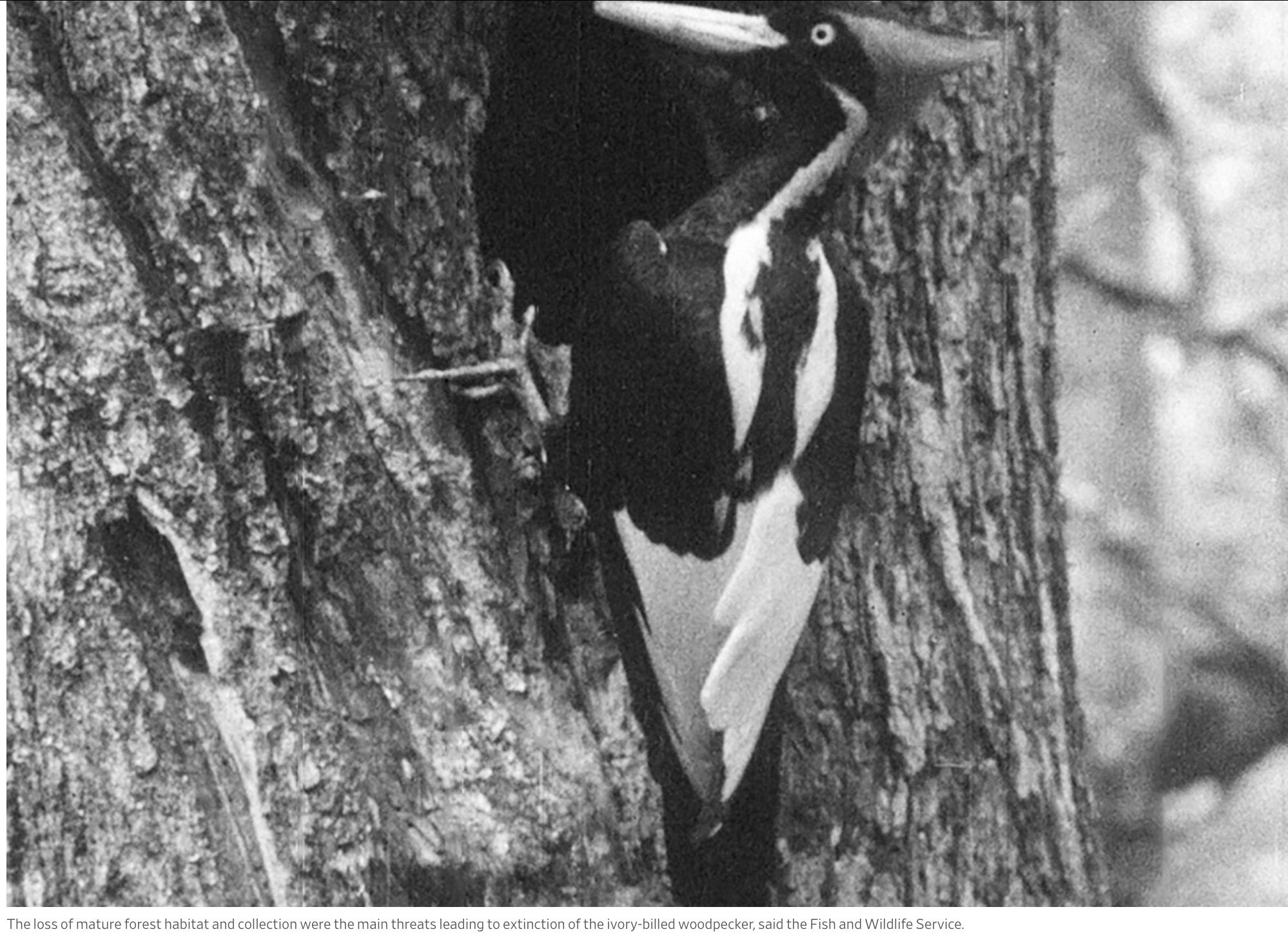
The ivory-billed woodpecker was last seen in 1944 in Louisiana and was listed as endangered in 1967. One of America’s largest woodpeckers, the bird has black and white feathers on its body and red feathers on the top of its head. The Fish and Wildlife Service said the loss of mature forest habitat and collection were the main threats leading to its extinction.
Freshwater Mussels
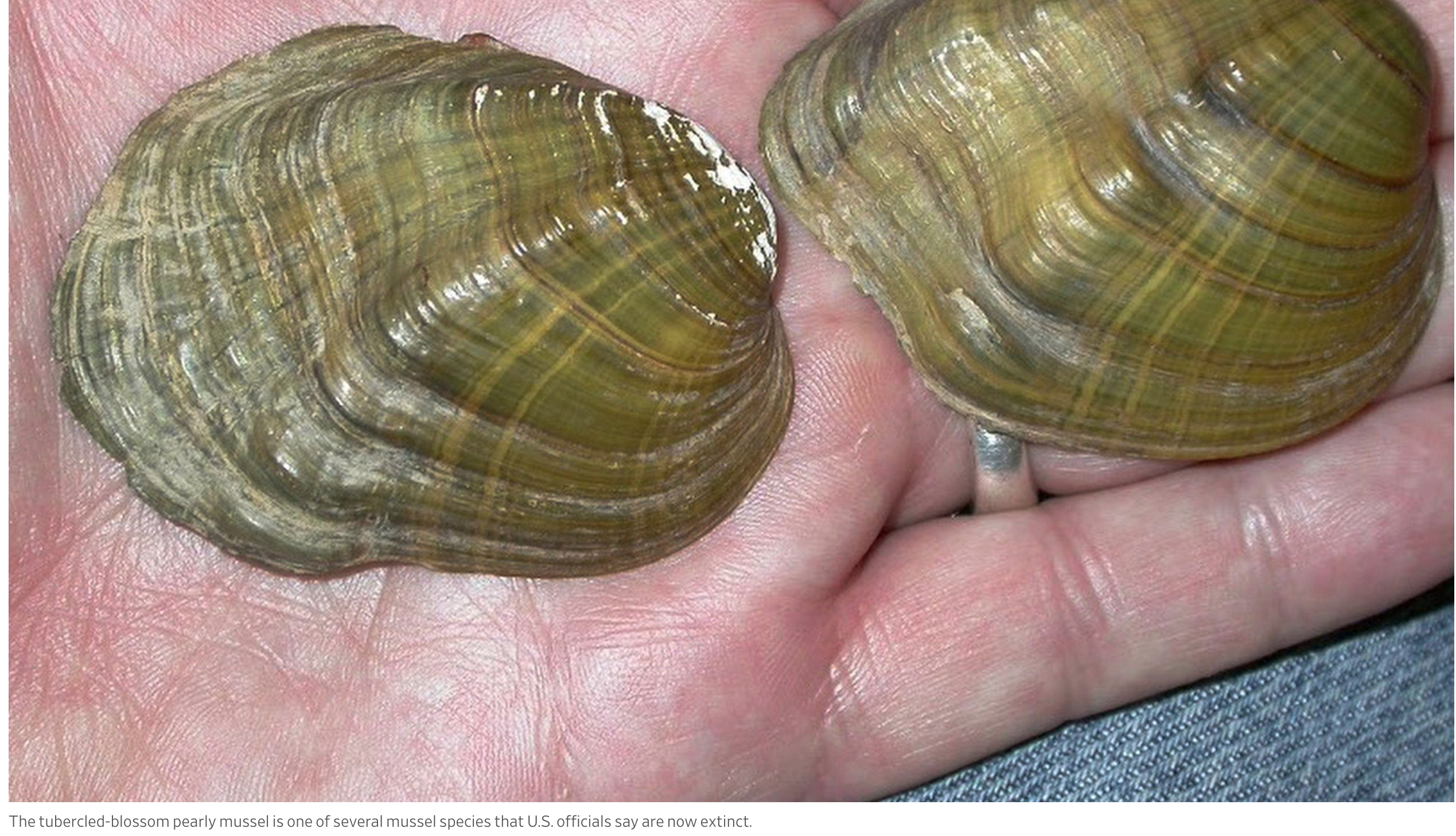
The Fish and Wildlife Service determined the flat pigtoe, southern acornshell, stirrupshell, upland combshell, green-blossom pearly, turgid-blossom pearly mussel, yellow-blossom pearly mussel and tubercled-blossom pearly mussels are all extinct. Many of these mussels were last seen in the 1960s, ’70s and ’80s and were often found in the Southeast U.S.
Bachman’s Warbler
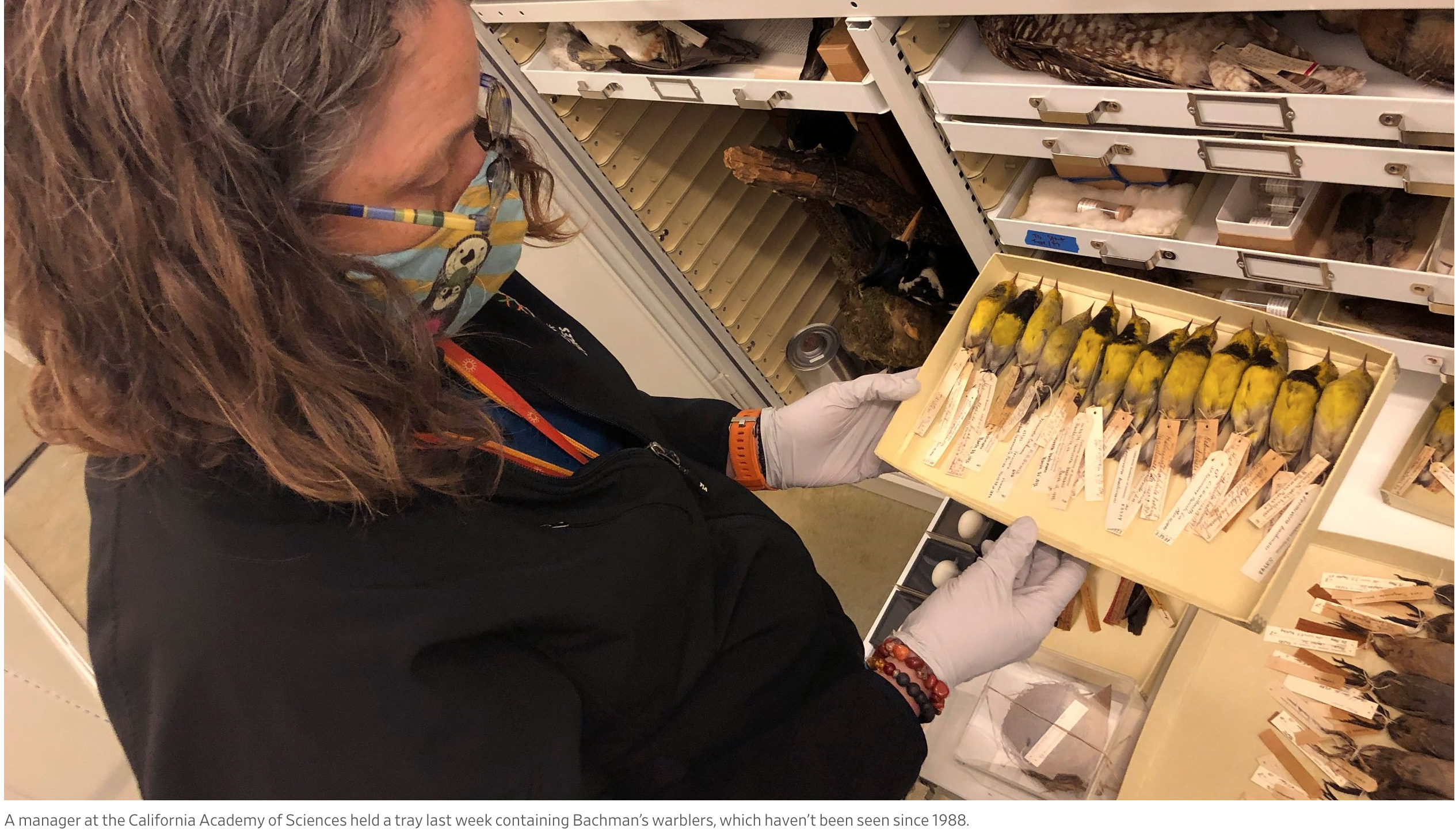
The Bachman’s warbler, at one time found in Florida and South Carolina, was listed as endangered in 1967. The last confirmed sighting of the small black and yellow bird was in 1988.
San Marcos Gambusia
The San Marcos gambusia, which earlier could be found in Texas, was last seen in 1983. The small fish, which is about one-inch long, was listed as endangered three years before that.
Little Mariana Fruit Bat
The Little Mariana fruit bat used to be found in Guam and was listed as endangered in 1984. The last confirmed sighting of the bat, which is less than 10 inches long and can weigh less than 1 pound, was in 1968. Another species from Guam listed by the Fish and Wildlife Service as extinct is the bridled white-eye bird, which was listed as endangered in 1984 and last seen the year prior.
Hawaiian Birds
The yellow Kauai akialoa bird, which has a long, curved beak that points downward, was last seen in 1969. It was listed as endangered two years before that.
Other birds from Hawaii listed as extinct are the Kauai nukupuu, the Kauaʻi ʻōʻō, the large Kauai thrush, the Maui ākepa, the Maui nukupuʻu, the Molokai creeper and the po`ouli. The plant known as phyllostegia glabra var. lanaiensis was also listed as extinct.
Hawaii and the Pacific islands are home to more than 650 animal and plant species that are listed as endangered, according to the U.S. Fish and Wildlife Service.
Updated: 10-11-2021
The Tiger Is Making A Tentative Comeback In China’s North

After decades of environmental degradation related to growth, the big cats were functionally extinct. Now the numbers have started to climb.
A century ago, some 500 tigers roamed the vast plains of northeastern China, on its border with Russia and Korea. By 1998, decades of economic expansion, poaching and human encroachment had reduced the population to just seven known individuals—leaving them functionally extinct in a country that has long revered the large cats.
What has happened since, however, is a rare success story in the world of conservation. Over the past two decades, as tigers have been wiped out in Vietnam, Laos, Cambodia and southern China, the number in northeastern China, the last corner of the country where the wild felines still roam, has climbed to as many as 55.
That is a “dramatic recovery,” according to a recent study by Chinese scientists, the World Wildlife Fund and the Wildlife Conservation Society.
Credit rising awareness of environmental protection among the Chinese public and fresh efforts by government authorities, who after decades in which economic growth trumped all other considerations have turned some of their focus to air pollution, carbon emissions and environmental degradation.
The Amur tiger, known colloquially as the Siberian tiger, has benefited from increased antipoaching efforts, the removal of thousands of tiger snares and greater protection of its habitat.
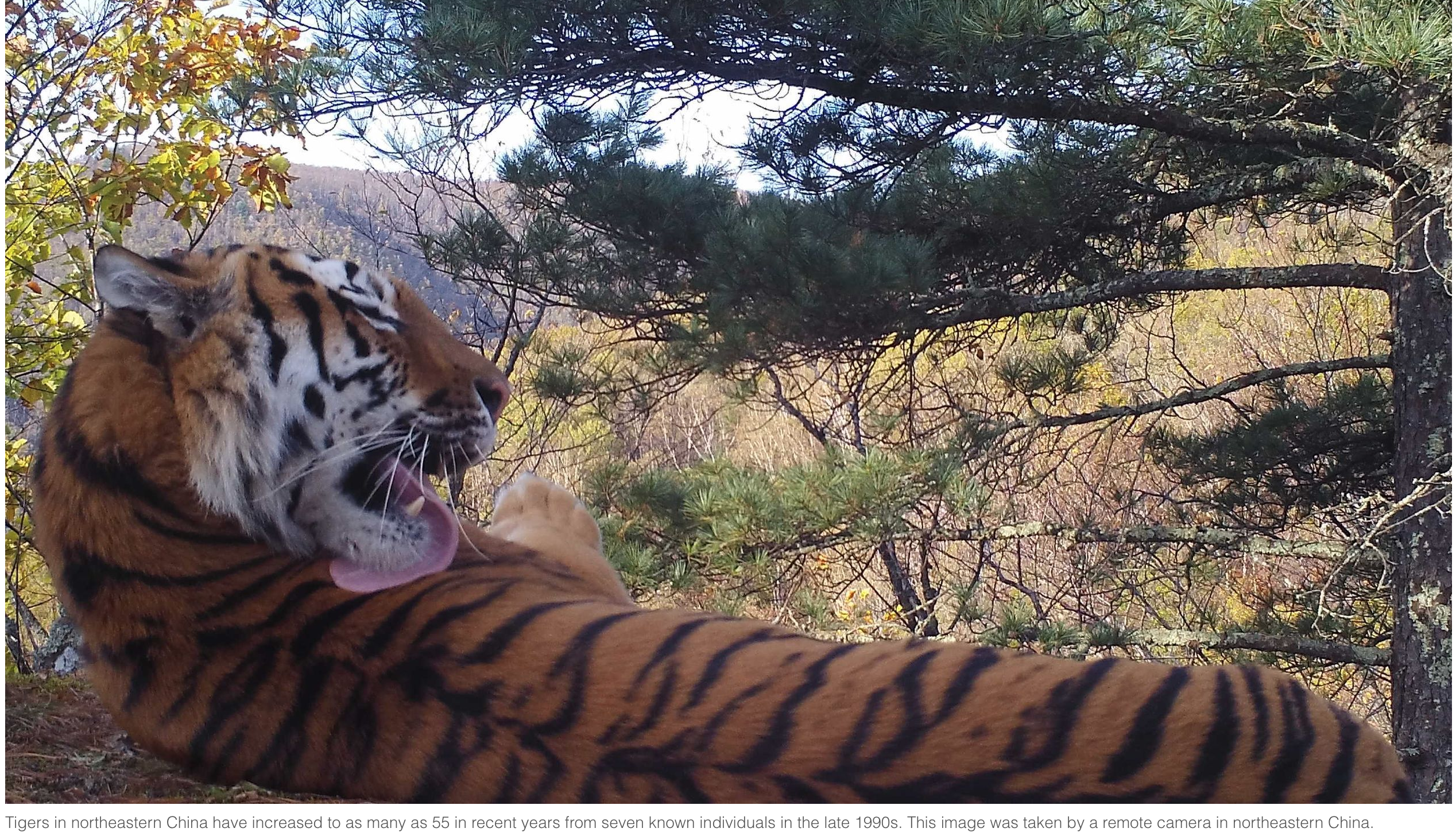
This week China will host its first major United Nations environmental conference, which will include an address from leader Xi Jinping, who has made an exhortation to protect China’s “clear waters and green mountains” one of his signature slogans.
Though the first half of the U.N. Biodiversity Conference was moved online because of the Covid-19 pandemic, delegates will gather in person in April for the second half in the southwestern city of Kunming.
On Friday, China said in a policy paper that it would give priority to nature protection and had set aside 1 million square miles of territory as “priority areas for biodiversity protection.”
China continues to be the world’s largest emitter of greenhouse gases, an issue that will come into focus as world leaders gather in Glasgow this month to discuss climate change.
Other concerns for conservationists include China’s voracious demand for commodities such as palm oil, soybeans and timber, which has contributed indirectly to the devastation of forests in countries including Indonesia and Brazil.
China’s Belt and Road Initiative has helped to fund coal-fired power plants and other infrastructure projects in other countries, which some say degrade the environment. And demand in China is one of the largest drivers of the global illicit wildlife trade.
As China becomes more prosperous and shifts its attention to improving its quality of life, authorities have in recent years significantly reduced air pollution in many of the biggest cities and boosted its once-endangered populations of Tibetan antelopes and Asian elephants in addition to the better-known efforts regarding the giant panda.
The country has also taken steps to protect its coastal wetlands and mangroves, efforts that have helped restore the diversity of migratory bird populations, said Rose Niu, chief conservation officer at the Paulson Institute, a Chicago-based think tank focused on building U.S.-China ties.
China’s focus on conservation can be seen in the fortunes of the tiger, an animal that has historically had significant cultural resonance in the country—but has also been heavily poached for its parts and their purported medicinal properties.
Globally there are some 4,000 tigers estimated to be living in the wild—down from some 100,000 a century ago. More than half are in India, while some subspecies, such as the South China tiger, exist only in captivity.
When the American conservationist Dale Miquelle first surveyed the Amur tiger population in northeastern China in 1998, he and colleagues came to the conclusion “that tigers were essentially already lost in China.”
More recently, Mr. Miquelle said, changing attitudes in Beijing toward conservation have sparked a flurry of measures, including the curtailing of timber harvesting and increased antipoaching efforts, which have made him hopeful that the increase in the tiger population will prove durable.
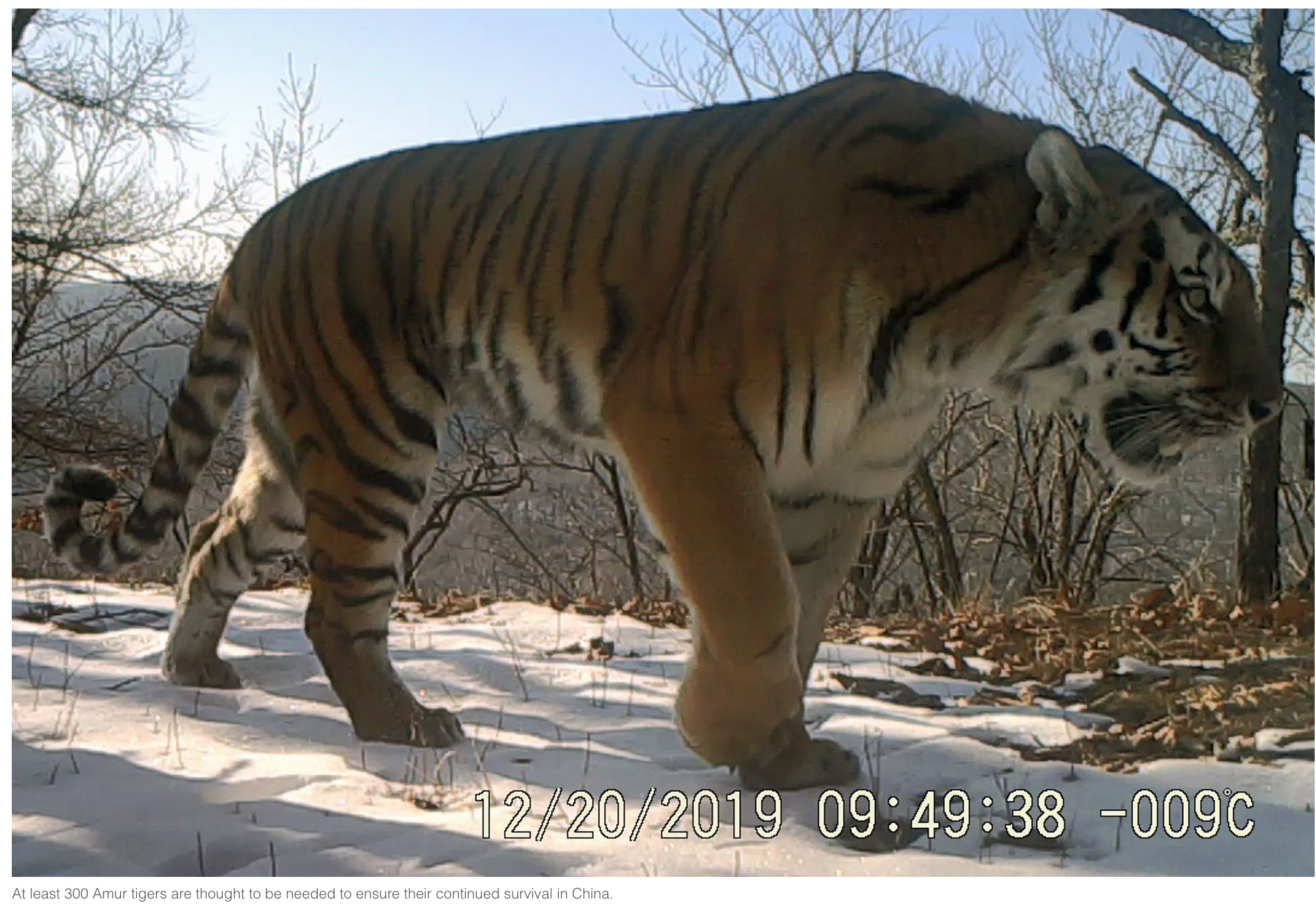
“This is an example where the economics and politics have aligned with conservation priorities in a very positive way,” said Mr. Miquelle, who runs the Wildlife Conservation Society’s tiger program from his base in the Russian village of Terney, not far from the border with China.
The establishment of a park for tigers and leopards along the border with Russia in 2017—the world’s largest protected area for tigers—has provided room for the large cats to roam more freely, he said.
Mr. Miquelle and others said reaching a target of at least 300 Amur tigers needed to ensure their continued survival in China will depend on a number of factors.
A priority will be setting aside of enough habitat—and enough prey, in the form of red deer and wild boar—to sustain a fast-growing number of predators, while protecting human and tiger populations from one another.
In China, public environmental awareness is growing. This year a herd of wild elephants captivated China’s public with a monthslong journey from their longtime home, not far from Kunming, and stirred concern about a long march that scientists and Chinese state media attributed to the destruction of the elephants’ habitat.
Also critical will be a halt to poaching and curbs on consumer demand for tiger parts—part of an annual global wild-animal trade that the U.N. has valued at as much as $10 billion.
China is the world’s largest market for tiger bones and other parts such as teeth, eyes and whiskers, which are believed to cure a range of physical ailments and are increasingly sought-after for their scarcity and value.
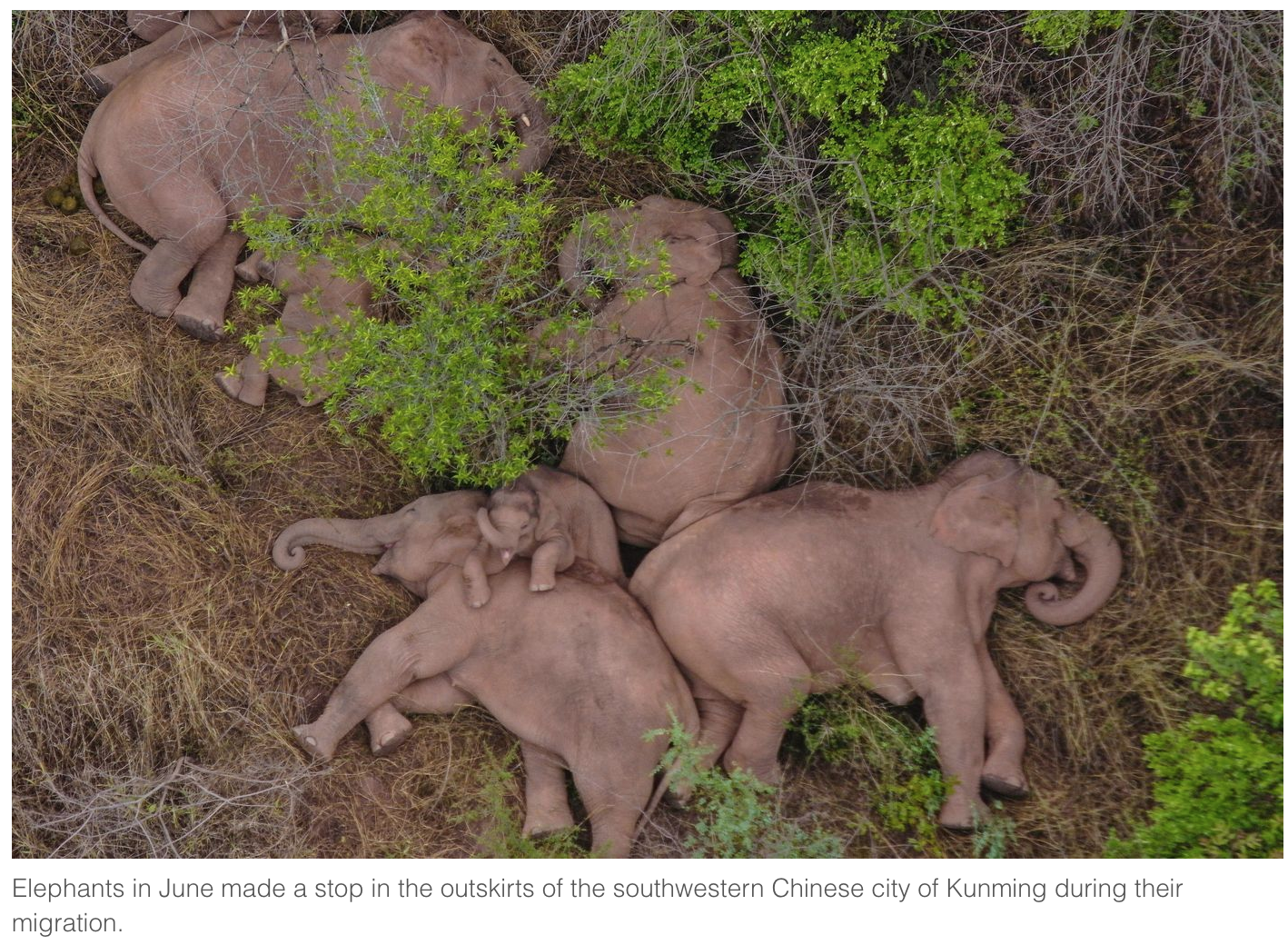
Beijing is partly interested in targeting poaching because of its ties to organized crime, with many of the same traffickers and smugglers of drugs and humans linked to the wild-animal trade, said Jennifer Turner, director of the China Environment Forum at the Wilson Center in Washington, D.C.
The outbreak of Covid-19 and the spotlight it put on China’s wild-animal trade have pushed Beijing to tighten its restrictions on wildlife farming, she said, though geopolitical tensions regarding the origins of the pandemic have hampered those efforts.
Despite the recent increase in China’s tiger population, “These animals are on the edge,” said Sharon Guynup, author of a book, “Tigers Forever: Saving the World’s Most Endangered Big Cat.”

“It wouldn’t take much…One disaster, one epidemic, one cyclone, one massive fire,” she said. “Whether it’s seven or 55, they could disappear in a blink.”
Updated: 10-13-2021
Species Loss Leaves Humans Poorer In Every Way
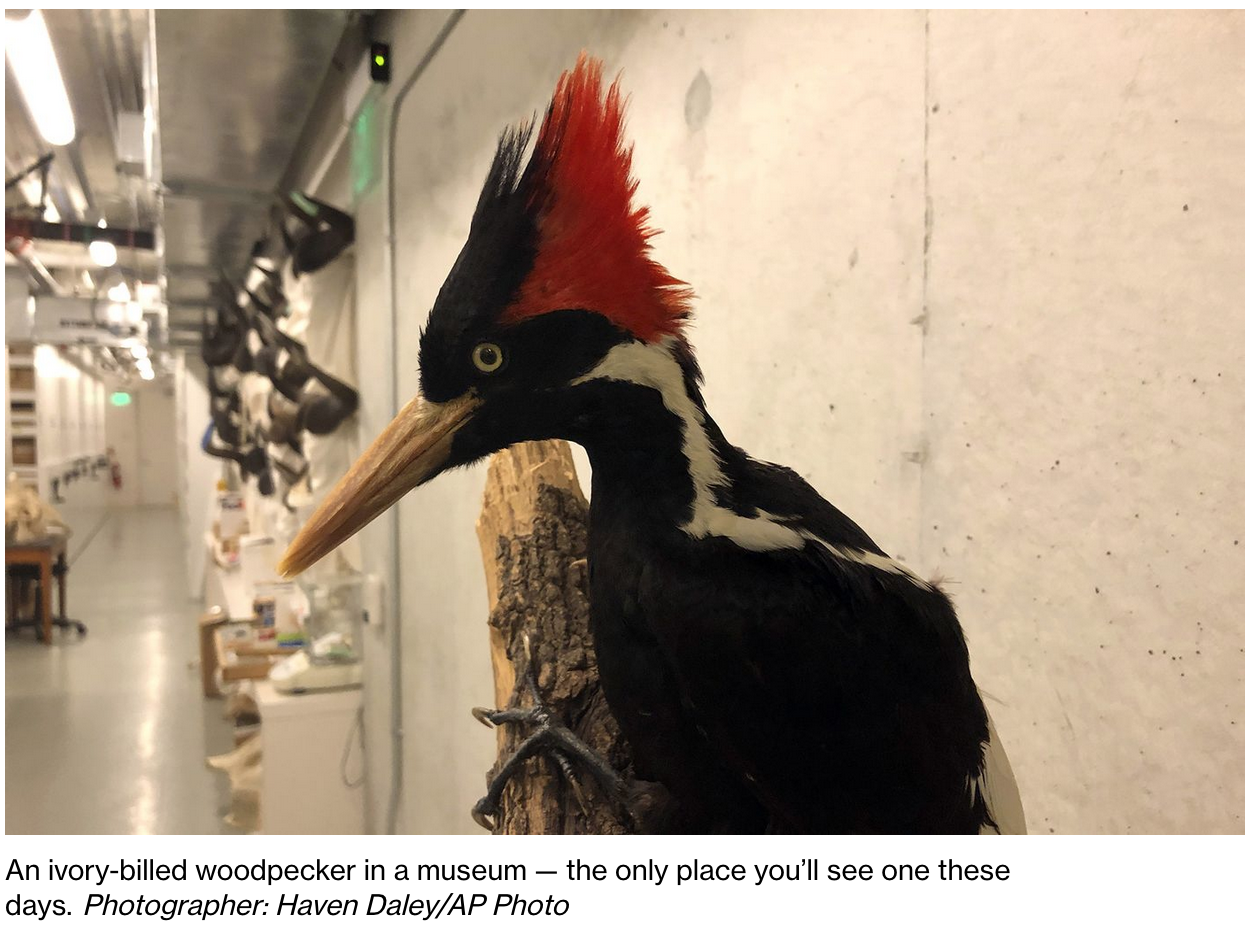
Nearly two dozen species are gone forever, a U.S. agency recently said. Our actions will determine how many more meet the same fate.
They called it the “Lord God Bird,” because onlookers couldn’t help yelping when they saw it: “Lord God, what a bird!” The ivory-billed woodpecker, which dwelled in the swamp forests of the American South, sent bird lovers into raptures for centuries.
But as those old-growth forests disappeared over the years, so did the birds. Scientists, conservationists and admirers spent decades seeking them out — but all, it seems, in vain.
The ivory-billed woodpecker was one of 23 endangered species the U.S. Fish and Wildlife Service recently said have disappeared forever.
The world can expect many more such grim announcements. As many as 1 million species are at risk of extinction worldwide, according to the latest, most comprehensive global biodiversity assessment, due largely to human-driven habitat loss and climate change.
The warning signs are glaring: In the U.S., salmon stocks in the Yukon River have collapsed, creating an economic emergency in western Alaska.
Off the Gulf Coast, stocks of Atlantic bluefin tuna have halved since 1980. The American bumble bee could soon be named an endangered species.
The cause is us. Humans have increased the extinction rate by a thousandfold; many scientists believe we are living through a global mass extinction as profound, in its own way, as the one that befell the dinosaurs. But if humans are the problem, we can also be the solution.
The same report that saw up to 1 million species on the verge of extinction also suggested an abundance of policy fixes: adopting sustainable agricultural practices, expanding protected areas, greening infrastructure, and more.
There’s every reason to act. Biodiversity offers beauty and spiritual solace. And it’s valuable in hard economic terms, as well. The OECD has calculated that the services biodiversity provides to the world — such as pollinating crops, purifying water, and storing carbon — are worth up to $140 trillion a year.
Conservation efforts haven’t been useless. The U.S. Endangered Species Act didn’t save the ivory-billed woodpecker, but only a tiny fraction of the 2,200 species it has protected have actually gone extinct.
Many have been brought back from the brink — most famously the bald eagle, which rebounded from a low of about 400 breeding pairs in the mid-20th century to a population of roughly 350,000 today. Global conservation efforts have had similarly partial but real success.
Yet the status quo isn’t good enough. The global push to formally protect 30% of the earth’s land and sea by 2030 — a goal U.S. President Joe Biden aims to meet — is appropriately ambitious.
New conservation efforts should also be paired with aggressive action to fight climate change, a key driver of species loss. The timing to underline the connection is right: Global leaders will meet at crucial climate summit at the end of this month.
Could sea otters, gorillas and polar bears go the way of the ivory-billed woodpecker, existing only in natural history museums? How will the world grow crops if still more pollinators disappear?
The people of this planet can leave their children a world rich in biodiversity — or one that’s strained, depleted, and poorer in every way. It isn’t too late to make the right choice.
Updated: 10-22-2021
A Groundbreaking Tardigrade Fossil Discovery Offers Clues To Our Past
Researchers have discovered the third-ever tardigrade fossil on record. Understanding the tiny creature’s developmental history is critical for unpacking important evolutionary milestones that have shaped thousands of species across the planet.
Updated: 10-23-2021
The Bumblebee’s Plight: Why It Is Disappearing In The U.S.
Efforts are under way to save the biologically important species after the American bumblebee declined precipitously across the country.
The American bumblebee was once the most commonly observed bumblebee in the U.S. Like 11 other bumblebee species, its population has plummeted.
Nationally, it has declined about 89% in the past 20 years, according to the International Union for Conservation of Nature.
The species has vanished from at least eight states, mostly in the Northeast, according to the Center for Biological Diversity, a nonprofit environmental organization.
In February, the center, along with the Bombus Pollinators Association of Law Students of Albany Law School, filed a petition with the U.S. Fish and Wildlife Service requesting that the American bumblebee be listed under the Endangered Species Act.
The species, once common across the U.S., has seen particularly steep declines in the north. The petition lists 16 states that have seen declines of more than 90% in bee populations. Another 11 have seen declines of more than 70%.
Bumblebees are generalists, meaning they can pollinate a large range of flowers, helping to support diverse ecosystems. The American bumblebee serves as a pollinator for clover, St. John’s wort, Goldenrod and other wildflowers. It also helps pollinate commercial crops.
The petition points to farm chemicals, habitat loss, disease and climate change as reasons for the decline. U.S. government reports have cited similar factors.
Fields, grasslands and meadows provide prime habitat for the bees. Areas lost to development or agriculture reduce food sources and nesting sites. Herbicides designed to kill weeds can waft off farms, harming wildflowers the bees need for sustenance.
The combined effects of insecticides, fungicides and other chemicals applied to crops might have significant effects on the health of the species, according to Jess Tyler, staff scientist at the Center for Biological Diversity.
Chris Novak, president and CEO CropLife America, an agrochemical trade group, says farming practices are less responsible for the bee’s decline.
“The petition’s claims regarding changes in where the American bumblebee is found don’t appear to be consistent with agriculture as a significant factor,” he said.
Infectious diseases are contributing to the species’ decline, according to Rich Hatfield, a senior conservation biologist at the Xerces Society for Invertebrate Conservation, a nonprofit organization.
Commercially raised bumblebees are used to pollinate crops, often in greenhouses. The bees can escape and spread pathogens to wild bees.
On Sep. 29, the U.S. Fish and Wildlife Service issued a finding that listing the American bumblebee under the Endangered Species Act might be warranted, initiating a process to evaluate threats to the species. The agency will decide next year.
If the species is listed under the Endangered Species Act, a variety of measures could be taken to reverse its decline.
The Fish and Wildlife Service can designate “critical habitat” for an endangered species: areas that contain food sources, nesting sites and other features essential for its survival. Federal agencies are required to avoid activities that would damage or destroy these areas.
Bee populations could be restored by creating more suitable habitat, such as buffer zones of wildflowers around farms, said Jess Tyler of the Center for Biological Diversity.
An Endangered Species Act listing could result in other changes to farming practices. Mr. Tyler hoped it would lead to more regulation of pesticides.
A multipronged approach would be best, according to Keith Hirokawa, an environmental law professor at Albany Law School.
“No one feature of the Endangered Species Act is the be-all-end-all,” he said.
Some of these conservation measures might pay off in the end. “Farmers have an interest in keeping pollinators around,” said Mr. Hatfield of the Xerces Society. “They provide an essential service for free.”
Updated: 12-26-2021
Louisiana Researchers ID 14 New Shrew Species On Sulawesi
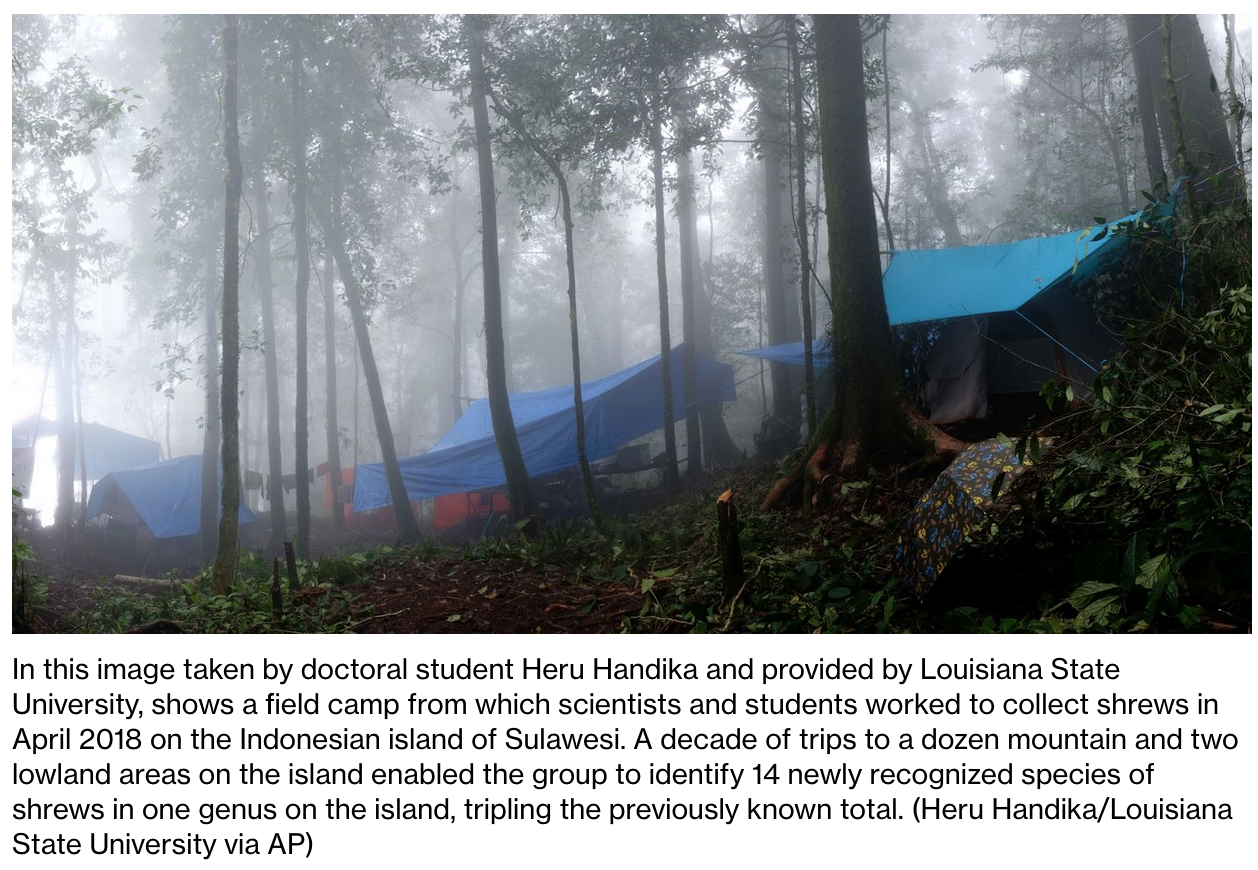
Louisiana researchers have identified 14 new species of shrews on an Indonesian island where seven in that genus were previously known.
There were so many and some look so similar that after a while Louisiana State University biologist Jake Esselstyn and his colleagues began hunting for Latin words meaning “ordinary.”
“Otherwise I don’t know what we would have named them,” said Esselstyn, who also named the seventh known species of the pointy-nosed insect-eating mammals on the island of Sulawesi.
That’s why shrews whose species names mean such things as “hairy-tailed” and ”long” have been joined by “Crocidura mediocris,” “C. normalis,” “C. ordinaria,” and “C. solita” — the last of those meaning “usual.”
The 101-page paper will be “super valuable for all current and future students of mammal biodiversity,” said Nathan S. Upham, assistant research professor at Arizona State University’s School of Life Sciences and lead creator of the American Society of Mammalogists’ online Mammal Diversity Database.
He was not involved in the study, which was published Dec. 15 in the Bulletin of the American Museum of Natural History and also involved researchers from the Indonesian Institute of Sciences, Museums Victoria in Australia, and the University of California.
It’s been 90 years since this many new species were identified in one paper, Esselstyn said. The 1931 paper by George Henry Hamilton Tate identified 26 possible new species of South American marsupials, but 12 were later found not to be separate species for a total of 14 new ones, he said.
Esselstyn led a decade of trips to the Indonesian island of Sulawesi to collect the animals, which are relatives of hedgehogs and moles.
All weighed less than a AA battery, ranging from about 3 grams — just over one-tenth of an ounce, or about the weight of a pingpong ball — to about 24 grams (0.85 ounces). The largest species had bodies averaging 95 millimeters, or about 3.7 inches long.
At the start, he was hoping to clarify how the six species then known in the genus Crocidura had developed. “I was interested in questions about how shrews interacted with their environment, with each other, how local communities were formed,” he said.
But he quickly realized that species had been sorely undercounted.
“It was overwhelming because for the first several years, we couldn’t figure out how many species there were,” he said.
Five had been identified in 1921 and a sixth in 1995. Esselstyn’s team identified the seventh species, the hairy-tailed shrew, in 2019.
For this paper, they examined 1,368 shrews, more than 90% of them collected by Esselstyn’s group, which trapped the animals on a dozen mountain sites and two in the lowlands of Sulawesi.
The island is shaped rather like a lower-case letter k with the top of the stem bent sharply eastward.
That odd shape has contributed to species diversity, Esselstyn said. “There are consistent boundaries between species … whether you’re looking at frogs or macaques or mice. It suggests some sort of shared environmental mechanisms.”
Researchers have found at least seven such zones — roughly, the island’s central mass, the three “legs” of the k, and three zones on the long bent neck.
Genetic analysis may indicate how long ago or recently similar species split apart and whether they’ve been in regular contact with each other since then, Esselstyn said.
“It’s a difficult problem. But I think we can do it now that sequencing genomes is relatively low-cost,” he said. “A few years ago we couldn’t have done it but it’s relatively feasible now.”
Updated: 2-4-2022
The 20 Animal Species That Could Rewild The World

Reintroducing mammals like gazelles, tigers and bears to their former habitats would boost biodiversity and help the landscape store more carbon, new research finds.
Reintroducing just 20 large mammal species to their historic habitats could boost biodiversity across a broad swathe of the planet while helping to stabilize the climate, according to a new study.
“Solving the biodiversity crisis and the climate crisis is not only necessary, they’re mutually reinforcing,” said Carly Vynne, a conservation biologist and lead author of the paper published Jan. 27 in the journal Ecography.
That’s because biodiverse ecosystems are both more resilient to climate change and store more carbon dioxide from the atmosphere, research has shown.
Yet climate change is exacerbating what some scientists call “the sixth great extinction.” The United Nations in 2019 warned that “nature is declining globally at rates unprecedented in human history” with a million species at risk of vanishing.
Predators and other large animals are landscape architects, influencing the growth of carbon dioxide-absorbing vegetation.
Scientists have documented, for instance, how the return of gray wolves to Yellowstone National Park in 1995 reshaped the ecosystem by keeping plant-munching elk populations in check.
That has allowed willows and other trees to flourish, resulting in growing numbers of beaver and bison.
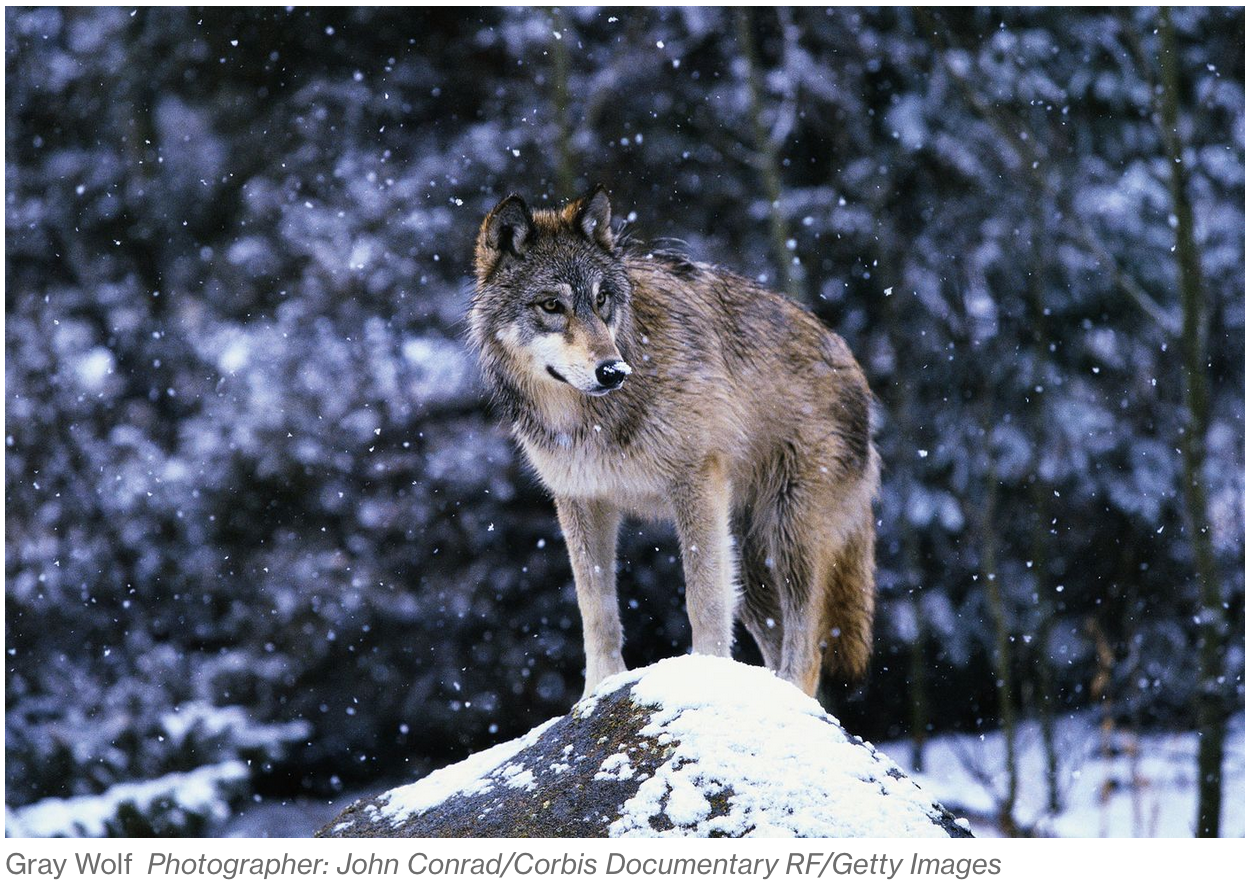
“Large herds of mammals are themselves also carbon storage basins,” said Vynne.
Scientists have calculated that restoring densities of predators worldwide could result in landscape changes that could sequester 23 gigatons of atmospheric carbon.
From 298 Species To 20
Vynne and a team of researchers identified 298 large mammal species and their ranges, analyzing satellite data to determine the presence of suitable habitat in 730 terrestrial ecoregions. An ecoregion is a conservation planning tool that identifies similar plant and animal communities in a particular area.
The scientists then focused on ecoregions that were missing just one to three large mammal species that historically had occupied more than 80% of the area, reasoning it would be feasible to reintroduce those animals within five to 10 years.
They whittled down the list of large mammals to the 20 that would have the most impact, triggering the complete restoration of large animal clusters over 54% of the world’s landmass.
Seven of the species are predators, such as jaguars, wolverines and cougars, and 13 are herbivores such as pampas deer, hippopotamuses and gazelles. The animals are found on five continents and reintroducing them would expand the range of nine threatened species, according to the study.
Bringing back the Eurasian beaver, European bison, reindeer and wolf to Europe, for instance, could dramatically expand the range of complete collections of large animals.
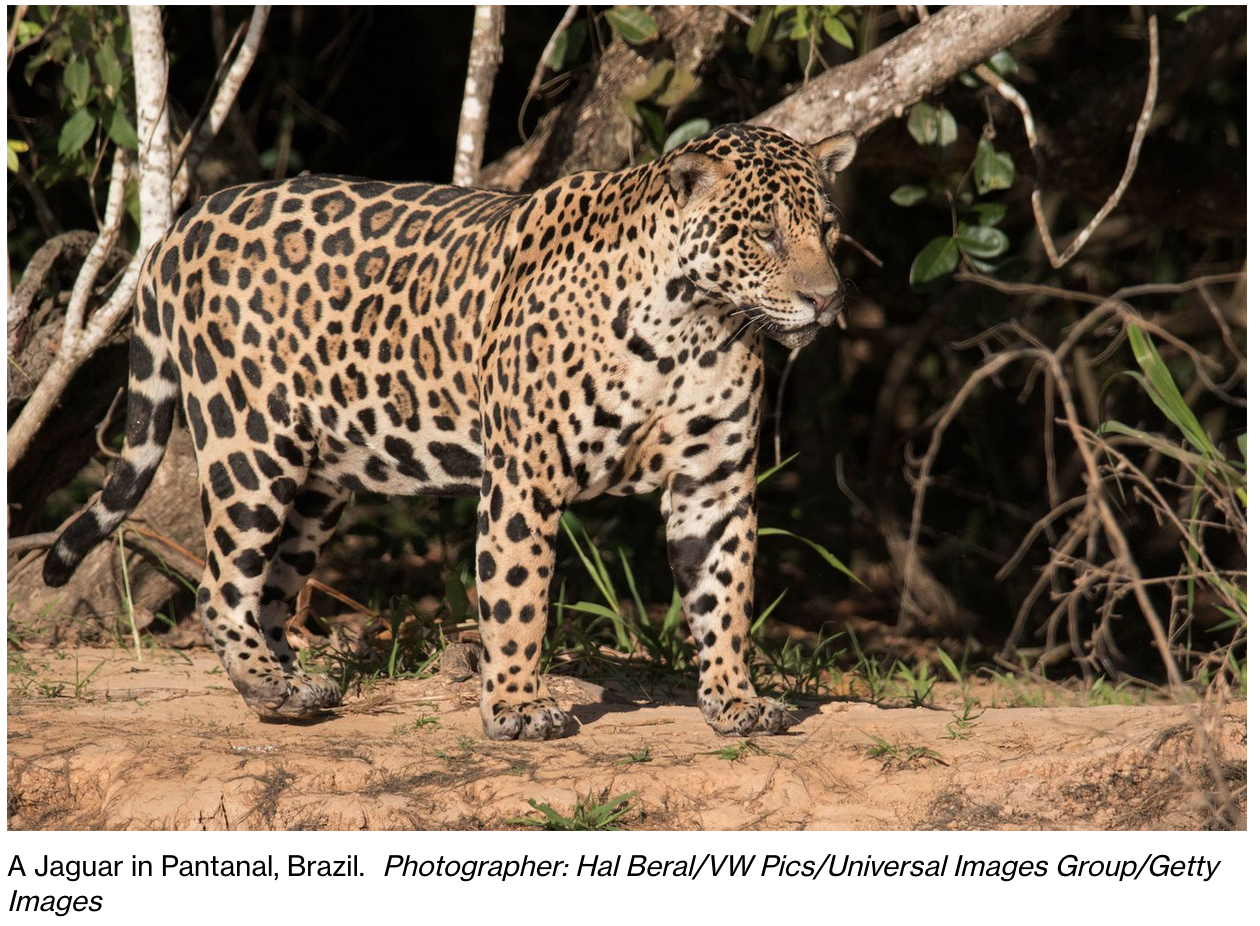
Predator Problems
Reintroducing predators, though, can be politically fraught. The return of the gray wolf in the United States has led to decades of conflict over the predators’ killing of livestock.
Wildlife ecologist Euan Ritchie, a professor at Deakin University in Melbourne, Australia, who was not involved in the research, said the paper’s prioritization of animals to reintroduce was valuable. “I think it’s really important to be aware of where there are gains to be potentially had in bringing species back.”
However, restoring animals long gone from an ecosystem is challenging. “There’s a number of complexities when you’re talking about large carnivores in particular,” said Ritchie. “They need suitable prey so you might need to restore prey as well as predator populations at the same time.”
Predators also roam over large territories and may cross local and national borders, requiring cooperation among governments and landowners.
“It’s definitely not a case of just grabbing some large carnivores or herbivores and plugging them back into the ecosystem,” said Ritchie. “There’s a lot of thought that will need to go into this.”
Updated: 3-9-2022
Woolly Mammoth Revival Raises $75 Million From VC Firms, Paris Hilton
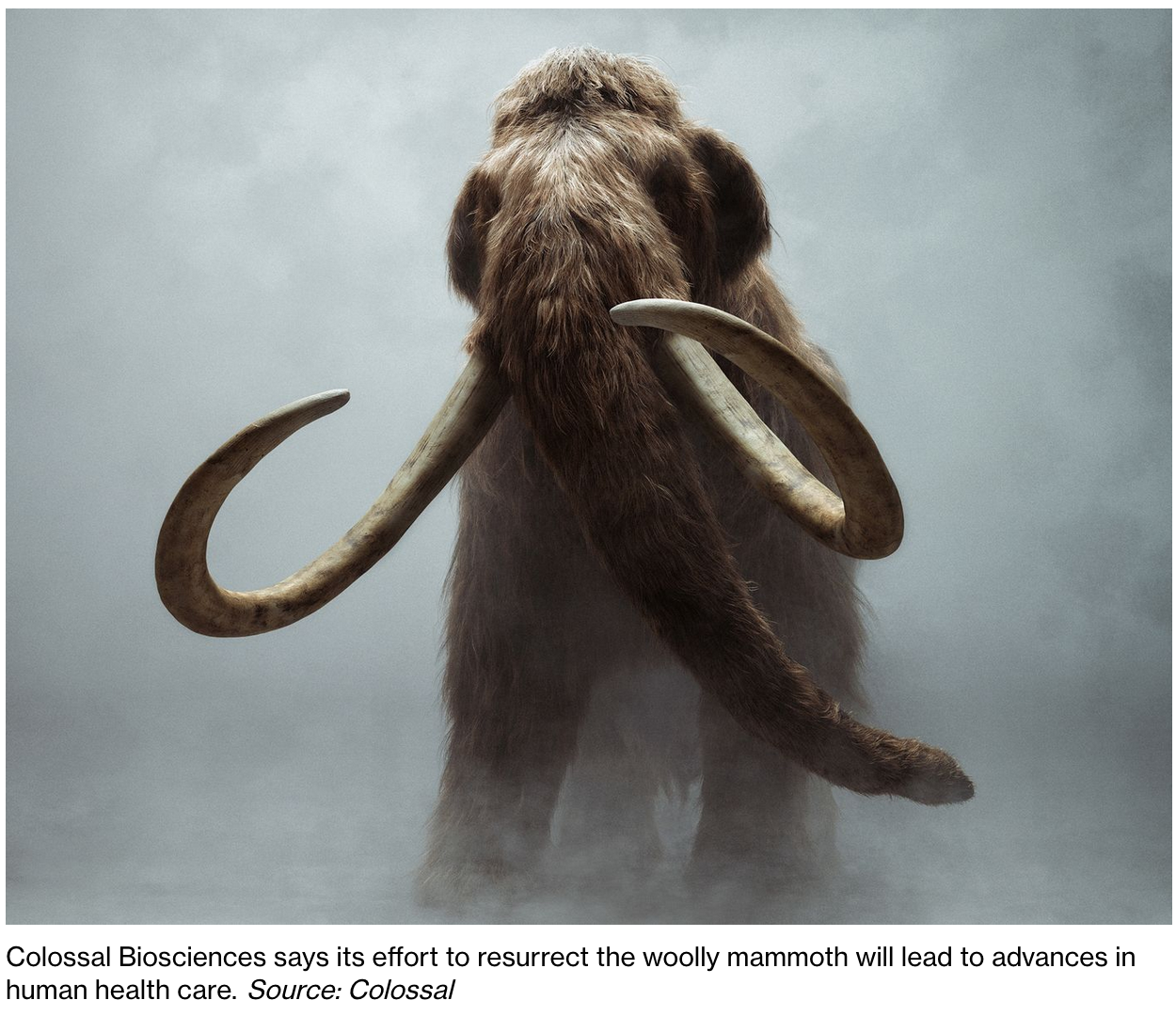
Resurrecting the extinct creatures could slow climate change, according to a bioscience startup, but investors are keen to see human applications for the genetic research.
A Dallas company trying to use ancient genetic material to create modern-day versions of woolly mammoths — a quest aimed at fighting climate change and advancing health care — has raised $75 million from venture capitalists, the billionaire producer of “Jurassic World” and Paris Hilton.
Harvard University geneticist George Church and technology entrepreneur Ben Lamm launched Colossal Biosciences in September with $15 million in seed funding.
Just six months later, Colossal has raised another $60 million for the plan, despite the skepticism of some scientists.
“I’m all in on mammoths,” said Lamm, speaking over Zoom from Dallas, where multiple models of the prehistoric beast stood on the bookshelf behind him.
“It’s like the cuddly version of a velociraptor,” said Church, who was also on the call. “They’re vegetarian, they’re not threatening.” Church sees a future where tens of thousands of mammoths roam the northern tundra of Russia, Canada and Alaska.
The Colossal-created animals would combine genetic material from modern-day Asian elephants with that of mammoth DNA frozen into ice and preserved for thousands of years.
The mammoths, or “Arctic elephants,” as Church refers to them, would hopefully slow climate change in a few ways.

Church pictures herds of mammoths stomping down deep snow that insulates the ground, allowing the intense cold of winter to reach the permafrost so it can refreeze instead of melting away and releasing huge amounts of carbon dioxide.
He expects the mammoths would also knock down trees, clearing the way for other large animals to follow along and pack down more snow.
Entire landscapes could be transformed from forest into grassland, which Church said is more efficient at photosynthesis and sequestering carbon — although the science on that isn’t always straightforward.

To be sure, some environmental experts have questioned Colossal’s plan. The idea of resurrecting an extinct animal is so uncertain, and its potential effect on climate change so hard to predict, that it’s not a worthwhile tactic for addressing the enormous problem, said Carleton University conservation science professor Joseph Bennett.
Colossal has attracted an eclectic mix of investors. Peter Thiel gave Church $100,000 in 2015, years before he and Lamm founded Colossal.
For Colossal’s seed round of funding last year, investors included established venture capital firms Breyer Capital and Draper Associates, along with Winklevoss Capital and motivational speaker Tony Robbins.
The recent round of funding announced Wednesday was led by green venture firm At One Ventures and billionaire Thomas Tull, the founder and chief executive of Tulco LLC. Tull is also the founder and former chief executive of Legendary Entertainment.
Paris Hilton, the hotel heiress who’s recently become “obsessed” with non-fungible tokens, was another named investor.
Colossal’s long-term plan to make money doesn’t rest on mammoths, however.
The company’s other research, in fields ranging from genetic engineering to computational biology, could yield advances in fighting human diseases or genetic abnormalities — and Colossal has made progress over the past six months on research with commercial applications, said Lamm, who founded and sold several technology businesses to the likes of Accenture Plc and Zynga Inc. before he partnered with Church.
“The mammoth captures people’s imaginations, but for me, it’s more about the technology they’re developing,” said Tull, the Colossal investor who produced movies including “The Hangover,” “The Dark Knight” and “Jurassic World.” “Some of the things they’re working on could really help people.”
Updated: 3-29-2022
Prehistoric Human Remains Found At Miami Luxury-Condo Site
Find could cause delays, modifications to Baccarat-branded tower project by developer Related Group.
Archaeologists have discovered prehistoric human remains, ceremonial artifacts and possibly the footprint of an ancient dwelling on the site of a planned 75-story residential condo tower in Miami, raising questions about whether the luxury project may face delays and modifications.
Related Group, one of South Florida’s largest developers, bought the 4-acre parcel in 2013 for $104 million and joined with SH Hotels & Resorts to develop a Baccarat-branded luxury tower there.
Miami building regulations require developers to check sites in certain areas for archaeological impact before breaking ground. Sometimes that process takes only a short time.
But archaeologists in April 2021 sent the city a “notice of discovery” and, since then, have been studying the Related Group site. Now they have reported that they have found human remains and post holes indicating the footprint of a prehistoric structure.
Adrian Espinosa-Valdor, the historic-preservation planner and acting city archaeologist, said the findings are evidence of a civilization known as the Tequesta that existed more than 2,000 years ago.
“One of the human remains was a cranium that was found almost 6 feet underground,” Mr. Espinosa-Valdor said in a presentation to a neighborhood group. “It was intentionally buried, perhaps ceremonial.”

A summer 2021 report from the team of archaeologists working on the site for Related Group states that the site is eligible for listing in the National Register of Historic Places.
“The site provides important data documenting prehistoric culture, subsistence, and settlement patterns in south Florida,” the report states. ”It is recommended that intact portions of the site be avoided if feasible.”
In a written statement, Related Group said it has “a long history of collaborating with local officials to carefully excavate sites and preserve archaeological finds according to current laws and practices. This is not unusual for construction projects in this area and has not delayed our development plans.”
Once the archaeological excavation is complete, the city’s Historic and Environmental Preservation Board will make a final determination based on Miami’s codes as well as guidelines from the U.S. Interior Department, according to city officials.
In the past, actions by the board have resulted in delays, modification and—in one case—cancellation.

“It’s got to be a very educated and informed decision when we’re talking about designation, and we’re still in the process of monitoring at this point,” said Anna Pernas, the preservation officer for the city, who also attended the neighborhood presentation.
Archaeological discoveries have created headaches for Miami developers in the past, sometimes sparking battles with preservationists and Native American groups.
Similar battles have played out in New York and other cities where Native American tribes and historic sites have been located.
The Tequesta civilization used to inhabit the mouth of the Miami River, which provided access by canoe west to the Everglades and east to Biscayne Bay and the barrier islands.
Today the area is home to Brickell, Miami’s financial center and one of its fastest-growing areas. “This was always valuable real estate,” says Robert Carr, an archaeologist who was hired by Related to lead the excavation.
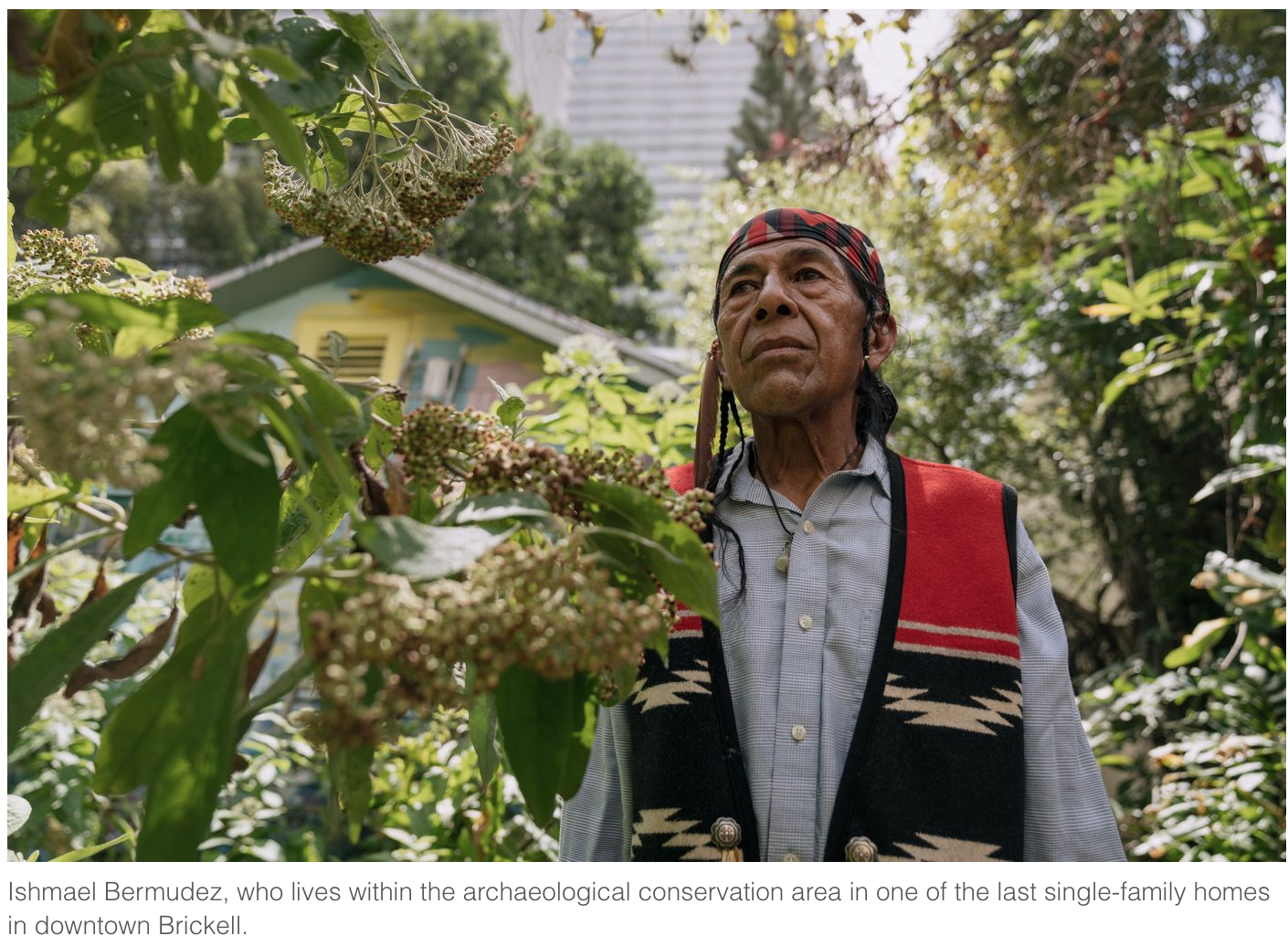
This latest discovery comes as Brickell’s condo market is skyrocketing. “Condo buildings are selling out in record time,” says Jaclyn Bild, a broker associate at Douglas Elliman. “Developers can’t build fast enough to keep up with the demand.”
In one of Miami’s best known preservation battles, archaeologists in 1998 uncovered a circle 38 feet in diameter that indicated a religious structure just across the street from the Baccarat project.
Public outcry over what became known as the Miami Circle forced the developer to sell the property to the state for more than $26 million, and it was designated a National Historic Landmark.
Partly because of lack of funding, the circle was reburied to help preserve it, and now it is mostly known as a dog park.
Some years later at the site of a $1 billion development, the footprint of an entire ancient village was discovered. In that case the developer, MDM Development Group, “spent a staggering amount of money” on the dig, to change designs and to preserve two of the circles, according to Eugene Stearns, a lawyer for MDM.

At the Baccarat site, much attention is on the half-circle that was unearthed this year, and on the human remains. As required by law, the Seminole tribe was consulted once human remains were discovered.
Related is honoring the tribe’s request that the entire site be excavated to ensure that any other human remains are recovered and reburied at a separate location, according to the city.
But not all neighbors are happy. Many are advocating that the Related site be converted into a park because Brickell is overbuilt.
The numerous developments at the mouth of the river are “an insult to the American natives,” says Ishmael Bermudez, one of Brickell’s oldest residents, who is active in the Seminole community.
He lives within the archaeological conservation area in one of the last single-family homes in downtown Brickell, and over the years has unearthed post holes and artifacts in his own backyard.
“We had some of the most beautiful ancient sites,” Mr. Bermudez says, “and these people just built right on top of them.”
Updated: 4-4-2022
Extinction Rebellion Enter Fourth Day of Protests At Esso Oil Facility
Climate change campaigners have staged a protest at an oil facility near Heathrow Airport on their fourth day of action.
Extinction Rebellion said around 30 protesters returned to the Esso West oil facility in west London at 4am on Monday as part of their campaign to urge the Government to stop using fossil fuels.
In a statement, the group said they were blocking the entrance with two bamboo structures and two large banners that said “Join Us – London 9th April” and “Stop Fossil Fuels Now”.
Since Friday, Extinction Rebellion and a second campaign group, Just Stop Oil, have staged a number of protests at oil terminals and refineries across the UK.
Over the weekend Just Stop Oil blocked oil depots in Grays, Purfleet, Buncefield, Tamworth and central Birmingham.
More than 80 people were arrested in Essex over the weekend, while 14 were held in Staines in Surrey, and six were arrested in Birmingham.
Andrew Smith, from Extinction Rebellion, said: “We’re here to say that climate action cannot wait. Right now, governments are choosing to exploit the crisis in Ukraine to hand out oil licences and continue the fossil fuel economy that’s destroying us.”
“The reality is, the UK public wants faster action on climate as the energy crisis hits. We know what is happening and what needs to be done – by acting in favour of corporate interest over the will of the people, the Government is showing contempt for the people who elected them.”
“How long ago did our Prime Minister say Cop26 was our last chance to save humanity? And now they’re sidelining climate policy once again. This is not living in reality.”
The group said further action is expected on April 9 in London’s Hyde Park.
Updated: 4-13-2022
Extinction Rebellion Activists Occupy Shell’s London Office
Climate activists from Extinction Rebellion occupy Shell Plc’s office in London and ask for a meeting with CEO Ben van Beurden.
Climate protests have taken place at fuel terminals in the U.K. this month.
Updated: 4-15-2022
Inside An Italian Police Chase To Stop The Theft Of Ugly Sea Creatures
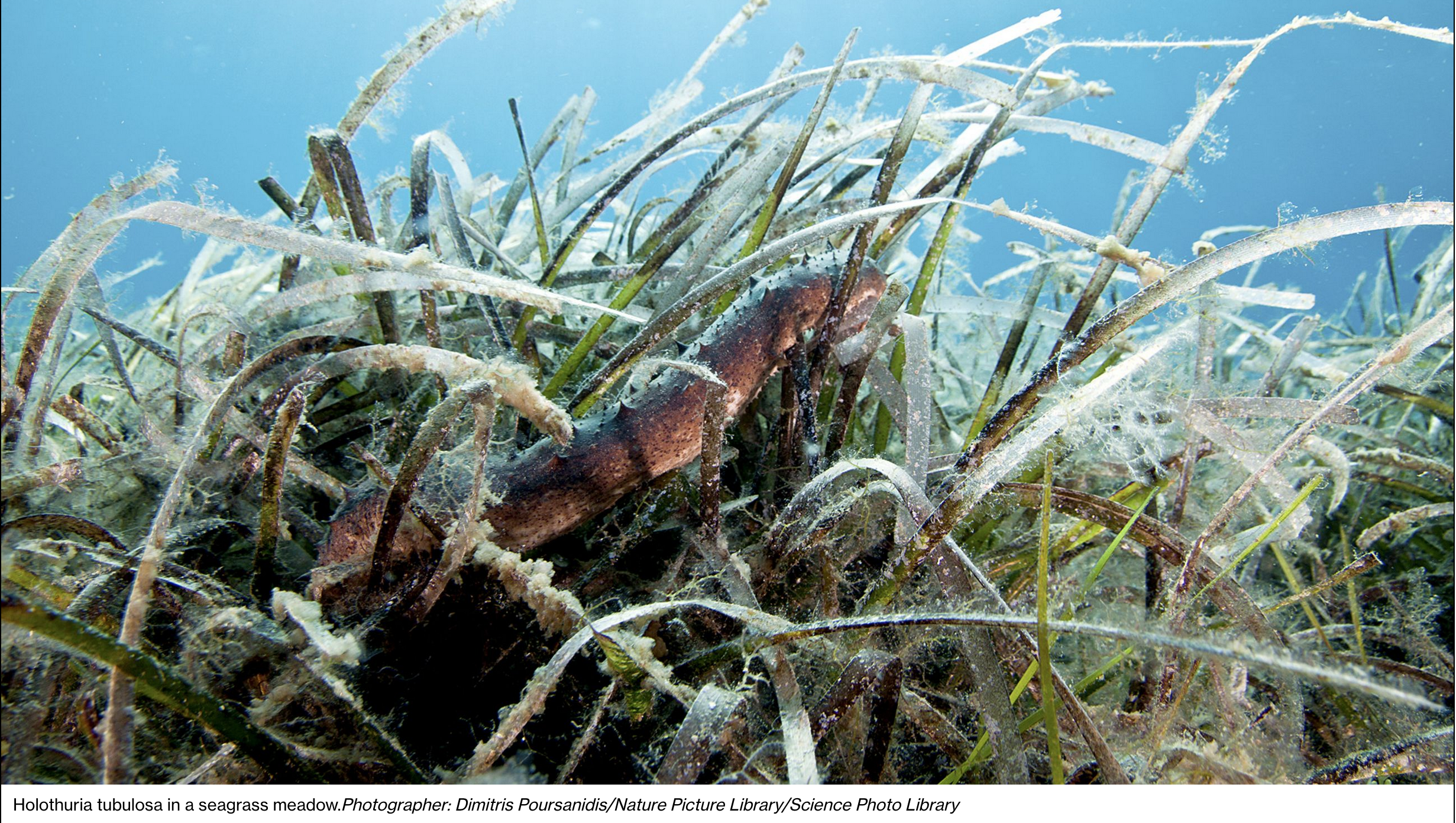
Sea cucumbers are odd looking, but are prized in Chinese cuisine and medicine. We take you inside the quest to save the organism that is critical for ocean health.
At dusk, a man pulled a jam-packed net from the Ionian Sea into a speed boat headed for Taranto, a city in Puglia, Italy. He’d make a few hundred euros off the catch if he could get it into the right hands without being spotted.
His cargo was about 110 pounds of wiggly, slimy sea cucumbers, or—as they are locally called in Italy—
Arturo Casale, 65, got word of the man’s fishing expedition later that day in the form of a photo. It was too late to catch the thief.
As the founder of an environmental nonprofit called Mare Per Sempre (“Sea Forever”), Casale is known locally as the area’s premiere defender of sea cucumbers, which are important in maintaining healthy marine ecosystems and combating effects of climate change.
News of the illegal harvest reached him in early November last year, just a month before the local government was set to deliberate whether gathering sea cucumbers would continue to be a crime.
“It felt like we fell from the clouds,” says Casale. “We were infuriated.”
While most Italians may shiver at the thought of eating sea cucumber, some East Asian countries highly value it in their cuisine and traditional medicine.
In 2020, China and Hong Kong were the world’s largest sea cucumber buyers, importing more than 70% of a global supply worth around $270 million.
China’s love for sea cucumbers—driven by texture, look, and significance in local medical practices—fuels a complex and unsustainable supply chains that originates in Africa, Latin America, South Asia, and the Mediterranean.
A kilogram of sea cucumbers can sell for up to $3,000 to Chinese buyers.
In the past decade, local Italian thieves, aided by Turkish and Greek smugglers, have capitalized on the new business opportunity and started plundering the coast of southern Italy.
In Taranto, located in Puglia on the heel of Italy’s boot, Casale’s small team of volunteer “sea sentinels” has been monitoring the coastline for marine poachers.
The team’s work was instrumental in orchestrating a nationwide ban on sea cucumber harvesting in 2018.
The three-year effort by activists, police, prosecutors, and scientists resulted in Italy becoming the first country in Europe to completely prohibit the extraction and commercialization of the sea cucumber.
However, the ban on sea cucumber harvesting isn’t permanent. It’s a moratorium set to expire in December.
“[Regulators] haven’t issued a definitive one, and every year it’s a battle till the last day,” says Rosalba Giugni, founder of environmental nonprofit association Marevivo, who pushed for the sea cucumber ban back in 2016 and lobbies to continue it.
The fisherman captured on film in November is far from the only one breaking the law: A few days after the incident, Taranto’s financial police arrested 17 people accused of participating in illegal trafficking.
Attempts by local criminals to recapture that market haven’t ceased, and seizures keep happening around southern Italy: On March 15, 2021, three tons of live sea cucumber (in 144 plastic buckets) bound for Greece were seized by Brindisi’s port authorities.

In September, a vendor who claimed to be from Taranto advertised on 21food.com, a Chinese food-trading website, that it could process 1,000 kilograms per month of Holothuria tubulosa, a sea cucumber species common to the Mediterranean.
The protection of these mild sea creatures hangs by a thread.
It depends on complex and collective efforts by environmentalists, law enforcement agencies, scientists, and lobbyists. Sometimes it’s hard to convince people that sea cucumbers are worth protecting.
“Do you know what [Italians] call sea cucumbers? Dicks of the sea,” says Silvestro Greco, a marine biologist at the Anton Dornh Italian National Institute of Marine Biology. “Who gives a damn about the dicks of the sea, right?”
The sea cucumber is not particularly loved. Slug-like, it lacks the personality of an octopus, the Pixar-fication of the clownfish, or the delight of the starfish, to which it is related.
Sea cucumbers don’t attempt to escape their captors, and the ones most popular on the Asian market are smaller than the palm of one’s hand. Only within the past 15 years has it become clear how essential they are to the ocean.
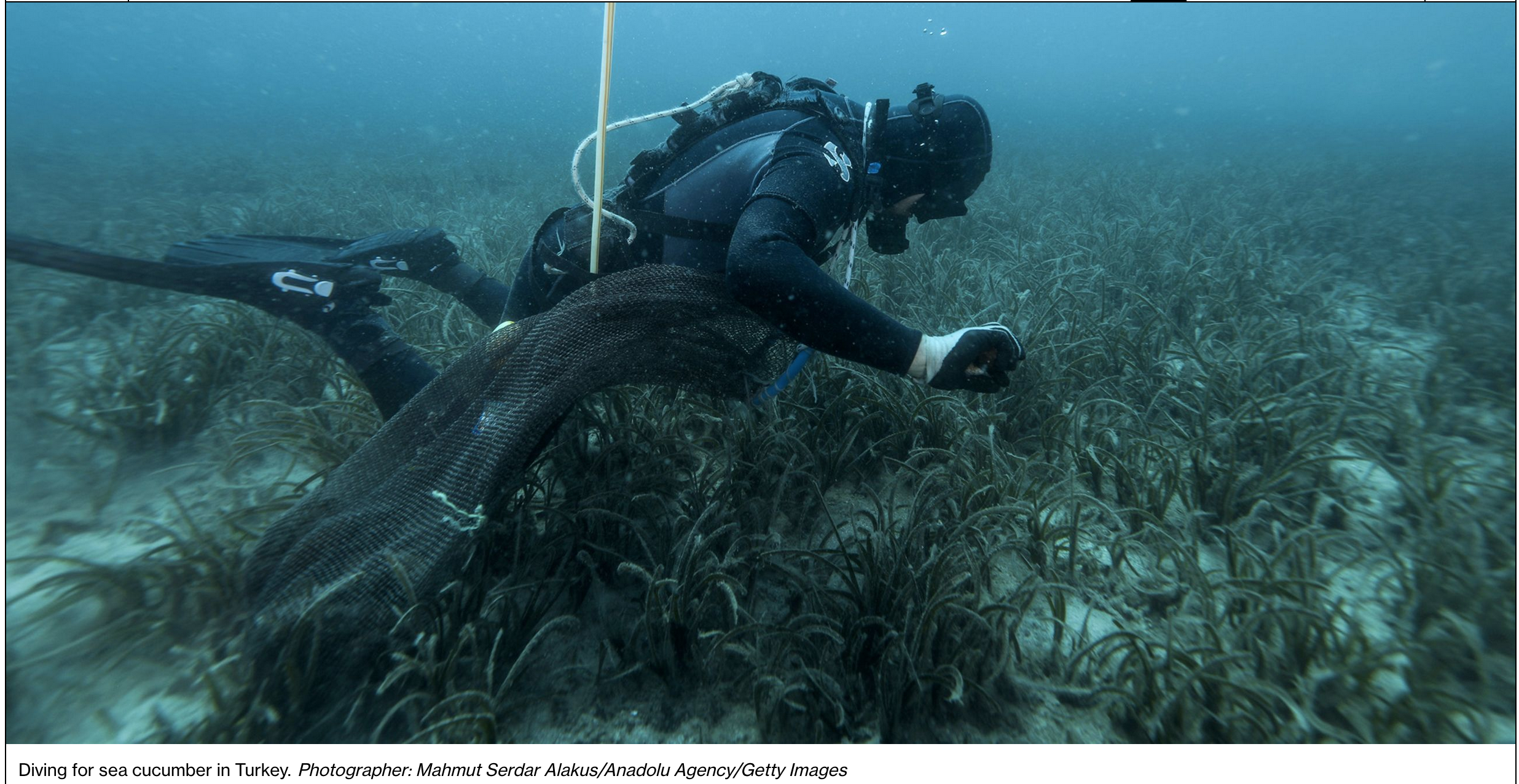
“They have a similar role to an earthworm in that they eat sand and process any of the organic matter and decaying plant matter that’s in the sand, and they poop out clean sand,” says Steven Purcell, a professor of marine ecology at Australia’s Southern Cross University who wrote a book on sea cucumbers.
In doing so, he adds, the sea cucumber helps clean and oxygenate sediments in marine habitats. Smaller animals like worms, crab and even small fish may live on or around adult sea cucumbers to take advantage of their defensive toxins.
An abundance of some large species of sea cucumber can help counter ocean acidification, a nasty side effect of climate change that occurs when too much carbon dioxide dissolves in the water.
Ocean acidification slows the growth of coral reefs, which host a multitude of marine life. Sea cucumbers, thanks to their mineral-rich poop, can provide corals the calcium needed to help grow their skeletons.
“Through their digestion, they actually enhance the alkalinity of the seawater around them. … And so, where you have dense populations of these large sea cucumbers, that might help to buffer some systems from ocean acidification at local scales,” Purcell says.
For all their importance, stirring interest in conserving sea cucumbers has been somewhat challenging around the world. In the mid 1990s, only about 35 countries harvested sea cucumbers. Today, more than 70 countries are involved in the harvest and trading.
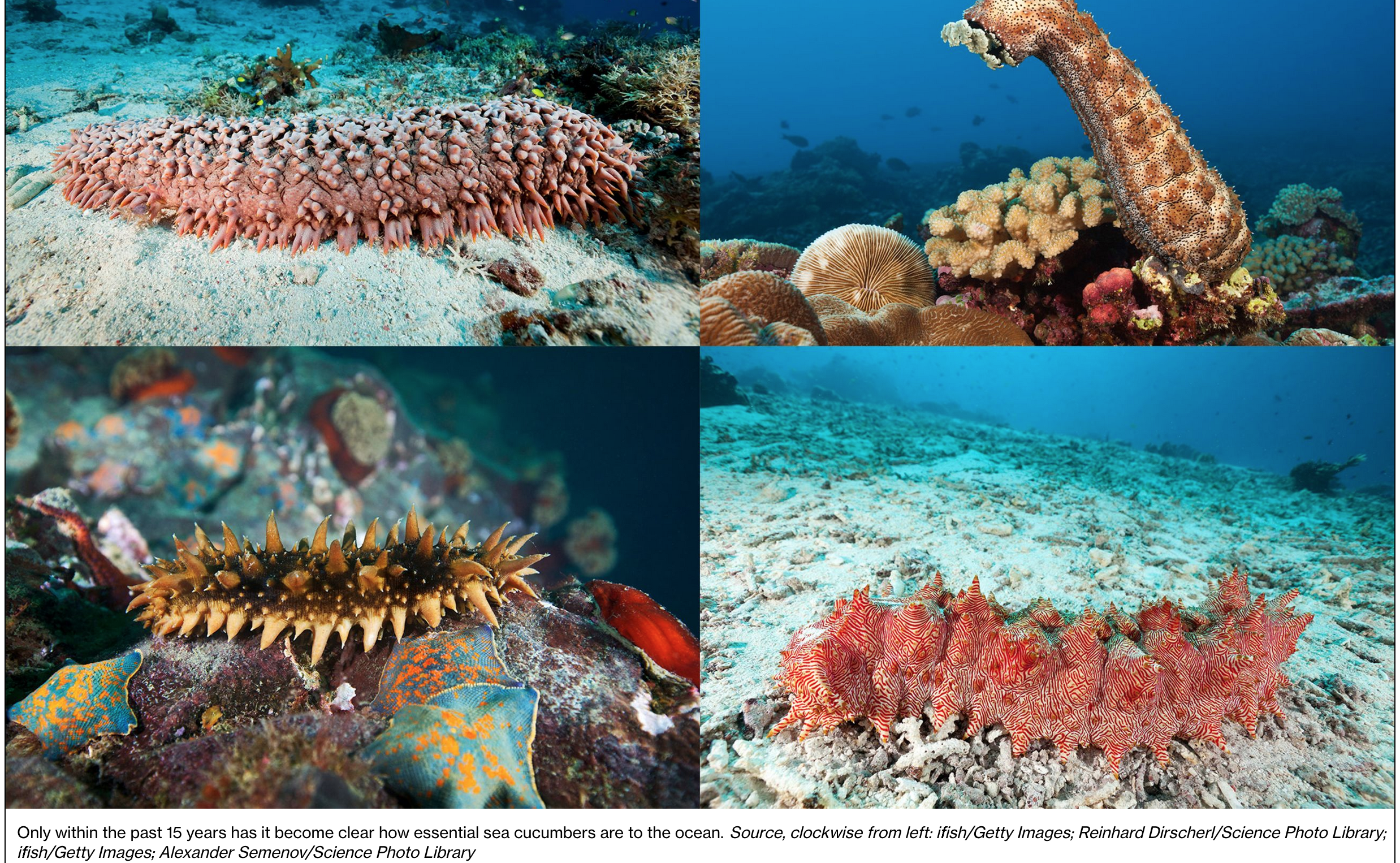
“They’re easy to collect by hand. They don’t turn away. They’re just sitting there. And if you can dive to the depths where they occur, you just need to pick them up,” says Purcell.
Born and raised in Taranto, Casale made ends meet for 40 years working in auto body repair. In 2014, he closed up shop and decided to dedicate his life to protecting the sea.
“If I spend two days in the city and I do not touch the sea—if I don’t dip my hands in it—I feel sick,” he says.
In early 2015, Casale and fellow Sea Sentinel Sergio Passarelli stood on the Discesa Vasto pier in Taranto, marveling at the scene unfolding before them. In a frenzy, fishermen and townspeople alike were dumping buckets of sea cucumber onto growing mounds stacked along the pier. Boats that had been docked for years were out at sea, busily fetching more.
“We’re talking boats overloaded with sea cucumbers,” says Passarelli, a 39-year-old firefighter and active member of Mare per Sempre.
At the beginning, there was a mad rush to clean out all the areas in Taranto colonized by sea cucumbers, Passarelli says.
“Kids were involved, too. In about half an hour, they would fill up a bucket with sea cucumber, take it to the fish store or to unauthorized vendors, who would give them €5 [$5.41] or €6, and they would be happy,” Passarelli said.
The rate of harvesting was so intense that Casale and Passarelli feared Taranto’s entire coastal stretch would be wiped clean within six months.
“It was an ugly dream. A nightmare,” Casale says.
At the time, no regulations prohibited or protected the harvest because there had been no need for any. The activists wondered where the mountains of sea cucumber were headed.
Casale and Passarelli sought help from Vincenzo Casaregola, a captain in the Naval Operations Section in Taranto of Guardia di Finanza, Italy’s financial police.
Casaregola sent a team led by his deputy, Vincenzo Piccininno, to the scene. Piccininno recalls being confronted with “an astonishing amount” of sea cucumbers.
“But we didn’t know what to do with them,” Piccininno says. “We didn’t understand what all this was about.”
Nonetheless, Taranto’s financial police got to work. A few months later, on July 9, 2015, Casaregola’s team raided a storage unit in Taranto and found 39 people, side by side, cleaning 1,000 kilograms of sea cucumbers.
Since the harvesting of sea cucumbers was not illegal then, the police went in under the guise of checking whether the workers had been hired legally. On finding some discrepancies, they seized the sea cucumbers.
That operation set things in motion. A few days later, legislators in Puglia published a notice clarifying that sea cucumbers could not be sold for consumption.

The increased interest from lawmakers allowed the financial police to employ such additional investigative powers as phone tapping, which in turn helped them trace the frenzied harvest to two local criminal organizations.
Court records reveal that the groups had fueled the fishing and commercialization of sea cucumbers in Puglia; cargo ships carried $2.7 million worth of cucumbers out of the region that year.
According to the financial police, masses of illegal fishers were selling their harvest at $1 to $3 per kilogram to the criminal organizations in Taranto, which then sold it to intermediaries at about $7 per kilogram for shipment to China and other Southeast Asian countries.
The authorities were able to seize about 40 tons of sea cucumbers of 600 tons that had been harvested. At least 2 million animals were stripped from the Italian coast in only a year.
“To many people, this issue was a joke, but to our working group it wasn’t,” says Piccininno, the police deputy.
Removing 2 million of anything from an ecosystem is likely to permanently alter it, as Italian scientists soon confirmed. Giovanni Fanelli, a researcher and diver at Taranto’s Istituto di Ricerca sulle Acque, witnessed the sudden depletion of sea cucumbers in the Puglian coastal waters.
It’s hard to quantify the damage done, because there are no previous studies on sea cucumber populations in local waters to use in gauging the full impact of harvesting on wild stocks.
It was not until 2019 that the Convention on International Trade in Endangered Species (CITES) finally approved the addition of three species of international traded sea cucumber to its list of threatened animals.
Still, a majority of sea cucumber species are classified as data deficient, Purcell explains, meaning there isn’t enough biological data on them to decide whether they are threatened.

Starting in 2018, Italy’s Ministry of Agricultural, Food and Forestry Policies began publishing a yearly decree that banned sea cucumber fishing in Italy.
The decree has merely been renewed annually since its first approval, and Giugni says the national government is using a lack of research on sea cucumbers as an excuse not to permanently ban their exploitation.
Nonetheless, the harvest and sale of sea cucumbers is an environmental crime, a felony punishable with up to 15 years in prison.
According to the financial police, more than $9 million in personal property and assets were seized from the two criminal organizations involved in the harvest, and leaders await trial for environmental crimes.
Despite the felony designation, demand for Italian sea cucumbers has not been curbed. In July 2019, a woman was arrested at Rome’s international airport for attempting to roll a suitcase stuffed with dried sea cucumbers past security.
Piccininno, the police deputy responsible for the 2015 investigation, says the dried sea cucumbers were stored as carefully as if they were diamonds.
Italy’s efforts to curb overexploitation of sea cucumber stocks in its waters stand as a testament to what can be accomplished through the effective enforcement of environmental legislation to protect wildlife.
But Casale and Passarelli say Italian authorities are understaffed, lack enough boats, and are unable to maintain the oversight needed to stop illegal extraction. Still, they credit the authorities for trying.
“The hope is that a definitive law, no longer annual, will be issued. It will be easier to work with; otherwise, we risk losing valuable time,” says Francesco Sancineto, commander of the financial police Naval Operations Section in Bari.
For Casale and his team, whose lives revolve around swimming, fishing, and diving in the Mediterranean, the fight is all about protecting the sea’s beauty and biodiversity.
“I won’t compromise. Do not touch the sea. If you do, you are done,” Casale says. “The sea is everything to us.”
Updated: 5-18-2022
Global Warming Threatens Africa’s Southern Yellow-Billed Hornbill
The bird is closely related to the red-billed hornbill, which was the inspiration for the character of Zazu in the movie “The Lion King.”

A sustained increase in global temperatures could see the southern yellow-billed hornbill disappear from parts of the Kalahari Desert in Southern Africa by 2027, according to a study led by the University of Cape Town.
The bird is best known for its unusual breeding and nesting habits where the female seals herself in a cavity and stays there for about 50 days to brood and care for chicks.
The creature is also closely related to the red-billed hornbill, upon which the character of Zazu in the movie “The Lion King” was based.
Southern yellow-billed hornbills struggle to breed above certain temperatures as they face greater difficulty in foraging and lose weight.
A comparison of two three-year periods, between 2008 and 2011 and 2016 and 2019, showed that the number of occupied nest boxes at a site in the Kuruman River Reserve in South Africa fell to 12% from 52%, the researchers said.
The average number of chicks per breeding attempt declined to 0.4 from 1.1.
Meanwhile temperature data for the region going back to 1960 for the region showed no significant changes until the summer that straddled 1996 and 1997, said Nicholas Pattinson, an author of the study and a researcher at UCT.
The average mean maximum daily temperature rose about 1 degree Celsius per decade from then, according to the paper.
“There is rapidly growing evidence for the negative effects of high temperatures on the behavior, physiology, breeding and survival of various bird, mammal and reptile species around the world,” Pattinson said. “Southern yellow-billed horn bills could be extirpated from the hottest parts of their range as soon as 2027.”
The study, one of the first to research the impact of rising temperatures on breeding success for a species over a longer period of time, shows that global warming heightens the risk of more extinctions and a decrease in biodiversity.
Above a daily maximum temperature of 35.7 degrees Celsius (96.3 Fahrenheit), there were no successful breeding attempts among the hornbills.
Based on current global warming trends, that temperature will be exceeded for the birds’ entire breeding season by 2027, the researchers said.
Updated: 5-25-2022
Elon Musk Sees Extinction of Italians On Persisting Low Birth-Rate
* Tesla Founder Warns Against Dangers Of Population Collapse
* Italy’s Population Could Drop By 20% By 2070, Istat Says
The world’s richest man is concerned Italians could become extinct due to one of the world’s lowest birth-rates.
“Italy will have no people if these trends continue,” Tesla Inc. chief Elon Musk, who has warned about the dangers of global depopulation in the past, said on Tuesday. He was answering a tweet by Rome-based cyber security researcher Andrea Stroppa, who had published a demographic trend chart showing birth-rate falling for decades.
Last year Italy reported its lowest ever birth-rate at little more than one child per woman, according to Italian statistical institute Istat.
That means Italy counted seven newborns and twelve deaths per thousand inhabitants in 2021, Istat said. While that was partly due to Covid mortality, Istat sees the country’s population dropping by 20% by 2070 — that’s 12 million fewer people.
Low birth rates have strained pension and health-care systems across Europe for years as the number of working-age adults to support an aging population shrinks. The pandemic only exacerbated that trend.’
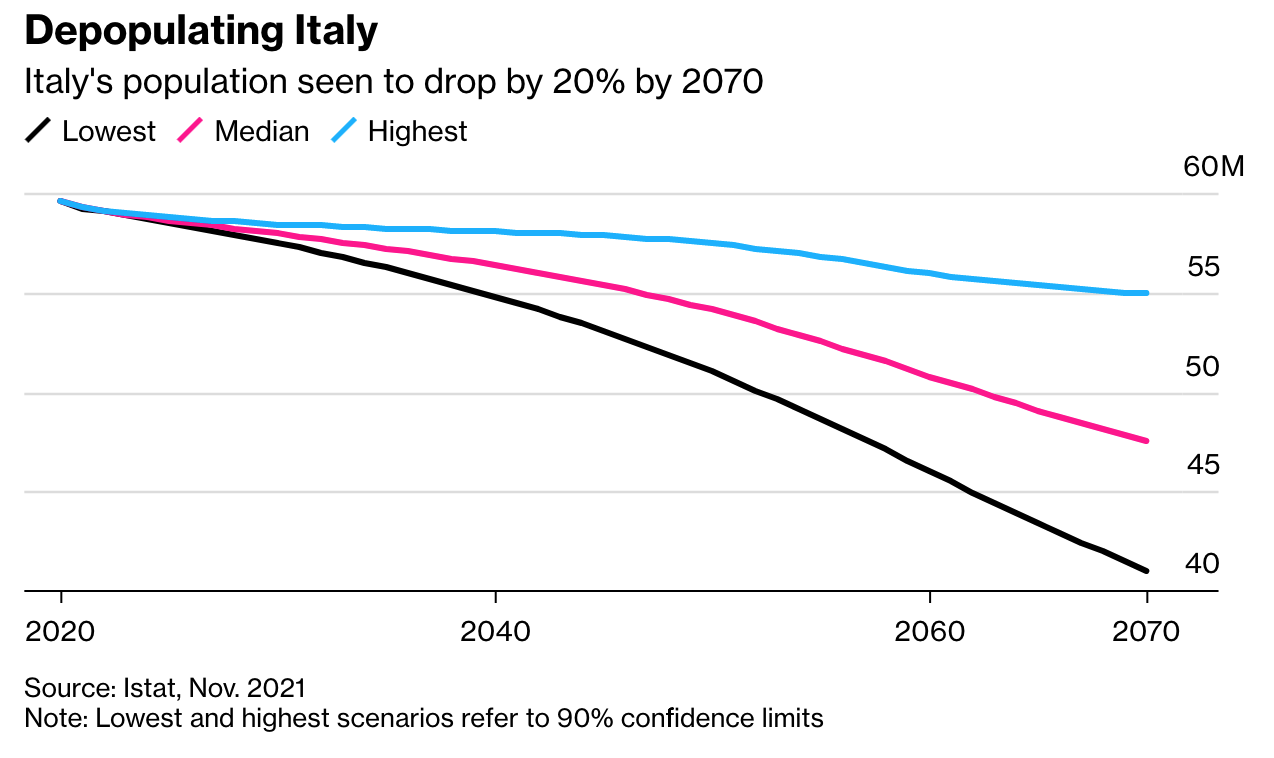
Musk isn’t new on the low birth-rate topic.
“Most people believe that we have too many people on the planet. This is an outdated view,” Musk said in 2019 at the World Artificial Intelligence Conference in Shanghai, debating with Alibaba Group Holding Ltd. Chairman Jack Ma. Assuming AI is fine, assuming there’s a benevolent AI, the biggest problem the world will face in 20 years is a population collapse, he had added.
Crocodiles Are Losing Their Teeth, And Angling Is To Blame
* Study In South African Lake Shows Record Lead Poisoning
* Crocodiles Scoop Up Fishing Weights From The Lake Floor
A study of 25 Nile crocodiles in Lake St. Lucia, a World Heritage site in South Africa, found that the highest lead concentrations “ever reported for crocodilians worldwide” was due to the ingestion of fishing weights.
That lead poisoning — from when the animals scoop up stones from the lake floor to help with digestion — caused anemia in some of the crocodiles as well as “severe tooth loss,” the researchers from three universities in the country and the South African National Biodiversity Institute said in the study.
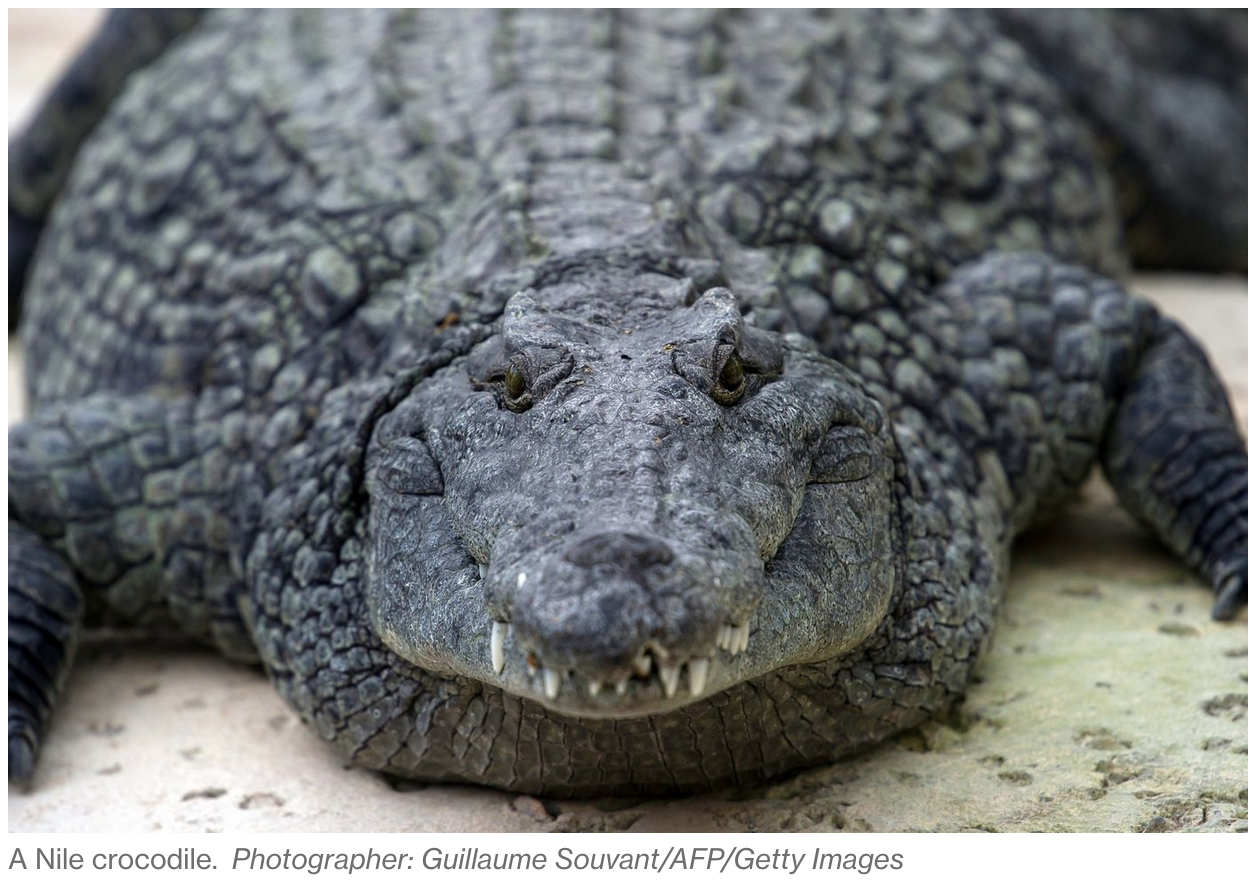
“Crocodiles a Lake St. Lucia have some of the highest blood lead concentrations ever recorded in wildlife globally,” Marc Humphries, one of the authors of the report, said in a response to questions. That’s “quite something considering St. Lucia’s conservation and World Heritage status,” he said.
The predatory reptiles, some of which have been alive for decades and can grow to long as 4 meters (13 feet), are part of a population of about 1,000 crocodiles in Lake St. Lucia’s estuarine system.
Recreational fishing has taken place in the area since the 1930s, resulting in discarded lead weights building up on the lake bed.
The metal stays in the crocodiles’ bones, making its teeth more fragile — and lost teeth aren’t replaced. “In severe cases, tooth loss could thus result in nutritional stress and death,” the researchers said.
The crocodiles mostly eat fish, but also prey on antelopes, bush pigs and smaller hippos in the lake.
“There are non-toxic alternatives to lead (steel and tungsten for example) that government and conservation authorities in South Africa should be exploring,” Humphries said. “We continue to allow lead to be used in some of our most important conservation areas.”
Updated: 6-14-2022
Mexican Biologists Aim To Save Hummingbirds With Wildflowers
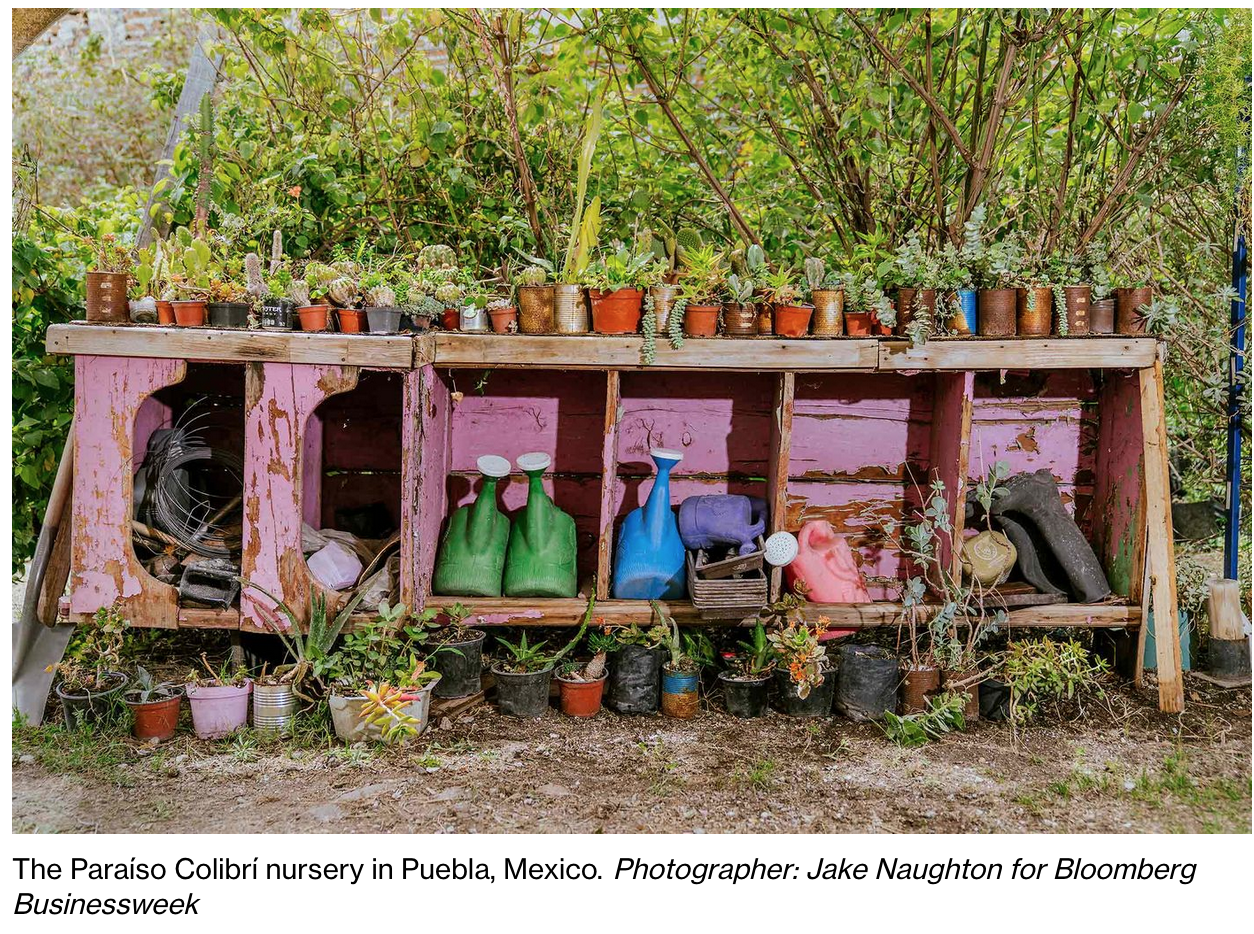
Mexico’s Paraíso Colibrí grows native plants for city sanctuaries to feed birds at risk of extinction because of urbanization, climate change, and an illegal trade.
With its temperate climate and rich diversity of wildflowers, Mexico is a haven for hummingbirds. It boasts 58 species, including all 19 types seen in the US and Canada.
The tiny birds proved elusive, however, when Rocío Meneses tried to catalog each species, starting in 2013, while co-writing a book called Hummingbirds of Mexico.
Meneses found that the best way to glimpse their flitting wings was to wait by the native plants whose nectar they love to drink. “We became searchers of flowers rather than hummingbirds,” she says.
Now Meneses travels at least twice a month to remote parts of central and northwestern Mexico to find flowers to reproduce for her company, Paraíso Colibrí (Hummingbird Paradise), which sells plants to gardeners and corporate clients.

The business is part of a movement aimed at stemming the birds’ population decline by creating gardens to feed them in Mexican cities. Battered by climate change, deforestation, and an underground trade selling dissected hummingbirds as love charms, 13 of Mexico’s species are considered at risk of extinction.
About 60% of Mexican species are imperiled by climate change, and many are losing habitat to relentless urbanization, according to research by María del Coro Arizmendi, a professor and ornithologist at Universidad Nacional Autónoma de México (UNAM).
Arizmendi runs a hummingbird observation center and started a city garden project to provide sanctuaries for the birds in 2014. “This country is becoming urban, and it seems there’s no way back,” she says. “We need an alternative so that hummingbirds can be conserved in the cities we live in.”
It was Arizmendi who first encouraged Meneses—at the time her master’s student—to turn a flower-growing hobby into a business. When the urban gardening effort was getting going, about 90% of plants sold in Mexico City were non-native.

Since launching Paraíso Colibrí in 2016, Meneses has populated the capital and cities in five other states with about 145 plant species, including Buchanan’s sage, blue passionflowers, and yellow oleander.
Almost 500 wildflower gardens for hummingbirds have been registered across the country on Arizmendi’s website, and Meneses works with 29 corporate clients, including L’Oréal SA, plus seven schools.
The business has 10 employees, and Meneses has helped six other nurseries start growing native plants. Beyond helping hummingbirds, they sell plants that attract such pollinators as bees, butterflies, and bats.
She and her domestic partner, Sergio Ramírez Martínez, used their savings to start the business and have had no outside investment. Meneses chooses to use only the most basic equipment and to work without electricity at the nursery to grow her wildflowers.

Reproducing the plants has been a giant undertaking—around 90 of the species Meneses sells weren’t commercially available before Paraíso Colibrí got started, she says.
Scientists knew little more than the names of many of them, so Meneses and her team had to seek them out in the wild, visiting half a dozen states.
In one trip to Durango in the northwest, they found a previously unknown hybrid of two types of salvia that scientists at UNAM are studying and may endow with its own name, Meneses says. Locating the flowers is just the first step. It takes a year of observation to work out how to make them reproduce and thrive, she says.
Personal danger hasn’t stopped her visiting states such as Guerrero, where four environmental activists were killed last year. It’s worth the risk to help protect the short-crested coquette, Meneses says.
That species of hummingbird has a distinctive fluffy orange crown and green head and exists only in a 50-square-kilometer (19 sq mi) region of Guerrero. “Hummingbirds are important, and if we don’t conserve them, it’s very likely they could disappear in the next 20 to 30 years,” she says.
It’s not just the future of the birds that’s at stake. Meneses says hummingbirds are the key pollinators for about 1,000 Mexican plant species, dipping their long, delicate beaks far into flowers as they lap up nectar and then pass their pollen onto other plants, enabling them to reproduce.
Lavenders and salvias “won’t survive if we take away hummingbirds,” Arizmendi says.
There’s little good data on Mexican hummingbird populations. Scientists only recently started monitoring them, and their legs are too spindly to hold transmitter tracking devices. That makes it difficult to put hard numbers on the progress of efforts to bolster their populations.
But there are victories to celebrate. With the help of bird sightings recorded by enthused customers, Paraíso Colibrí has already made scientific discoveries about hummingbird migration patterns, Meneses says.
And Mexico City had particular success using Mexican bush sage to restore a park around the National Canal in the Churubusco neighborhood, Arizmendi says. “There are mountains of hummingbirds there now,” she says. “Mountains!”
Updated: 6-16-2022
Polar Bears In Greenland Adapting To Life Without Sea Ice
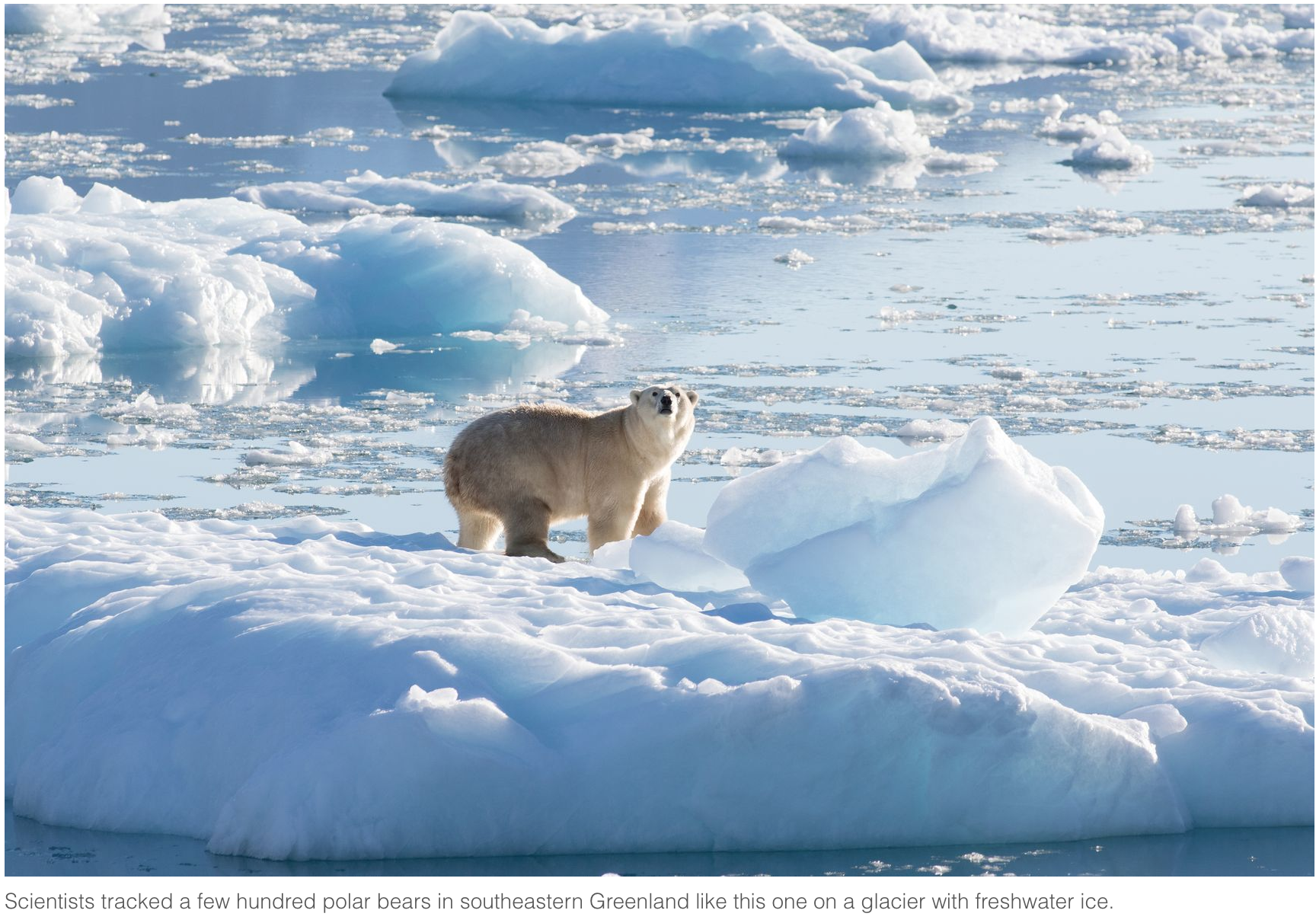
The small group shows resilience as the climate warms, but some scientists warn that polar bears elsewhere might still struggle to survive.
Polar bears have been struggling as the climate warms and Arctic sea ice melts, but scientists have discovered a group of bears in southeastern Greenland that have adapted to life without sea ice by hunting on glacier ice.
The unexpected finding, published Thursday in the journal Science, suggests that the species—which typically depends on sea ice for hunting seals—may prove surprisingly resilient in the face of the continuing loss of sea ice as the climate warms.
“When you start to look at how polar bears might survive in small numbers in parts of an ice-free Arctic, this type of glacial habitat might be a refuge,” said Kristin Laidre, a research scientist at the University of Washington’s Applied Physics Laboratory and the paper’s first author.
The bears described in the paper—a few hundred animals living in fjords and isolated from other polar bear populations by mountains and ocean currents—were seen hunting year-round in a slushy freshwater zone where Greenland’s glaciers and ice-covered fjords flow into the North Atlantic Ocean.
Such glacial environments aren’t common, said Dr. Laidre, but are seen elsewhere in Greenland and in Svalbard, the remote Norwegian archipelago in the Arctic Ocean.
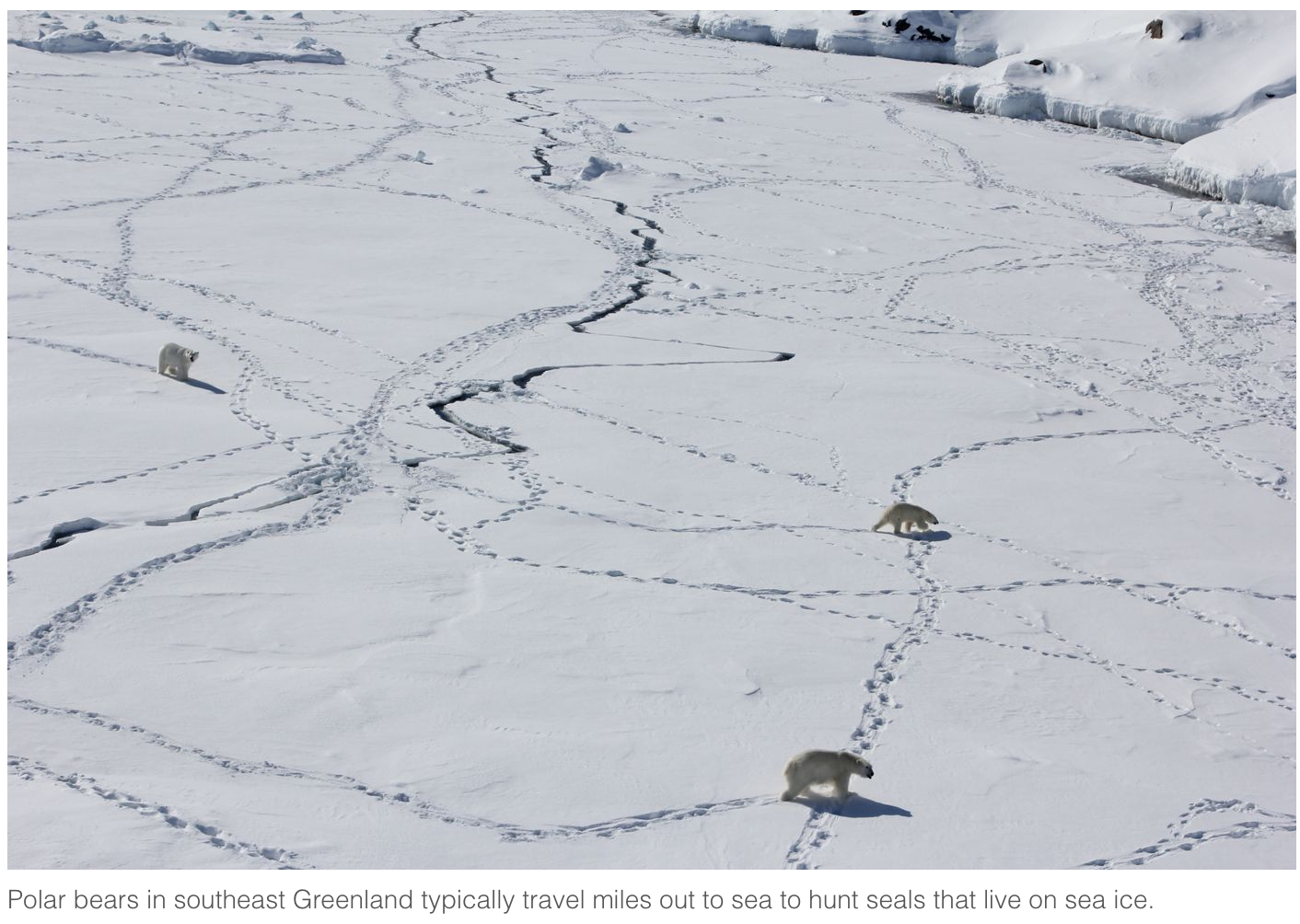
“The way they’ve persisted in this area is they have access to glacial ice that is basically freshwater ice that is pouring off the Greenland ice sheets in the form of glaciers,” Dr. Laidre said of the bears described in the study. “It then breaks off and it creates an ice landscape. It’s an uncommon habitat for polar bears.”
Typically, polar bears range miles out to sea to hunt seals that live on sea ice. When sea ice cover retreats and polar bears are forced to forage for food on land, they have trouble surviving on the small birds or plants available there, according to Todd Atwood, a U.S. Geological Survey wildlife biologist who studies a bear population in the Southern Beaufort Sea off Alaska.
The blanket of Arctic sea ice expands in winter and spring and contracts in the summer, reaching its lowest point each September. NASA satellite observations show summer sea ice disappearing at a rate of 13% per decade.
That has led some researchers to express fears that the animals might be headed for extinction—perhaps as soon as the end of the century if climate change continues at its current pace, according to research published in 2020 in the journal Nature Climate Change.
“We are continuing to see a decline in sea ice extent and sea ice thickness,” said Thorsten Markus, program manager for cryospheric science at NASA headquarters in Washington, D.C. “There are projections that by midcentury, you will have no sea ice left during the summer.”
Greenland’s glaciers are retreating along with sea ice, according to NASA, though over the course of centuries rather than decades.
For the new study, Dr. Laidre and her colleagues tracked the glacier-dwelling bears with radio collars and studied their DNA from tufts of fur removed after the animals had been tranquilized with darts fired from helicopters.

The researchers combined seven years of new data with more than 30 years of historic information. They also sought information about the bears’ location, behavior and feeding habits from indigenous residents, who hunt the animals for their pelts and have detailed knowledge about them.
Researchers discovered that this isolated group of bears have lived apart from other groups for several hundred years and are smaller than other bears.
Adult females weigh about 400 pounds, while adult bears in other populations can top 560 pounds. The bears in the study also have few cubs, perhaps because it is difficult to find mates in the harsh terrain.
Dr. Atwood called the finding an important advance in understanding polar bear populations, but said it didn’t indicate that polar bears in Alaska, Canada and Russia could necessarily survive on freshwater ice as the Greenland bears have managed to do. “I think the concern is the rate at which changes are occurring in the Arctic is outpacing the rate of bears to adapt,” he said.
“There’s a limit to what they can adapt to,” Ian Stirling, adjunct professor in the University of Alberta’s Department of Biological Sciences and a research scientist emeritus with Environment Canada, said of the world’s polar bears. “For 95% of the bears, when the sea ice is gone, they will be in very big trouble.”
The world-wide population of polar bears now stands about 26,000, with 19 distinct population groups spread in Arctic regions of Canada, Russia, Alaska, Greenland and Norway, according to the International Union for the Conservation of Nature.
While a ban on polar bear hunting imposed in the 1970s helped stabilize polar bear numbers, the animals have been listed as threatened by the U.S. government since 2008.
Updated: 6-21-2022
World’s Tallest Mammal Disappearing From Africa At Alarming Rate
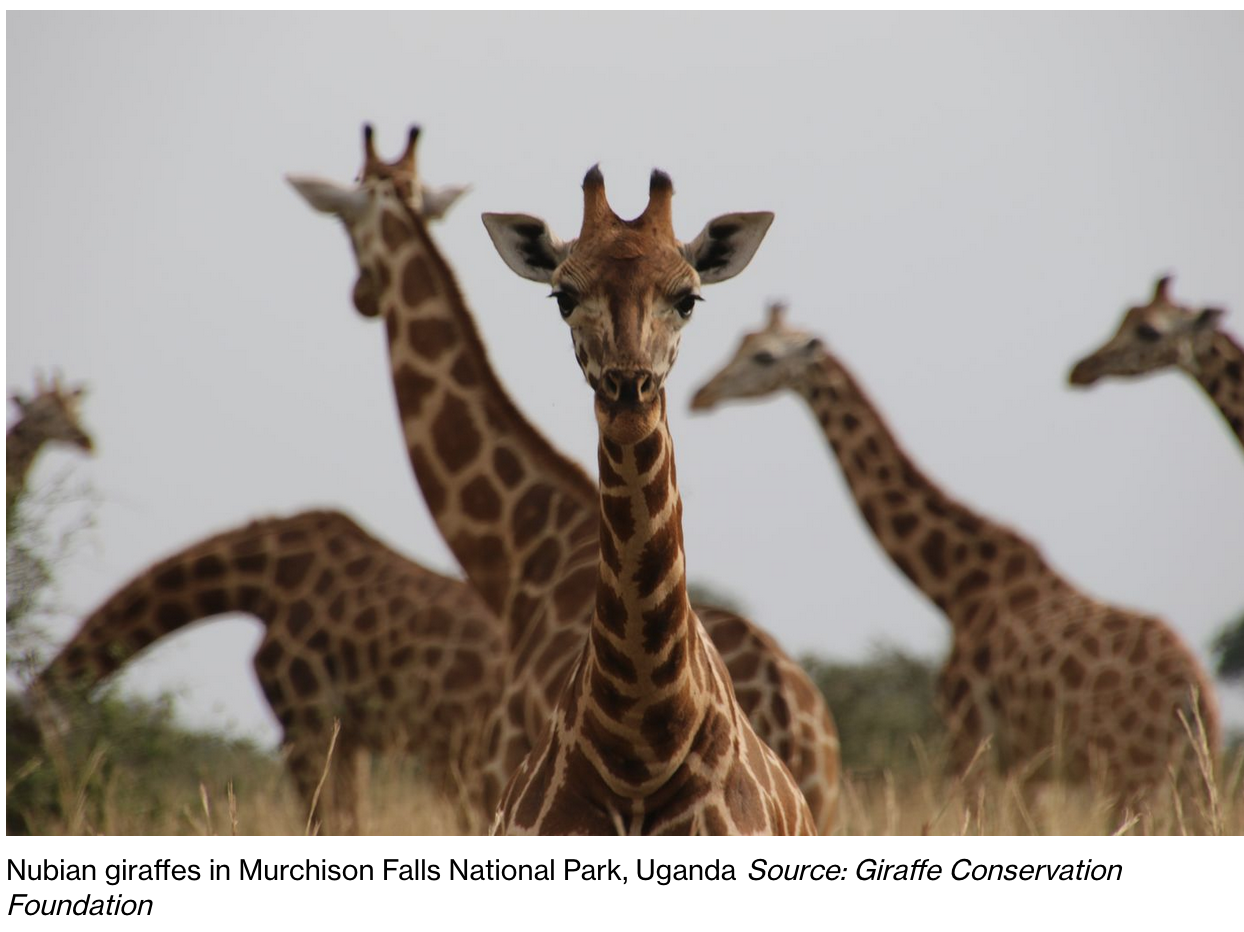
Efforts to draw attention to the plight of giraffes gain urgency.
From my safari Jeep in South Africa’s Kruger National Park, binoculars aren’t needed to spot the long, elegant neck of a giraffe through the treetops in the distant bush.
The world’s tallest mammal—towering between 14 and 19 feet—is impossible to miss, yet somehow it has quietly moved toward extinction without much notice.
About 117,000 giraffes remain in Africa, a drop of nearly 40% from 35 years ago, according to the latest estimates from the Giraffe Conservation Foundation, a Namibia-based nonprofit dedicated to saving giraffes in the wild. That’s one living giraffe for every three to four elephants.
They’ve disappeared completely from seven African countries, prompting the International Union for Conservation of Nature to sound an alarm and classify them as “vulnerable” in December 2016.
There are four species of giraffe, each of which live in geographically distinct regions. Some subspecies have been moved to the IUCN’s endangered or critically endangered status.
There are fewer than 2,000 Kordofan giraffe, a subspecies found across West Africa with small, pale yellowish-brown spots that stop on its haunches, for example, and around 15,950 reticulated giraffes, a subspecies native to the Horn of Africa distinguished by its rich orange-brown patches starkly outlined in white.
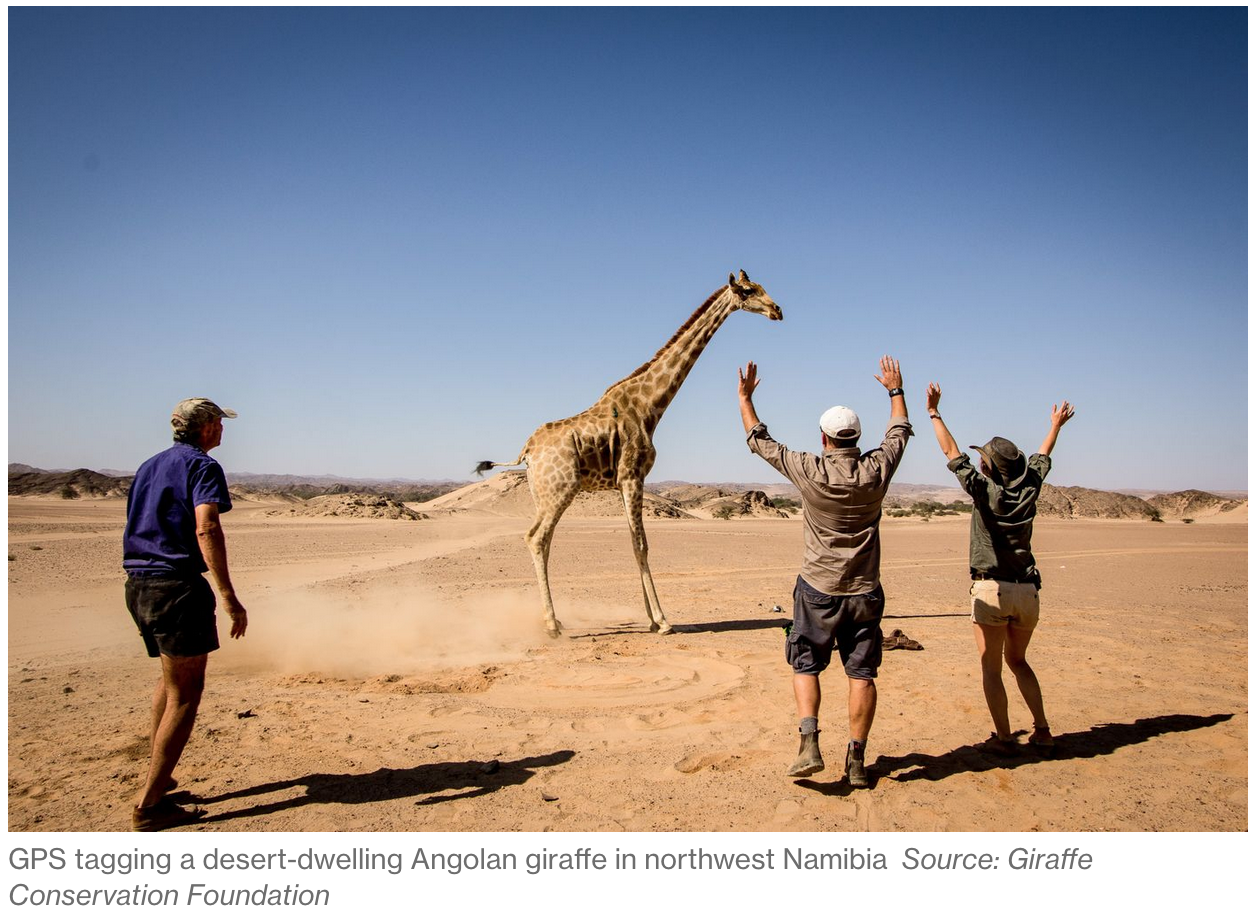
The usual factors, including disease, civil unrest, and illegal hunting, have contributed to the decline in giraffe numbers. (There are also cultural reasons: Some poach them for meat or believe the skin cures cancer, and some consider their tails a status symbol.)
But environmental pressures, particularly habitat loss, are the main culprit, says Stephanie Fennessy, director of the Giraffe Conservation Foundation.
In the last 300 years, giraffes have lost almost 90% of their habitat to human development including agriculture and infrastructure building, she says.
Although they’re not part of the so-called safari Big Five—elephants, lions, buffaloes, leopards, and rhinoceroses—the tall leggy blondes of the African plains are equally as iconic.
Yet their impending demise has failed to attract the attention that the plight of the rhino or elephant has.
Celebrities including Edward Norton and Leonardo DiCaprio have helped raise awareness about the danger to two of Africa’s most poached and trafficked animals, prized for their horns and tusks.
In 2021, the IUCN changed the status of the African forest elephant and African savanna elephant from vulnerable to critically endangered and endangered, respectively, estimating that only a total of 415,000 remain on the continent. And three species of rhino—black, Sumatran, and Javan—are listed as critically endangered.
In recent years, increased law enforcement and legislation for trafficking as well as population relocation programs have halted some declines. Black rhino numbers have actually grown at an annual rate of 2.5% between 2012 and 2018.
Giraffes haven’t been able to muster the same star power. Fennessy says the main reason is that people aren’t aware of the problem.
“You’re still likely to spot giraffes in the major tourism parks and game reserves like the Serengeti and Maasai Mara, so people just assume they’re flourishing everywhere in Africa,” she says.
To raise awareness of what Fennessy has coined a “silent” extinction, the Giraffe Conservation Foundation designated June 21 World Giraffe Day.

Fennessy’s organization, which works in 17 African countries, has been collaborating with governments and local communities to bring the giraffe back into areas where they’d historically thrived.
In Uganda, for example, civil unrest decimated the number of Nubian giraffes—which stand out because of their large, rectangular, chestnut-brown patches–to barely 250.
Cooperation among the government, communities, and the Giraffe Conservation Foundation has facilitated the translocation of three populations of giraffes and has increased the rare subspecies’ numbers to more than 1,650.
World Giraffe Day is aimed at raising awareness around returning the animals back to Mozambique, a country where giraffes once flourished, says Fennessy.
“There are currently only 250 giraffes in the entire country, and we’ve committed to bringing in 350 in the next five years to four or five different locations to boost the populations,” she says. “We estimate this series of translocations will more than double the population.”

Translocations like this can cost upwards of $50,000, says Fennessy. She hopes partnerships with safari operators can spur major donations from people willing to pay in exchange for getting a more intimate glimpse of the conservation efforts through partnerships with safari outfitters. Safari operators, so far, have been eager to be involved.
The loss of any species threatens to collapse fragile ecosystems, says Dereck Joubert, conservationist and chief executive officer of Great Plains Conservation. Giraffes, for example, trim trees into umbrella shapes that afford shade and protection for antelope, zebra, and other species.
While those animals cool in the shade, they stimulate the grass under those trees, and that attracts small grazers. “The simple act of grazing a tree to shape changes everything,” he says.
Great Plains Conservations has focused anti-poaching efforts in northern Tanzania, an area notorious for giraffe poaching. The organization recently announced a three-year plan to relocate more than 3,000 animals, including giraffes, to Sabi Reserve in Zimbabwe.
Natural Selection, an operation with camps in South Africa, Namibia, and Botswana, partnered with the Giraffe Conservation Foundation to build Hoanib Valley Camp deep in northwestern Namibia.
Guests can assist in collecting data, such as grazing range, on the area’s desert-adapted giraffe, and 1.5% of the camp’s revenue is invested in Giraffe Conservation Foundation.

To date, the Giraffe Conservation Foundation’s collaboration with Namibia-based operator Ultimate Safaris has been its biggest success story. In June 2021, the partners moved 14 Angolan giraffes, which are a pale cream color with brown spots and speckled lower legs, from a small private farm to a vast expanse of communal lands in northwest Namibia to help boost an existing giraffe population.
“Seeing the return of Angolan giraffe in numbers to this area is amazing,” says William Steenkamp, a naturalist guide at Ultimate Safaris’ new lodge, Onduli Ridge, named after the area’s resident animals (onduli means giraffe in the Oshiwambo language spoken in northern Namibia).
“Where in past years giraffe sightings were rare, they are now pretty much daily,” he says. “They’ve added so much value to our guest experience as well as a point of pride in the local communities.”
Updated: 6-27-2022
Beehive Wipeout Is Crimping Harvests As Crisis Enters New Stage
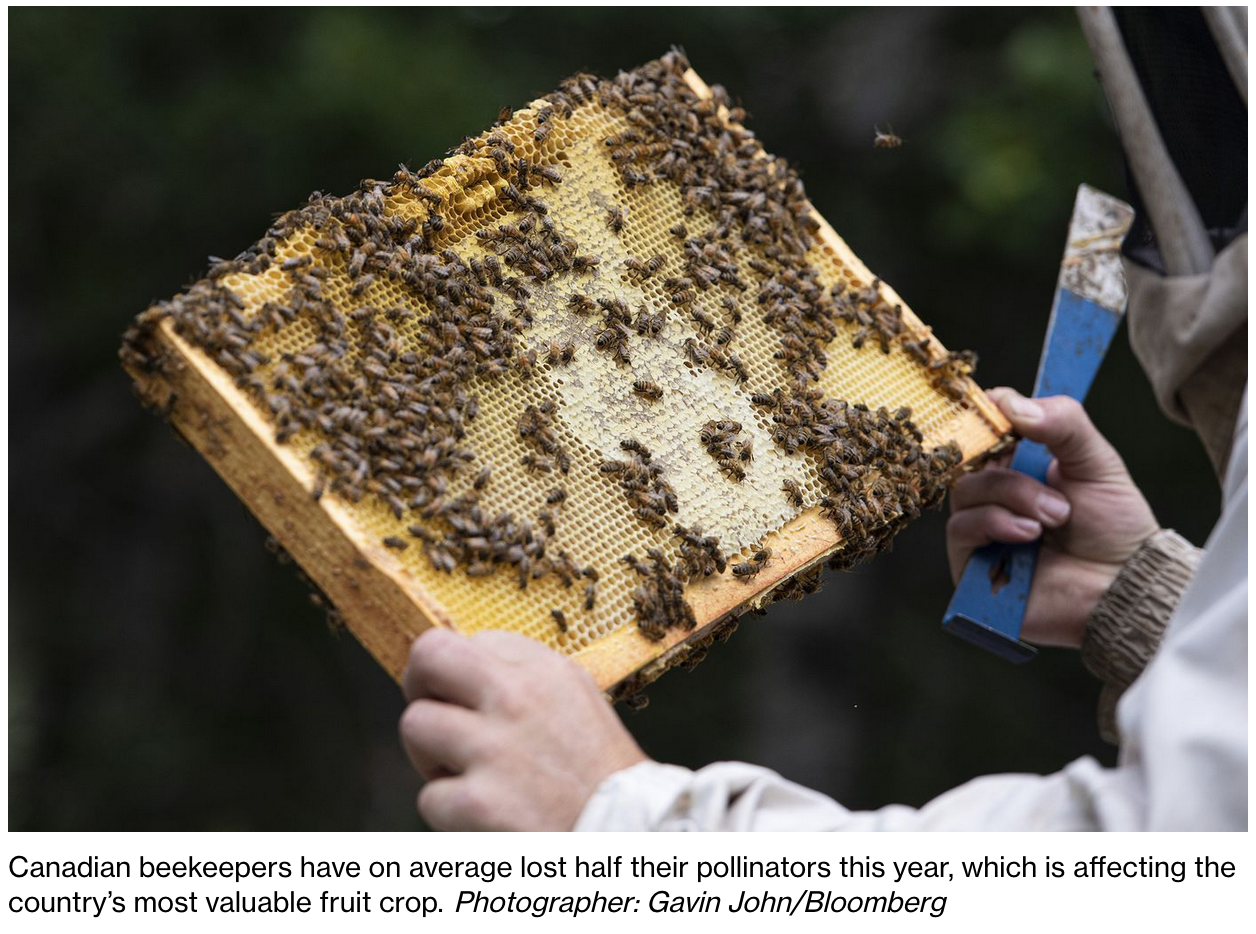
On Canada’s blueberry farms, there simply aren’t enough bees. It’s a troubling sign, experts say, of what could happen elsewhere.
The global honeybee crisis has reached alarming levels in Quebec’s blueberry pastures.
It’s flowering season at Nicolas Pedneault’s farm in the French-speaking Canadian province and every bee that lands on a blossom helps boost his blueberry crop. Hundreds of hives dot his fields, but he needs more—and can’t get them.
“We don’t have enough pollinators,” said Pedneault, who fears his output will be slashed. “Every honeybee hive we don’t get is impacting our fields.”
Blueberry growers across the entire country face similar troubles due to a shortage of the commercial hives they rely on to boost their bounty of Canada’s most valuable fruit crop.
Canadian beekeepers have on average lost half their colonies this year, and in some areas there’s almost total collapse. That leaves berry farmers with a crippling bee shortage and few suppliers to fill the void.
“We probably haven’t seen this high of losses since one of our early years in beekeeping,” said Kevin Nixon, who has been in the business for nearly three decades. He lost 40% of the 10,000 hives he manages south of Red Deer, Alberta. “I know some guys that lost 90%.”
Beekeepers worldwide have been reporting massive honeybee deaths for years, but in parts of Canada this year’s losses are catastrophic.
The impact on the C$274 million ($211 million) blueberry market in Canada, the world’s seventh largest exporter, is a warning to the world of what happens when there is a breakdown in the fragile pollination industry.
“I’ve not heard of other places where there’s been a pollination shortfall,” said Robert Paxton, zoology head at Germany’s Martin Luther University Halle-Wittenberg. “Beekeepers are having more problems maintaining their colonies and there’s more demand for their colonies for pollination.”
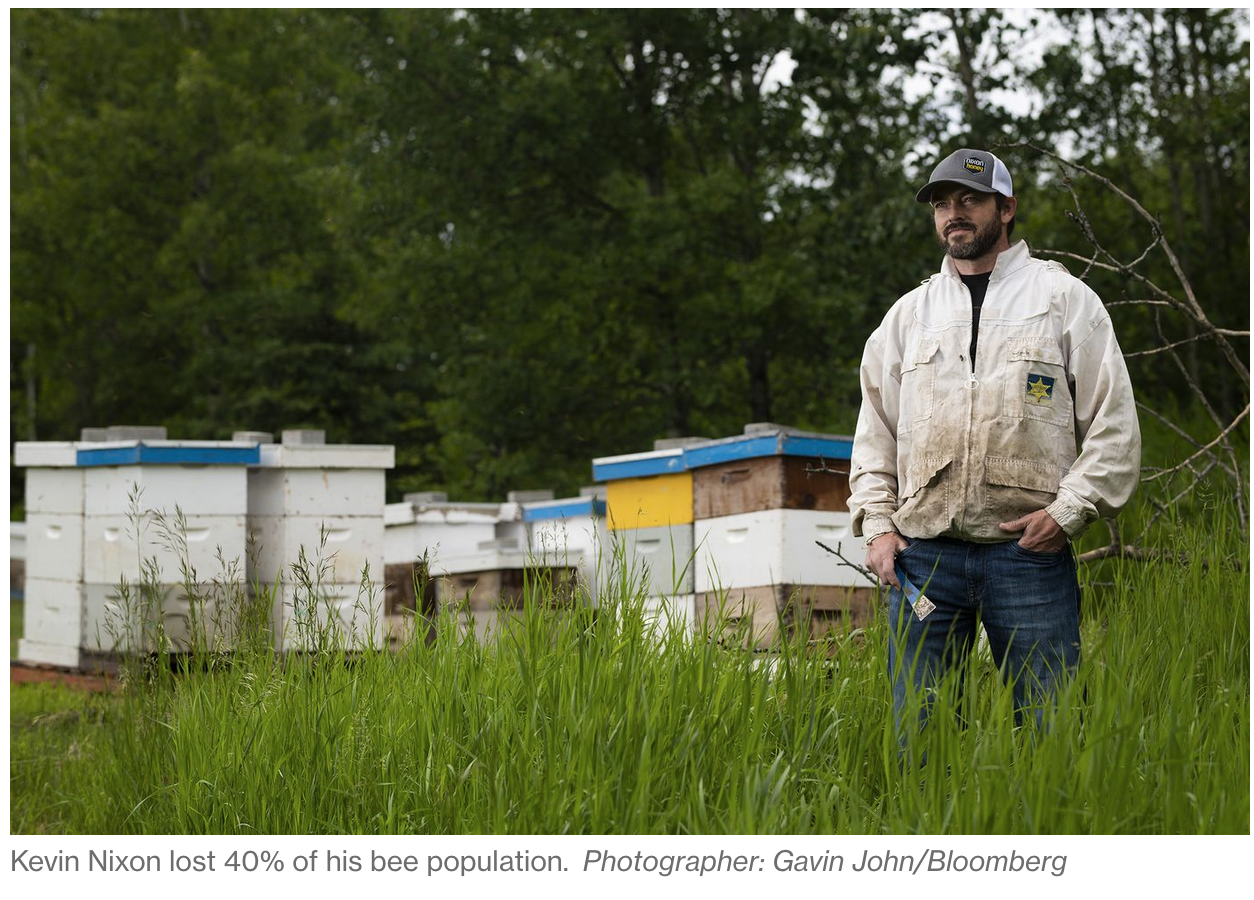
The industry in North America has expanded to support a boom in fruit and vegetable acres as wild bee numbers withered. Beekeepers who struggled to make money selling honey started renting out hives to farmers seeking to boost yields.
“Pollination brokers” connected growers with hives, which today crisscross the continent on semi trucks to reach their destinations.
Bees play a key role in spreading pollen between flowering plants to trigger reproduction, ultimately giving the world nutritious and colorful foods such as apples, cherries, melons and almonds.
More than 100 US crops rely on pollinators and the added revenue they bring to crop production is valued at $18 billion annually, according to the US Department of Agriculture.
Overworked bees helped create a pollination crisis, said Mark Winston, a leading expert in the field.
“The paradigm of bringing in honeybees is at a breaking point,” he said. “Bees are not getting better; they are slowly getting worse.”
Death rates among honeybee colonies have been a concern for decades, and staggering losses first reported in the US in 2006 raised further alarm.
The phenomenon appeared in other countries too and has been attributed to issues ranging from extreme weather and crop-chemical exposure to parasites.
American beekeepers typically lose an average of 40% of their bees a year, while losses in Canada average around 20%.
Despite die-offs, studies suggest the number of managed honeybees rose more than 80% since the early 1960s as beekeepers expanded alongside rising agricultural demands.
“We’ve built this dependency on managed pollinators, specifically honeybees,” said Maggie Shanahan, a beekeeper and researcher at University of Minnesota’s Spivak Lab. “We’ve created this demand for commercial pollinators that we move around in pollination units. That’s pretty far from the natural environment where a honeybee could thrive.”
Canada’s latest losses underscore the challenges of replacing commercial colonies when regular suppliers fall short. As many as 400,000 colonies were lost this year and there are few options to replace the hives, according to the Canadian Honey Council.
Canada imported 40,000 packages of bees—each can be used to rebuild a lost hive—but that’s barely 10% of what’s needed to stem losses. A 2 pound package holds about 8,000 bees.
New Zealand accounted for 85% of Canada’s honeybee imports by value in 2020, with the rest split between Chile and Australia, according to Statistics Canada.

“We need to find a way to get more pollinators in North America” besides importing from Australia and New Zealand, said Jason Smith, chair of the BC Blueberry Council in the westernmost Canadian province.
Blueberries are Canada’s top fruit export, representing 61% of the value and almost half the volume shipped in 2020.
British Columbia, the nation’s biggest cultivated blueberry producer, is probably short around 20,000 hives, said Smith, a grower in an agricultural community east of Vancouver.
“The number of bees we need this year highlights how susceptible the industry is to a disaster situation,” said Rod Scarlett, Canadian Honey Council’s executive director. “The greater fear is if we have something close to this next year, things like the pollination industry and the fruit crops and even canola seed could be in jeopardy.”
Updated: 7-5-2022
76 Million-Year-Old Dinosaur Skeleton To Be Auctioned In NYC
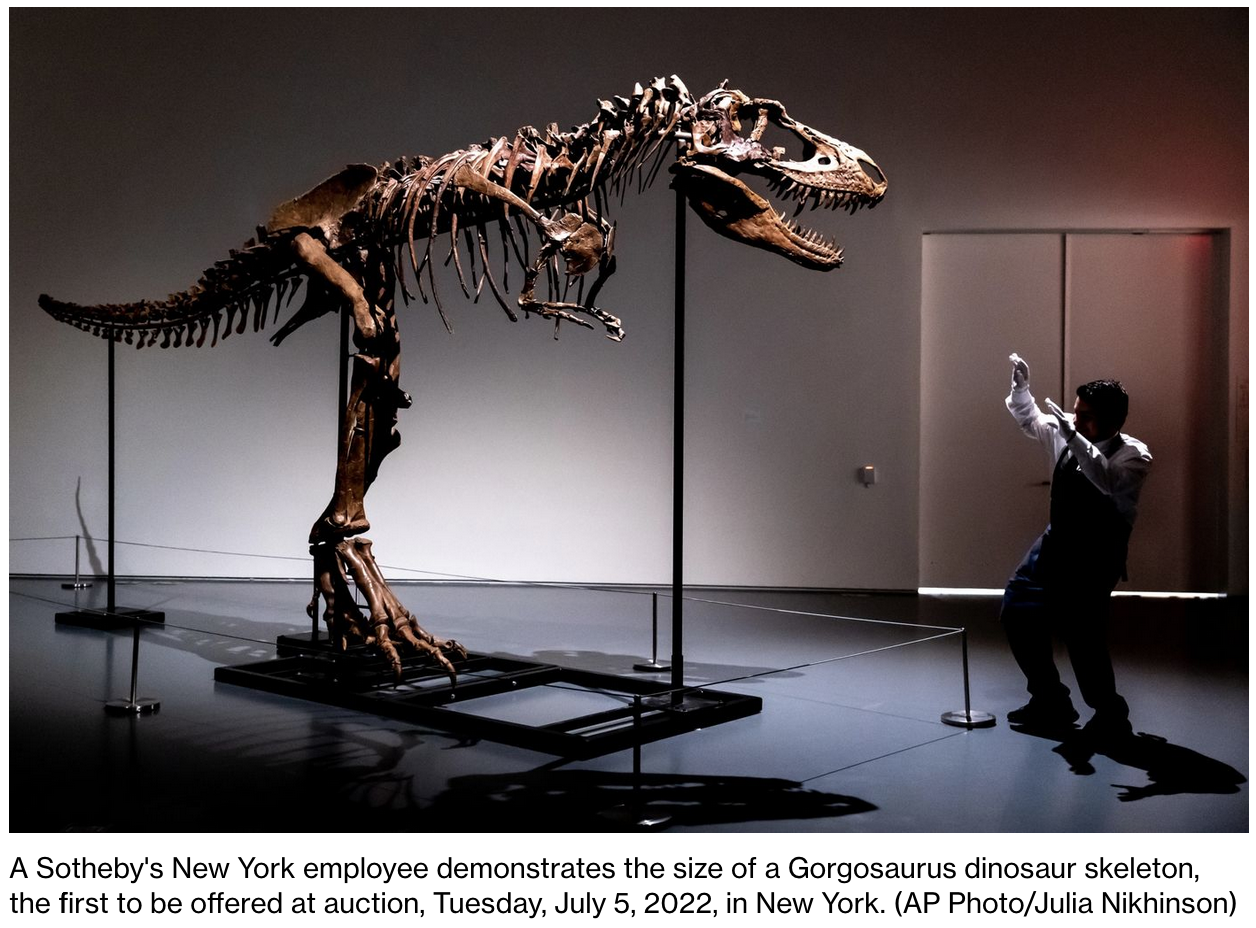
The fossilized skeleton of a T. rex relative that roamed the earth about 76 million years ago will be auctioned in New York this month, Sotheby’s announced Tuesday.
The Gorgosaurus skeleton will highlight Sotheby’s natural history auction on July 28, the auction house said.
The Gorgosaurus was an apex carnivore that lived in what is now the western United States and Canada during the late Cretaceous Period. It predated its relative the Tyrannosaurus rex by 10 million years.
The specimen being sold was discovered in 2018 in the Judith River Formation near Havre, Montana, Sotheby’s said. It measures nearly 10 feet (3 meters) tall and 22 (6.7 meters) feet long.
All of the other known Gorgosaurus skeletons are in museum collections, making this one the only specimen available for private ownership, the auction house said.
“In my career, I have had the privilege of handling and selling many exceptional and unique objects, but few have the capacity to inspire wonder and capture imaginations quite like this unbelievable Gorgosaurus skeleton,” Cassandra Hatton, Sotheby’s global head of science and popular culture, said.
Sotheby’s presale estimate for the fossil is $5 million to $8 million.
Updated: 7-19-2022
The World’s Oldest Trees Can Outlive Anything Except Humans
Megafires scorching the American West are threatening giant sequoias that have survived for thousands of years. But the wildfires aren’t the only threats they face.

What’s captured people’s attention about the Washburn fire raging in Yosemite isn’t just its size or scope, but the fact that it threatens a giant Sequoia with a name, Grizzly Giant, and an extreme age: It’s almost 3,000 years old.
The oldest trees have scientific as well as sentimental value. There’s something alarming about the thought that anything hardy enough to live through multiple millennia could now be in trouble.
As it turns out, climate change is not even the worst hazard the oldest trees face.
Trees possess a quality that humans had once attributed to gods: They don’t age. Or as forest ecologist Nathan Stephenson puts in a more scientifically accurate way, there’s a growing school of thought that trees don’t undergo senescence, a programmed slide toward decline and death that puts a limit on the lives of animals.
“They die from accidents, like getting attacked by bark beetles, getting burned in a fire … getting infected by a pathogen,” said Stephenson, who is a scientist emeritus with the USGS Western Ecological Research Center.
Someone once did a calculation, he said, that if humans didn’t senesce but only died when our luck ran out, the average lifespan would be about 700 years. Some unlucky people would die at five, and some lucky ones would live thousands of years.
Trees, including giant Sequoias, don’t have life expectancies of 3,000 or more years. Most never survive the sapling stage, and of those that reach adulthood, most never get to their 1,000th birthday. But a few can last thousands of years.
The only way to ascertain the age of a living tree is to take a pencil-thin section from the trunk and count the rings.
While scientists can pick up clues about which trees are likely to be very old, it’s almost inevitable that the oldest tree in the world is growing in a remote spot — unmeasured, unknown and unnamed.
But among known trees, the oldest grow in an arid set of jutting peaks called the White Mountains, near California’s border with Nevada.
They’re called bristlecone pines — mid-size trees, with gnarled branches that look like long-dead driftwood. The living bark and needles cover just a few strips and patches of the mostly dead wood.
Bristlecones have been measured at ages close to 5,000 years, having sprouted from seeds when humans were just inventing writing on clay tablets.
The oldest ones take root in the harshest environments — the driest, windiest, roughest mountains with the chalkiest soils — places inhospitable to predators, tree-eating beetles, tree-rotting microbes and smaller plants that might build up brushfire fuel.
The ones that live in nicer spots, such as the lower-elevation hills of Death Valley, are more vulnerable, and indeed, some of those are now dying, suffering from beetle infestations and other side effects of human-generated climate change.
The very oldest trees are good at standing up to changes in climate — that’s one of their superpowers — but there are some threats that even they can’t endure.
The world’s oldest recorded tree, called Prometheus, was killed in 1964. A scientist tried to take a core sample using drill called an increment borer. When the instrument got stuck in the tree, the researcher called the Forest Service for help.
They said there were plenty of old trees like this one and called in a crew with a chainsaw to cut it down. After the fact, the scientist, who was a graduate student at the time, counted the rings and discovered to his horror that it was nearly 5,000 years old. They’d just chopped down the world’s oldest tree.
The current oldest living tree, a bristlecone called Methuselah, endured the extraction of a tree ring core without harm, but spent years getting torn apart by tourists wanting a piece of bark. Now scientists try to keep its location secret.
Similar problems afflict a tree in Chile called Alerce Milenario, a cyprus scientists recently announced as a new contender for the world’s oldest tree.
It’s not the official record holder yet because it’s rotten and has lost some of its rings, and so the scientists had to estimate its age, which they claim is around 5,400 years.
Alerce Milenario is a charismatic giant tree and attracts tourists who are trampling its roots. Climate change it can handle, but it’s not adapted to being loved to death.
And for the giant Sequoias, there’s another threat. Stephenson said that the trees are well adapted to a natural cycle of fire, but not to the kinds of megafires that result when humans suppress fire for decades, allowing an explosive buildup of small trees, brush and other fuel.
When those finally catch, flames can rise more than 100 feet and burn the crowns. He said fires have killed 13% to 19% of all the giant Sequoias in the last few years alone.
Our current period of global warming and Southwestern drought are also contributing risk factors for megafires.
And of course, global warming is cause for alarm even if it spares the toughest, oldest trees. The more enduring threat of climate change is the collapse of complex ecosystems.
It will leave us in a diminished world, a world less able to provide food and clean water to billions of humans. The most weather-hardened gods, looking down from their Olympus, won’t miss us.
Updated: 8-5-2022
Male Sea Turtles Are In Short Supply As Temperatures Rise
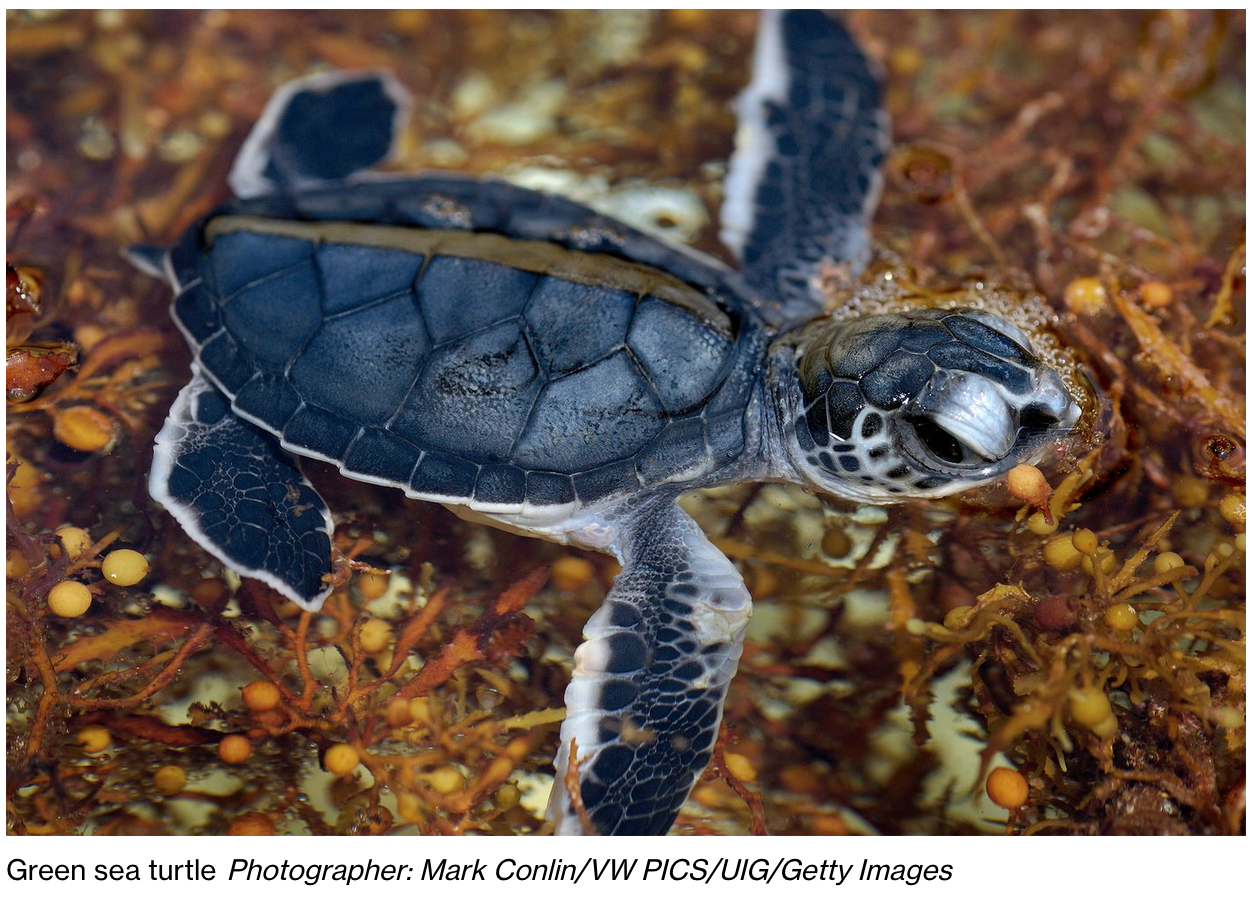
As intense heat waves become more commonplace across the US, researchers fear more volatile temperatures will stunt sea turtle populations.
In the Florida Keys, Bette Zirkelbach, who directs the Turtle Hospital in Marathon, is worried about the species’ fate, saying that in the past four years, researchers have only found female eggs and hatchlings just as the state has seen temperatures touch record highs.
Even though sea turtles are hatching, climate change bodes poorly for population dynamics. With few males mating with most of the females, genetic diversity decreases, which can prohibit successful breeding sessions and could mean that men pass on weak genes to an unknown number of offspring.
For turtles, who lay their eggs in nests dug into coastal sand, gender is temperature dependent, according to the National Ocean Service.
If a turtle’s eggs incubate below 81.86℉, they will come out as male. If eggs incubate at temperatures higher than 88.8℉, they will hatch as females.
Temperatures that fluctuate between the extremes will produce a mix of both male and females, a mix that is necessary for turtles to keep reproducing and surviving.
But the heat is not just exclusive to Florida’s coast as it has also crept up to North Carolina, where researchers are just beginning to see changes in male sea turtle populations.
“This pattern has been seen in Florida for quite some time because it’s hot in Florida and North Carolina is at a higher latitude, and so we tended to in the past have a more balanced sex ratio,” said Dr. Stephanie Kamel, an ecology professor at the University of North Carolina Wilmington.
Over the past 25 years, according to Kamel, the Tar Heel State has seen a sharp decline in the production of male hatchlings, with males making up less than 10% of hatchlings in 2015, compared to 50% in 1991.
“2015 is a long time ago now, right?” said Kamel. “So you can project four from 2015 to 2022, and that pattern [is] not changing.”
The National Ocean Service also warns that with warmer weather comes warmer sand, which could create “lethal” incubation conditions for the physiological health of sea turtles and other reptiles.
Zirkelbach warned that there is an increasing number of sea turtles battling fibropapillomatosis, a disease that causes tumors to grow on turtles in warmer waters in and around developed land.
Local wildlife resource departments should protect vulnerable sea turtles by implementing management plans for nests, said Kamel.
That includes cordoning off certain areas of beaches and coastlines to build shades over nests so that eggs can hatch at lower temperatures.
Yet much remains unknown for researchers tasked with protecting and defending the species, which has a life span of up to several decades.
“There’s just so much that we don’t know,” said Kamel. “It’s really hard to study a sea turtle just given their life history, right? They’re slow to grow, they’re endangered, they go offshore, then you can’t find them again for years and years and years.”
Updated: 8-16-2022
Startup Backed by Hemsworths, Paris Hilton Plans Tasmanian Tiger Revival
Dallas-based Colossal Biosciences, which is already working to bring back the woolly mammoth, now aims to resurrect a marsupial declared extinct in the 1930s.
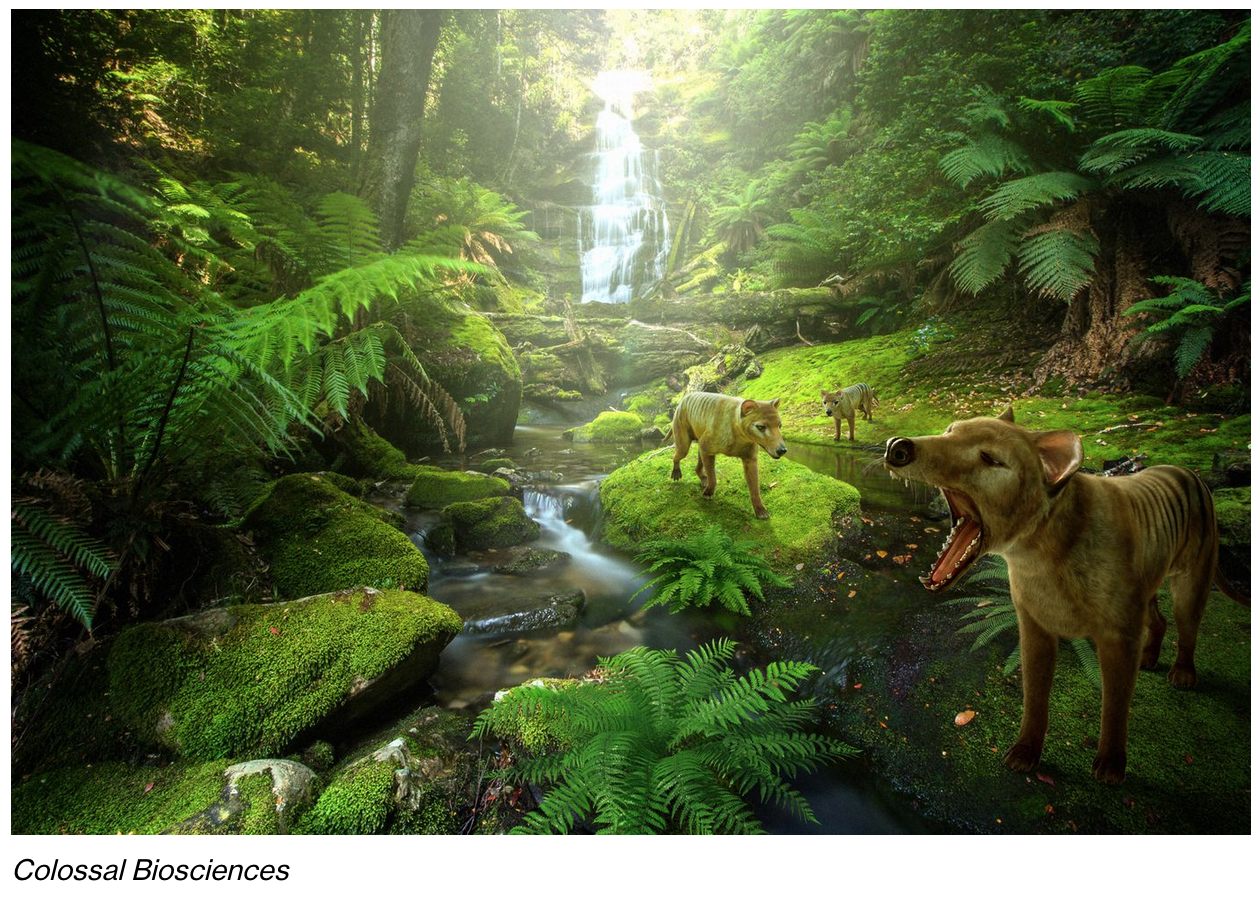
A Dallas-based company trying to resurrect the woolly mammoth has announced a new initiative to bring back the Tasmanian tiger, or the thylacine, a marsupial declared extinct in the 1930s.
Colossal Biosciences was started by Harvard geneticist George Church and technology entrepreneur Ben Lamm in September 2021 with $15 million in seed funding.
The company raised another $60 million six months after launching despite doubts over the feasibility of resurrecting extinct species.
Winklevoss Capital Management, motivational speaker Tony Robbins and Paris Hilton are among its investors.
Executives with Colossal say that by bringing back the thylacine, which was once widespread across mainland Australia and the islands of Tasmania and New Guinea, they can aid in efforts to re-balance Australian ecosystems that have suffered decades of sustained biodiversity loss.
The Tasmanian tiger was unique among marsupials with its iconic wolf-like appearance and diet of fresh meat. It was a quiet animal with thick black stripes on its body and, fully grown, measured about 6 feet from its nose tip to the tip of its tail.
Thylacines were hunted to extinction by European settlers who thought of them as a threat to Tasmania’s sheep industry.
Colossal plans to take cells from the thylacine’s closest living relatives, like the dunnart, and genetically engineer them with thylacine DNA.
“You’re actually putting all of those genomic changes into that living cell, and then in the end, you are left with a cell that is a thylacine cell, and you can turn that cell then back into a whole living animal,” said Andrew Pask, an evolutionary biologist who is leading Colossal’s efforts to revive the animal.
Similarly, Colossal would combine genetic material from Asian elephants with frozen woolly mammoth DNA to bring back a version of the latter species.
Not all experts are convinced by Colossal’s plans. Critics have called such experiments a distraction and say if they succeed their effects on the climate and ecosystems would be unpredictable.
Thomas Gilbert, a paleo-geneticist at the University of Copenhagen in Denmark, tested the possibility of resurrecting the Christmas Island or Maclear’s rat. Gilbert’s team had well-preserved DNA samples and abundant reference data from the animal’s cousin, the Norway rat.
Yet even with all that information, he says, the researchers were unable to sequence the remaining 5% of the Maclear’s rat’s genome — leaving out important attributes like immunity and smell.
“If you have a million [genetic] differences between an elephant and a mammoth, you can’t necessarily change any one of those without there being a problem,” Gilbert said in an interview. “If I take a … Honda car, and if you try and put tractor tires on it or truck tires, it’s not gonna work, right?”
But Michael Archer, a paleontologist at the University of New South Wales in Sydney who does not have a relationship with Colossal Biosciences, says that efforts aimed at de-extinction are fundamentally necessary.
“It may well be enormously challenging and certainly a lot of work, but we can be certain of one thing — extinct animals will definitely stay extinct if we don’t try these things,” he said. “Some projects are moving forward quickly; others will take more time. In principle there is no fundamental reason why de-extinction should not be possible now or in the near future.”
Colossal’s most recent round of funding drew investment from entertainment world figures like Thomas Tull, former chief executive officer of Legendary Entertainment, and the Hemsworth family.
“The Tassie Tiger’s extinction had a devastating effect on our ecosystem and we are thrilled to support the revolutionary conservation efforts that are being made by Dr. Pask and the entire Colossal team,” actor Chris Hemsworth said in a statement.
A Belgian City Opens A Hotel For An Unusual Clientele: Insects
Habitats built for bugs draw attention to the decline and endangerment of many species, a development some researchers see as a global threat in coming years.

Deurne, Belgium—When the local government in this small city just outside Antwerp set out to build its newest hotel, it wasn’t hoping to draw in businesspeople or tourists. Instead, its target clientele is insects: beetles, woodlice, hoverflies, butterflies and bees.
Related:
How To Make An Insect Hotel: 10 Steps (With Pictures)
Opened in July, Deurne’s “insect hotel” is part of a trend across Europe led by educational institutions, conservation groups, and local governments to find innovative ways to preserve biodiversity that also raise awareness.
Cities including Basel, Switzerland, are investing heavily in green-roof technology, where vegetation is planted on the tops of buildings, while nonprofits are pushing to create “rewilded” natural landscapes for wildlife and plants in Portugal, Bulgaria and Romania. Deurne is already planning a second bug habitat.
Scientists say insects are a key to biodiversity efforts aimed at protecting plants, animals and ecosystems, as 80% of all organisms on earth are insects.
Three-quarters of leading global crops and almost 90% of wild plants depend on animal pollinators including bees, according to the World Wide Fund for Nature.
Insect populations have plummeted in recent decades, hit by the combined forces of industrial agriculture, deforestation and extreme weather patterns.
Over 40% of all insect species are in decline, and a third are endangered, according to a 2019 article in the peer-reviewed journal Biological Conservation. A quarter of insects could be wiped out by 2030, the researchers forecast.

In one of the more unusual efforts prompted by such findings, universities and conservation societies across Europe are working with local communities and schools to construct the habitats for bugs known as insect hotels.
These structures actually function more like a housing complex. Bugs lay eggs inside different “apartments” and bring food, like pollen from nearby flowers, to provide for offspring. In colder months, insects will use the structure to hibernate.
In the U.K., Manchester Metropolitan University has worked with local organizations and schools to build an insect hotel on its campus using found materials.
German national railway company Deutsche Bahn installed an insect hotel at a train station outside Hamburg. The four-star Thon Hotel EU in central Brussels features its own insect hotel and beehives—producing nearly 90 pounds of honey this year.
Bugs may not seem the most appealing feature at a hotel for humans. But at the Thon Hotel EU, which has an ecological certification, people always want to learn about the insect hotel, says Kelly Gallier, who is in charge of the location’s green initiatives.
In recent years, as Green political parties gained power across Europe, environmental issues have moved to the forefront. The environment ministry in Flanders, the Flemish-speaking part of northern Belgium where Deurne is located, recently released a plan to halve the use of harmful pesticides by 2030 and introduce educational programs on insects’ role in local ecosystems, among other initiatives.
Zuhal Demir, the environment minister of Flanders, posed for a magazine covered in bees ahead of Bee Week in May. Hollywood actor Angelina Jolie famously did the same for National Geographic last year.
Similarly, bug hotels function as a physical reminder to local residents of the importance of insects, in addition to providing them with homes.
“These hotels are useful to raise awareness among people that they, in their own gardens and terraces, can do so much to protect pollinators,” says Ruth-Marie Henckes of Greenpeace Belgium.
Deurne’s insect hotel, a 36-foot-long structure built from locally sourced wood, is billed as the largest insect hotel in Belgium. It is situated in a local cemetery, where a nearby meadow left to grow wild provides ample food.

Tjerk Sekeris, the town mayor, says some older people in the community initially didn’t like the tall grass growing near the graves, but have grown used to it.
“You don’t have to clean it,” says Michiel Delagrange, an environmental expert employed by the city of Deurne, as he showed off the hotel’s straw beds and pine-cone shelters on a recent July day. “You just have to let it be.”
The best insect hotels mimic nature, says Jens D’Haeseleer, a wild-bee researcher at Natuurpunt, the largest conservation nonprofit in Flanders.
In nature, hatching wood beetles drill small holes to emerge from dead trees. Solitary bees—species that don’t live in hives but are important pollinators—then make their nests in these holes.
It’s easy to go wrong with insect hotels. Different bee species prefer different-size holes, some as small as a tenth of an inch in diameter. Wrong-size holes in insect hotels won’t attract the right bees.
They can also lead to disaster if an electric drill leaves a splinter inside. “Bees have four wings, but if there are splinters they will come out with three wings, and soon have no wings at all,” Mr. D’Haeseleer says.
These habitats can also be a magnet for parasitic bugs, such as parasitic bees or flies. Some research has shown that building many artificial nesting sites together—as in an insect hotel—can increase the loss of bees, as parasitic insects eat the pollen other bees have collected, starving their offspring.
Mr. D’Haeseleer notes parasitic insects wouldn’t damage the hotel structure, and that new insects would come to the empty hotel after the others have died.
Deurne’s insect hotel has few inhabitants this summer, as insects in the area build their nests in colder months. Mr. Sekeris says the city has plans to build a second hotel in another cemetery.
Much more than insect hotels is needed to tackle biodiversity loss that, if left unaddressed, could prove irreversible, environmental advocates say.
Still, it’s often helpful to start small, some say.
“Big policy changes seem farther away at times,” says Ms. Henckes of Greenpeace Belgium. “Sometimes it’s good to think: What can I do this summer in my garden?”
Updated: 8-17-2022
Bees Increasingly Stressed by Climate Change Over The Past 100 Years – Study

Bees have become increasingly stressed by climate change over the past 100 years, museum collections indicate.
An analysis of bumblebee wings from a network of UK institutions shows signs of stress linked to conditions getting hotter and wetter.
As well as revealing what is linked to stress in bees in the past, the study can help predict when and where bees will face most stress and potential decline in the future, researchers suggest.
Scientists from Imperial College London and the Natural History Museum have published two papers analysing UK bumblebee populations.
The first investigated the body shapes of bee specimens dating back to 1900.
Using digital images, researchers looked at asymmetry in bumblebee wings as an indicator of stress.
High asymmetry – very differently shaped right and left wings – indicated the creatures experienced stress during development – an external factor that affected their normal growth.
Looking at four UK bumblebee species, the group found evidence of stress getting higher as the century progressed from its lowest point around 1925.
Further analysis, published in the Journal of Animal Ecology, showed that each species displayed a consistently higher proxy of stress in the latter half of the century.
When assessing the climate conditions during the year of collection, the team found that in hotter and wetter years bees showed higher wing asymmetry.
Co-author Aoife Cantwell-Jones, from the department of life sciences (Silwood Park) at Imperial College London, said: “By using a proxy of stress visible on the bee’s external anatomy and caused by stress during development just days or weeks before, we can look to more accurately track factors placing populations under pressure through historic space and time.”
Co-author Dr Andres Arce, now at the University of Suffolk, added: “Our goal is to better understand responses to specific environmental factors and learn from the past to predict the future.
“We hope to be able to forecast where and when bumblebees will be most at risk and target effective conservation action.”
Senior co-author Dr Richard Gill, also from Imperial, said: “With hotter and wetter conditions predicted to place bumblebees under higher stress, the fact these conditions will become more frequent under climate change means bumblebees may be in for a rough time over the 21st century.”
In a second study, published in Methods in Ecology & Evolution, the team successfully sequenced the genomes of more than a hundred bumblebee museum specimens dating back more than 130 years.
They used methods typically used for studying woolly mammoths and ancient humans on an insect population for the first time.
As well as providing a new reference genome, the team will now use this data to study how bee genomes have changed over time, gaining an understanding of how whole populations have adapted – or not – to changing environments.
Co-author Dr Victoria Mullin, from the Natural History Museum, said: “Museum insect collections offer an unparalleled opportunity to directly study how the genomes of populations and species have been affected by environmental changes through time.
“However, they are a finite resource and understanding how best to utilise them for genetic studies is important.”
Related Articles:
Bitcoin Information & Resources (#GotBitcoin?)
Bitcoin For Corporations | Michael Saylor | Bitcoin Corporate Strategy
Japan’s $1 Trillion Crypto Market May Ease Onerous Listing Rules
How Bitcoin Contributions Funded A $1.4M Solar Installation In Zimbabwe
BREAKING: Arizona State Senator Introduces Bill To Make Bitcoin Legal Tender
Vast Troves of Classified Info Undermine National Security, Spy Chief Says
Inflation And A Tale of Cantillionaires
America COMPETES Act Would Be Disastrous For Bitcoin Cryptocurrency And More
Petition Calling For Resignation Of U.S. Securities/Exchange Commission Chair Gary Gensler
McDonald’s Jumps On Bitcoin Memewagon, Crypto Twitter Responds
Smart Money Is Buying Bitcoin Dip. Stocks, Not So Much
Henrietta Lacks And Her Remarkable Cells Will Finally See Some Payback
Stealing The Blood Of The Young May Make You More Youthful
Doctors Show Implicit Bias Towards Black Patients
Indexing Is Coming To Crypto Funds Via Decentralized Exchanges
Imagine There’s No Bitcoin. If You Can, Then We Haven’t Done Our Jobs
US Stocks Historically Deliver Strong Gains In Fed Hike Cycles (GotBitcoin)
Federal Regulator Says Credit Unions Can Partner With Crypto Providers
Jack Dorsey Announces Bitcoin Legal Defense Fund
Four Ways Black Families Can Fight Against Rising Inflation (#GotBitcoin)
Bitcoin’s Dominance of Crypto Payments Is Starting To Erode
Walmart Filings Reveal Plans To Create Cryptocurrency, NFTs
Ultimate Resource On Duke of York’s Prince Andrew And His Sex Scandal
FDA Approves First-Ever Arthritis Pain Management Drug For Cats
Is Art Therapy The Path To Mental Well-Being?
Arkansas Tries A New Strategy To Lure Tech Workers: Free Bitcoin
Wordle Is The New Lingo Turning Fans Into Argumentative Strategy Nerds
Nas Selling Rights To Two Songs Via Crypto Music Startup Royal
Teen Cyber Prodigy Stumbled Onto Flaw Letting Him Hijack Teslas
Joe Rogan: I Have A Lot Of Hope For Bitcoin
How Black Businesses Can Prosper From Targeting A Trillion-Dollar Black Culture Market (#GotBitcoin)
‘Yellowstone’ Is A Huge Hit That Started With Small-Town Fans
Sidney Poitier, Actor Who Made Oscars History, Dies At 94
How Jessica Simpson Almost Lost Her Name And Her Billion Dollar Empire
Ultimate Resource On Solana Outages And DDoS Attacks
Ultimate Resource On Kazakhstan As Second In Bitcoin Mining Hash Rate In The World After US
Nasdaq-Listed Blockchain Firm BTCS To Offer Dividend In Bitcoin; Shares Surge
Bitcoin Enthusiast And CEO Brian Armstrong Buys Los Angeles Home For $133 Million
Ultimate Resource On A Strong Dollar’s Impact On Bitcoin
Ultimate Resource On Bitcoin Unit Bias
Yosemite Is Forcing Native American Homeowners To Leave Without Compensation. Here’s Why
Raoul Pal Believes Institutions Have Finished Taking Profits As Year Winds Up
10 Women Who Used Crypto To Make A Difference In 2021
Disposable Masks That Don’t Pollute
Move Over, Tennis And Golf. Networks And Brands Are Cashing In On Pickleball
Athletes Unlimited Signs Big Sponsor In Boost For Women’s Sports
Grounded By The Pandemic? Donate Your Unused Points And Miles
Crypto And Its Many Fees: What To Know About The Hidden Costs Of Digital Currency
Deputizing Blockchain To Fight Corrupt Governments. Also America Blows It’s Tokenization Advantage
Crypto Attracts More Money In 2021 Than All Previous Years Combined
The US Shouldn’t Be Afraid of China
Ultimate Resource On Donald J. Trump
Ubiquitous Surveillance And Security
Finding Your Superpower In A Higher-Priced World With On-The-Spot Comparison Shopping
How remanufacturing is combating global warming
Shoppers Lined Up At Dawn For The ‘Open Run’ On $9,500 Chanel Bags
How Banks Win When Interest Rates Rise (#GotBitcoin)
Crypto, NFTs And Tungsten Cubes: A Guide To Giving Cash In 2021
Tech Giants Apple, Microsoft, Amazon And Others Warn of Widespread Software Flaw
Ultimate Resource On Web3 And Crypto’s Attempt To Reinvent The Internet
Bitcoin Core Developer Samuel Dobson Decides It Is ‘Time To Go’
The Biden Economy Is Actually Pretty Good
Live: House Memo Details Congress’ Priorities Ahead Of Crypto CEO Hearing
Verizon is Tracking iPhone Users by Default And There’s Nothing Apple Can Do. How to Turn It Off
A Plant-based Pet Food Frenzy Is On The Horizon
What Is Cryptocurrency, And How Does It Work?
One Of The Weirdest Reports: Investors React To 12-3-2021 Jobs Data (#GotBitcoin)
Ultimate Resource On China’s ‘Common Prosperity’ Drive How It Plans To Redistribute The Wealth
Note To Brands: Crypto Isn’t Funny Money. It’s Community
How Crypto Vigilantes Are Hunting Scams In A $100 Billion Market
6 Questions For Lyn Alden Schwartzer Of Lyn Alden Investment Strategy
Bitcoin Offers Little Refuge From Covid Market Rout
The Anti-Work Brigade Targets Amazon On Black Friday
Reddit’s Latest Money-Making Obsession Is An Obscure Fed Facility (Reverse Repo or RRP)
Federal Reserve To Taper Money Printing That Fueled Bitcoin Rally
Apple Sues NSO Group To Curb The Abuse Of State-Sponsored Spyware
Did You Buy Your Cat or Dog A Christmas Present? Join The Club
Gen Z Has $360 Billion To Spend, Trick Is Getting Them To Buy (#GotBitcoin)
10 Fundamental Rights For All Crypto Users Including Responsibilities For The Industry
Texas Plans To Become The Bitcoin Capital, Vulnerable Power Grid And All
Bitcoin Caught Between Longer-Term Buyers, Leveraged Speculators
Outcry Grows As China Breaks Silence On Missing Tennis Star
China Left In Shock Following Brutal Killing Of Corgi During Covid-19 Disinfection
Biden Orders Feds To Tackle ‘Epidemic’ Of Missing Or Murdered Indigenous People
An Antidote To Inflation? ‘Buy Nothing’ Groups Gain Popularity
Ultimate Resource For Cooks, Chefs And The Latest Food Trends
Open Enrollment Gameplan: How To Compare Your Partner’s Health Insurance With Yours
Millions Of Americans Are Skipping The Dentist. Lenders See A Financing Niche
Matt Damon To Promote Crypto.Com In Race To Lure New Users
US General Likens China’s Hypersonic Missile Test To A ‘Sputnik Moment’
The Key To Tracking Corona And Other Any Virus Could Be Your Poo
How To Evade A Chinese Bitcoin Ban
US Government Failed To Spot Pedophile At Indian Health Service Hospitals
Netflix Defends Dave Chappelle While Seeing “Squid Game” Become It’s Biggest Hit Ever
Ultimate Resource On Various Countries Adopting Bitcoin
Ultimate Resource On Bitcoin Billionaires
Stripe Re-Enters Processing Payments Using Cryptos 3 Years After Dropping Bitcoin
Why Is My Cat Rubbing His Face In Ants?
Pets Score Company Perks As The ‘New Dependents’
What Pet Owners Should Know About Chronic Kidney Disease In Dogs And Cats
The Facebook Whistleblower, Frances Haugen, Says She Wants To Fix The Company, Not Harm It
Walk-in Cryptocurrency Exchanges Emerge Amid Bitcoin Boom
Europe’s Giant Job-Saving Experiment Pays Off In Pandemic
To Survive The Pandemic, Entrepreneurs Might Try Learning From Nature
Rise of The FinFluencer And How They Target Young And Inexperienced Investors
Hyperinflation Concerns Top The Worry List For UBS Clients
Sotheby’s Opens First-Ever Exhibition of Black Jewelry Designers
America And Europe Face Bleak Winter As Energy Prices Surge To Record Levels
Ultimate Resource On Vaccine Boosters
Unvaccinated COVID-19 Hospitalizations Cost The U.S. Health System Billions Of Dollars
Wallets Are Over. Your Phone Is Your Everything Now
Crypto Mining Demand Soars In Vietnam Amid Bitcoin Rally
How The Supreme Court Texas Abortion Ruling Spurred A Wave Of ‘Rage Giving’
Ultimate Resource On Global Inflation And Rising Interest Rates (#GotBitcoin)
Presearch Decentralized Crypto-Powered Search Engine
How To Make Vietnam A Powerful Trade Ally For The U.S.
Banking Could Go The Way of News Publishing (#GotBitcoin)
Operation “Choke Point”: An Aggressive FTC And The Response of The Payment Systems Industry
Bezos-Backed Fusion Startup Picks U.K. To Build First Plant
TikTok Is The Place To Go For Financial Advice If You’re A Young Adult
More Companies Weigh Penalizing Employees Without Covid-19 Vaccinations
Crypto Firms Want Fed Payment Systems Access—And Banks Are Resisting
Travel Expert Oneika Raymond’s Favorite Movies And Shows
How To Travel Luxuriously In The Summer Of Covid-19, From Private Jets To Hotel Buyouts
Nurses Travel From Coronavirus Hot Spot To Hot Spot, From New York To Texas
Travel Is Bouncing Back From Coronavirus, But Tourists Told To Stick Close To Home
Tricks For Making A Vacation Feel Longer—And More Fulfilling
Who Is A Perpetual Traveler (AKA Digital Nomad) Under The US Tax Code
Four Stories Of How People Traveled During Covid
Director Barry Jenkins Is The Travel Nerd’s Travel Nerd
Why Is My Cat Rubbing His Face In Ants?
Natural Cure For Hyperthyroidism In Cats Including How To Switch Him/Her To A Raw Food Diet
A Paycheck In Crypto? There Might Be Some Headaches
About 46 Million Americans Or 17% Now Own Bitcoin vs 50% Who Own Stocks
Josephine Baker Is 1st Black Woman Given Paris Burial Honor
Cryptocurrency’s Surge Leaves Global Watchdogs Trying To Catch Up
It Could Just Be The U.S. Is Not The Center Of The Crypto Universe
Blue Turmeric Is The Latest Super Spice To Shake Up Pantry Shelves
Vice President Kamala Harris To Focus On Countering China On Southeast Asia Trip
The Vaccinated Are Worried And Scientists Don’t Have Answers
Silver Lining of Coronavirus, Return of Animals, Clear Skies, Quiet Streets And Tranquil Shores
Cocoa Cartel Stirs Up Global Chocolate Market With Increased Use Of Child Labor
Killer Whale Dies Suddenly At SeaWorld San Diego
Does Getting Stoned Help You Get Toned? Gym Rats Embrace Marijuana
Hope Wiseman Is The Youngest Black Woman Dispensary Owner In The United States
What Sex Workers Want To Do With Bitcoin
How A Video Résumé Can Get You Hired In The Covid-19 Job Market
US Lawmakers Urge CFTC And SEC To Form Joint Working Group On Digital Assets
Bitcoin’s Surge Lacks Extreme Leverage That Powered Past Rallies
JP Morgan Says, “Proof-Of-Stake Will Eat Proof-Of-Work For Breakfast — Here’s Why
Ranking The Currencies That Could Unseat The Dollar (#GotBitcoin)
The Botanist Daring To Ask: What If Plants Have Intelligence?
After A Year Without Rowdy Tourists, European Cities Want To Keep It That Way
Prospering In The Pandemic, Some Feel Financial Guilt And Gratitude
The Secret Club For Billionaires Who Care About Climate Change
A List Of Relief Funds For Restaurants, Bars, And Food Service Workers
Bill And Melinda Gates Welcome The Philanthropists Of The Future
CO2-Capture Plan Using Old Oil Reservoirs In Denmark Moves Ahead
Could This Be The Digital Nose Of The Future?
Bitcoin Fans Are Suddenly A Political Force
Walmart Seeks Crypto Product Lead To Drive Digital Currency Strategy
Music Distributor DistroKid Raises Money At $1.3 Billion Valuation
Books To Read, Foods To Eat, Movies To Watch, Exercises To Do And More During Covid19 Lockdown
Hacker Claims To Steal Data Of 100 Million T-Mobile Customers
Is The Cryptocurrency Epicenter Moving Away From East Asia?
Vietnam Leads Crypto Adoption In Finder’s 27-Country Survey
Bitcoin’s Latest Surge Lacks Extreme Leverage That Powered Past Rallies
Creatine Supplementation And Brain Health
Nigerian State Says 337 Students Missing After Gunmen Attack
America’s 690 Mile-Long Yard Sale Entices A Nation of Deal Hunters
Russian Economy Grew (10.3% GDP) Fastest Since 2000 On Lockdown Rebound
US Troops Going Hungry (Food Insecurity) Is A National Disgrace
Overheated, Unprepared And Under-protected: Climate Change Is Killing People, Pets And Crops
Accenture Confirms Hack After LockBit Ransomware Data Leak Threats
Climate Change Prompts These Six Pests To Come And Eat Your Crops
Leaked EU Plan To Green Its Timber Industry Sparks Firestorm
Students Take To The Streets For Day Of Action On Climate Change
Living In Puerto Rico, Where The Taxes Are Low And Crypto Thrives
Bitcoin Community Leaders Join Longevity Movement
Some Climate Change Effects May Be Irreversible, U.N. Panel Says
Israel’s Mossad Intelligence Agency Is Seeking To Hire A Crypto Expert
What You Should Know About ‘529’ Education-Savings Accounts
Bitcoin Doesn’t Need Presidents, But Presidents Need Bitcoin
Plant-Based Fish Is Rattling The Multibillion-Dollar Seafood Industry
The Scientific Thrill Of The Charcoal Grill
Escaping The Efficiency Trap—and Finding Some Peace of Mind
Sotheby’s Selling Exhibition Celebrates 21 Black Jewelry Designers
Marketers Plan Giveaways For Covid-19 Vaccine Recipients
Haiti’s President Moise Assassinated In Night Attack On His Home
The Argentine River That Carries Soybeans To World Is Drying Up
A Harvard Deal Tries To Break The Charmed Circle Of White Wealth
China Three-Child Policy Aims To Rejuvenate Aging Population
California Wants Its Salton Sea Located In The Imperial Valley To Be ‘Lithium Valley’
Who Will Win The Metaverse? Not Mark Zuckerberg or Facebook
The Biggest Challenge For Crypto Exchanges Is Global Price Fragmentation
London Block Exchange – LBX Buy, Sell & Trade Cryptocurrencies?
Chicago World’s Fair Of Money To Unveil A Private Coin Collection Worth Millions of Dollars
Bitcoin Dominance On The Rise Once Again As Crypto Market Rallies
Uruguayan Senator Introduces Bill To Enable Use Of Crypto For Payments
Talen Energy Investors Await Update From The Top After Pivot To Crypto
Ultimate Resource On Hydrogen And Green Hydrogen As Alternative Energy
Covid Made The Chief Medical Officer A C-Suite Must
When Will Stocks Drop? Watch Profit Margins (And Get Nervous)
Behind The Rise Of U.S. Solar Power, A Mountain of Chinese Coal
‘Buy Now, Pay Later’ Installment Plans Are Having A Moment AgainUS Crypto Traders Evade Offshore Exchange Bans
5 Easy Ways Crypto Investors Can Make Money Without Needing To Trade
What’s A ‘Pingdemic’ And Why Is The U.K. Having One?
“Crypto-Property:” Ohio Court Says Crypto-Currency Is Personal Property Under Homeowners’ Policy
Retinal And/Or Brain Photon Emissions
Antibiotic Makers Concede In The War On Superbugs (#GotColloidalSilver)
What It Takes To Reconnect Black Communities Torn Apart by Highways
Those Probiotics May Actually Be Hurting Your ‘Gut Health’ We’re Not Prepared To Live In This Surveillance Society
How To Create NFTs On The Bitcoin Blockchain
World Health Organization Forced Valium Into Israeli And Palestinian Water Supply
Blockchain Fail-Safes In Space: Spacechain, Blockstream And Cryptosat
What Is A Digital Nomad And How Do You Become One?
Flying Private Is Cheaper Than You Think — Here Are 6 Airlines To Consider For Your Next Flight
What Hackers Can Learn About You From Your Social-Media Profile
How To Protect Your Online Privacy While Working From Home
Rising Diaper Prices Prompt States To Get Behind Push To Pay
Want To Invest In Cybersecurity? Here Are Some ETFs To Consider
US Drops Visa Fraud Cases Against Five Chinese Researchers
Risks To Great Barrier Reef Could Thwart Tycoon’s Coal Plans
The Super Rich Are Choosing Singapore As The World’s Safest Haven
Jack Dorsey Advocates Ending Police Brutality In Nigeria Through Bitcoin
Psychedelics Replace Pot As The New Favorite Edgy Investment
Who Gets How Much: Big Questions About Reparations For Slavery
US City To Pay Reparations To African-American Community With Tax On Marijuana Sales
Crypto-Friendly Investment Search Engine Vincent Raises $6M
Trading Firm Of Richest Crypto Billionaire Reveals Buying ‘A Lot More’ Bitcoin Below $30K
Bitcoin Security Still A Concern For Some Institutional Investors
Weaponizing Blockchain — Vast Potential, But Projects Are Kept Secret
China Is Pumping Money Out Of The US With Bitcoin
Tennessee City Wants To Accept Property Tax Payments In Bitcoin
Currency Experts Say Cryptonotes, Smart Banknotes And Cryptobanknotes Are In Our Future
Housing Insecurity Is Now A Concern In Addition To Food Insecurity
Food Insecurity Driven By Climate Change Has Central Americans Fleeing To The U.S.
Eco Wave Power Global (“EWPG”) Is A Leading Onshore Wave Energy Technology Company
How And Why To Stimulate Your Vagus Nerve!
Green Finance Isn’t Going Where It’s Needed
Shedding Some Light On The Murky World Of ESG Metrics
SEC Targets Greenwashers To Bring Law And Order To ESG
Spike Lee’s TV Ad For Crypto Touts It As New Money For A Diverse World
Bitcoin Network Node Count Sets New All-Time High
Tesla Needs The Bitcoin Lightning Network For Its Autonomous ‘Robotaxi’ Fleet
How To Buy Bitcoin: A Guide To Investing In The Cryptocurrency
How Crypto is Primed To Transform Movie Financing
Paraguayan Lawmakers To Present Bitcoin Bill On July 14
Bitcoin’s Biggest Hack In History: 184.4 Billion Bitcoin From Thin Air
Paul Sztorc On Measuring Decentralization Of Nodes And Blind Merge Mining
Reality Show Is Casting Crypto Users Locked Out Of Their Wallets
EA, Other Videogame Companies Target Mobile Gaming As Pandemic Wanes
Strike To Offer ‘No Fee’ Bitcoin Trading, Taking Aim At Coinbase And Square
Coinbase Reveals Plans For Crypto App Store Amid Global Refocus
Mexico May Not Be Following El Salvador’s Example On Bitcoin… Yet
What The Crypto Crowd Doesn’t Understand About Economics
My Local Crypto Space Just Got Raided By The Feds. You Know The Feds Scared Of Crypto
My Local Crypto Space Just Got Raided By The Feds. You Know The Feds Scared Of Crypto
Bitcoin Slumps Toward Another ‘Crypto Winter’
NYC’s Mayoral Frontrunner Pledges To Turn City Into Bitcoin Hub
Lyn Alden On Bitcoin, Inflation And The Potential Coming Energy Shock
$71B In Crypto Has Reportedly Passed Through ‘Blockchain Island’ Malta Since 2017
Startups Race Microsoft To Find Better Ways To Cool Data Centers
Why PCs Are Turning Into Giant Phones
Panama To Present Crypto-Related Bill In July
Hawaii Had Largest Increase In Demand For Crypto Out Of US States This Year
What To Expect From Bitcoin As A Legal Tender
Petition: Satoshi Nakamoto Should Receive The Nobel Peace Prize
Can Bitcoin Turbo-Charge The Asset Management Industry?
Bitcoin Interest Drops In China Amid Crackdown On Social Media And Miners
Multi-trillion Asset Manager State Street Launches Digital Currency Division
Wall Street’s Crypto Embrace Shows In Crowd At Miami Conference
MIT Bitcoin Experiment Nets 13,000% Windfall For Students Who Held On
Petition: Let’s Make Bitcoin Legal Tender For United States of America
El Salvador Plans Bill To Adopt Bitcoin As Legal Tender
What Is Dollar Cost Averaging Bitcoin?
Paxful Launches Tool Allowing Businesses To Receive Payment In Bitcoin
CEOs Of Top Russian Banks Sberbank And VTB Blast Bitcoin
President of El Salvador Says He’s Submitting Bill To Make Bitcoin Legal Tender
Bitcoin Falls As Weibo Appears To Suspend Some Crypto Accounts
Israel-Gaza Conflict Spurs Bitcoin Donations To Hamas
Bitcoin Bond Launch Brings Digital Currency Step Closer To ‘World Of High Finance’
Worst Month For BTC Price In 10 Years: 5 Things To Watch In Bitcoin
Bitcoin Card Game Bitopoly Launches
Carbon-Neutral Bitcoin Funds Gain Traction As Investors Seek Greener Crypto
Ultimate Resource On The Bitcoin Mining Council
Libertarian Activists Launch Bitcoin Embassy In New Hampshire
Why The Bitcoin Crash Was A Big Win For Cryptocurrencies
Treasury Calls For Crypto Transfers Over $10,000 To Be Reported To IRS
Crypto Traders Can Automate Legal Requests With New DoNotPay Services
Bitcoin Marches Away From Crypto Pack In Show of Resiliency
NBA Top Shot Lawsuit Says Dapper’s NFTs Need SEC Clampdown
Maximalists At The Movies: Bitcoiners Crowdfunding Anti-FUD Documentary Film
Caitlin Long Reveals The ‘Real Reason’ People Are Selling Crypto
Microsoft Quietly Closing Down Azure Blockchain In September
How Much Energy Does Bitcoin Actually Consume?
Bitcoin Should Be Priced In Sats And How Do We Deliver This Message
Bitcoin Loses 6% In An Hour After Tesla Drops Payments Over Carbon Concerns
Crypto Twitter Decodes Why Zuck Really Named His Goats ‘Max’ And ‘Bitcoin’
Bitcoin Pullback Risk Rises As Whales Resume Selling
Thiel-Backed Block.one Injects Billions In Crypto Exchange
Sequoia, Tiger Global Boost Crypto Bet With Start-up Lender Babel
Here’s How To Tell The Difference Between Bitcoin And Ethereum
In Crypto, Sometimes The Best Thing You Can Do Is Nothing
Crypto Community Remembers Hal Finney’s Contributions To Blockchain On His 65Th Birthday
DJ Khaled ft. Nas, JAY-Z & James Fauntleroy And Harmonies Rap Bitcoin Wealth
The Two Big Themes In The Crypto Market Right Now
Crypto Could Still Be In Its Infancy, Says T. Rowe Price’s CEO
Governing Body Of Louisiana Gives Bitcoin Its Nod Of Approval
Sports Athletes Getting Rich From Bitcoin
Behind Bitcoin’s Recent Slide: Imploding Bets And Forced Liquidations
Bad Omen? US Dollar And Bitcoin Are Both Slumping In A Rare Trend
Wall Street Starts To See Weakness Emerge In Bitcoin Charts
Crypto For The Long Term: What’s The Outlook?
Mix of Old, Wrong And Dubious ‘News/FUD’ Scares Rookie Investors, Fuels Crypto Selloff
Wall Street Pays Attention As Bitcoin Market Cap Nears The Valuation Of Google
Bitcoin Price Drops To $52K, Liquidating Almost $10B In Over-Leveraged Longs
Bitcoin Funding Rates Crash To Lowest Levels In 7 Months, Peak Fear?
Investors’ On-Chain Activity Hints At Bitcoin Price Cycle Top Above $166,000
This Vegan Billionaire Disrupted The Crypto Markets. Now He Wants To Tokenize Stocks
Black Americans Are Embracing Bitcoin To Make Up For Stolen Time
Rap Icon Nas Could Net $100M When Coinbase Lists on Nasdaq
The First Truly Native Cross-Chain DEX Is About To Go Live
Reminiscing On Past ‘Bitcoin Faucet’ Website That Gave Away 19,700 BTC For Free
3X As Many Crypto Figures Make It Onto Forbes 2021 Billionaires List As Last Year
Bubble Or A Drop In The Ocean? Putting Bitcoin’s $1 Trillion Milestone Into Perspective
Pension Funds And Insurance Firms Alive To Bitcoin Investment Proposal
Here’s Why April May Be The Best Month Yet For Bitcoin Price
Blockchain-Based Renewable Energy Marketplaces Gain Traction In 2021
Crypto Firms Got More Funding Last Quarter Than In All of 2020
Government-Backed Bitcoin Hash Wars Will Be The New Space Race
Lars Wood On Enhanced SAT Solvers Based Hashing Method For Bitcoin Mining
Morgan Stanley Adds Bitcoin Exposure To 12 Investment Funds
One BTC Will Be Worth A Lambo By 2022, And A Bugatti By 2023: Kraken CEO
Rocketing Bitcoin Price Provides Refuge For The Brave
Bitcoin Is 3rd Largest World Currency
Does BlockFi’s Risk Justify The Reward?
Crypto Media Runs With The Bulls As New Entrants Compete Against Established Brands
Bitcoin’s Never-Ending Bubble And Other Mysteries
The Last Dip Is The Deepest As Wife Leaves Husband For Buying More Bitcoin
Blockchain.com Raises $300 Million As Investors Find Other Ways Into Bitcoin
What Is BitClout? The Social Media Experiment Sparking Controversy On Twitter
Bitcoin Searches In Turkey Spike 566% After Turkish Lira Drops 14%
Crypto Is Banned In Morocco, But Bitcoin Purchases Are Soaring
Bitcoin Can Be Sent With A Tweet As Bottlepay Twitter App Goes Live
Rise of Crypto Market’s Quiet Giants Has Big Market Implications
Canadian Property Firm Buys Bitcoin In Hopes Of Eventually Scrapping Condo Fees
Bitcoin Price Gets Fed Boost But Bond Yields Could Play Spoilsport: Analysts
Bank of America Claims It Costs Just $93 Million To Move Bitcoin’s Price By 1%
Would A US Wealth Tax Push Millionaires To Bitcoin Adoption?
NYDIG Head Says Major Firms Will Announce Bitcoin ‘Milestones’ Next Week
Signal Encrypted Messenger Now Accepts Donations In Bitcoin
Bitcoin Is Now Worth More Than Visa And Mastercard Combined
Retail Bitcoin Customers Rival Wall Street Buyers As Mania Builds
Crypto’s Rising. So Are The Stakes For Governments Everywhere
Bitcoin Falls After Weekend Rally Pushes Token To Fresh Record
Oakland A’s Major League Baseball Team Now Accepts Bitcoin For Suites
Students In Georgia Set To Be Taught About Crypto At High School
What You Need To Know About Bitcoin Now
Bitcoin Winning Streak Now At 7 Days As Fresh Stimulus Keeps Inflation Bet Alive
Bitcoin Intraday Trading Pattern Emerges As Institutions Pile In
If 60/40 Recipe Sours, Maybe Stir In Some Bitcoin
Explaining Bitcoin’s Speculative Attack On The Dollar
VIX-Like Gauge For Bitcoin Sees Its First-Ever Options Trade
A Utopian Vision Gets A Blockchain Twist In Nevada
Crypto Influencers Scramble To Recover Twitter Accounts After Suspensions
Bitcoin Breaks Through $57,000 As Risk Appetite Revives
Analyzing Bitcoin’s Network Effect
US Government To Sell 0.7501 Bitcoin Worth $38,000 At Current Prices
Pro Traders Avoid Bitcoin Longs While Cautiously Watching DXY Strengthen
Bitcoin Hits Highest Level In Two Weeks As Big-Money Bets Flow
OG Status In Crypto Is A Liability
Bridging The Bitcoin Gender Gap: Crypto Lets Everyone Access Wealth
HODLing Early Leads To Relationship Troubles? Redditors Share Their Stories
Want To Be Rich? Bitcoin’s Limited Supply Cap Means You Only Need 0.01 BTC
You Can Earn 6%, 8%, Even 12% On A Bitcoin ‘Savings Account’—Yeah, Right
Egyptians Are Buying Bitcoin Despite Prohibitive New Banking Laws
Is March Historically A Bad Month For Bitcoin?
Bitcoin Falls 4% As Fed’s Powell Sees ‘Concern’ Over Rising Bond Yields
US Retailers See Millions In Lost Sales Due To Port Congestion, Shortage Of Containers
Pandemic-Relief Aid Boosts Household Income Which Causes Artificial Economic Stimulus
YouTube Suspends CoinDesk’s Channel Over Unspecified Violations
It’s Gates Versus Musk As World’s Richest Spar Over Bitcoin
Charlie Munger Is Sure Bitcoin Will Fail To Become A Global Medium Of Exchange
Bitcoin Is Minting Thousands Of Crypto ‘Diamond Hands’ Millionaires Complete W/Laser Eyes
Dubai’s IBC Group Pledges 100,000 Bitcoin ($4.8 Billion) 20% Of All Bitcoin, Largest So Far
Bitcoin’s Value Is All In The Eye Of The ‘Bithodler’
Bitcoin Is Hitting Record Highs. Why It’s Not Too Late To Dig For Digital Gold
$56.3K Bitcoin Price And $1Trillion Market Cap Signal BTC Is Here To Stay
Christie’s Auction House Will Now Accept Cryptocurrency
Why A Chinese New Year Bitcoin Sell-Off Did Not Happen This Year
The US Federal Reserve Will Adopt Bitcoin As A Reserve Asset
Motley Fool Adding $5M In Bitcoin To Its ‘10X Portfolio’ — Has A $500K Price Target
German Cannabis Company Hedges With Bitcoin In Case Euro Crashes
Bitcoin: What To Know Before Investing
China’s Cryptocurrency Stocks Left Behind In Bitcoin Frenzy
Bitcoin’s Epic Run Is Winning More Attention On Wall Street
Bitcoin Jumps To $50,000 As Record-Breaking Rally Accelerates
Bitcoin’s Volatility Should Burn Investors. It Hasn’t
Bitcoin’s Latest Record Run Is Less Volatile Than The 2017 Boom
Blockchain As A Replacement To The MERS (Mortgage Electronic Registration System)
The Ultimate Resource On “PriFi” Or Private Finance
Deutsche Bank To Offer Bitcoin Custody Services
BeanCoin Currency Casts Lifeline To Closed New Orleans Bars
Bitcoin Could Enter ‘Supercycle’ As Fed Balance Sheet Hits New Record High
Crypto Mogul Bets On ‘Meme Investing’ With Millions In GameStop
Iran’s Central Banks Acquires Bitcoin Even Though Lagarde Says Central Banks Will Not Hold Bitcoin
Bitcoin To Come To America’s Oldest Bank, BNY Mellon
Tesla’s Bitcoin-Equals-Cash View Isn’t Shared By All Crypto Owners
How A Lawsuit Against The IRS Is Trying To Expand Privacy For Crypto Users
Apple Should Launch Own Crypto Exchange, RBC Analyst Says
Bitcoin Hits $43K All-Time High As Tesla Invests $1.5 Billion In BTC
Bitcoin Bounces Off Top of Recent Price Range
Top Fiat Currencies By Market Capitalization VS Bitcoin
Bitcoin Eyes $50K Less Than A Month After BTC Price Broke Its 2017 All-Time High
Investors Piling Into Overvalued Crypto Funds Risk A Painful Exit
Parents Should Be Aware Of Their Children’s Crypto Tax Liabilities
Miami Mayor Says City Employees Should Be Able To Take Their Salaries In Bitcoin
Bitcoiners Get Last Laugh As IBM’s “Blockchain Not Bitcoin” Effort Goes Belly-up
Bitcoin Accounts Offer 3-12% Rates In A Low-Interest World
Analyst Says Bitcoin Price Sell-Off May Occur As Chinese New Year Approaches
Why The Crypto World Needs To Build An Amazon Of Its Own
Tor Project’s Crypto Donations Increased 23% In 2020
Social Trading Platform eToro Ended 2020 With $600M In Revenue
Bitcoin Billionaire Set To Run For California Governor
GameStop Investing Craze ‘Proof of Concept’ For Bitcoin Success
Bitcoin Entrepreneurs Install Mining Rigs In Cars. Will Trucks And Tractor Trailers Be Next?
Harvard, Yale, Brown Endowments Have Been Buying Bitcoin For At Least A Year
Bitcoin Return To $40,000 In Doubt As Flows To Key Fund Slow
Ultimate Resource For Leading Non-Profits Focused On Policy Issues Facing Cryptocurrencies
Regulate Cryptocurrencies? Not Yet
Check Out These Cryptocurrency Clubs And Bitcoin Groups!
Blockchain Brings Unicorns To Millennials
Crypto-Industry Prepares For Onslaught Of Public Listings
Bitcoin Core Lead Maintainer Steps Back, Encourages Decentralization
Here Are Very Bitcoiny Ways To Get Bitcoin Exposure
To Understand Bitcoin, Just Think of It As A Faith-Based Asset
Cryptos Won’t Work As Actual Currencies, UBS Economist Says
Older Investors Are Getting Into Crypto, New Survey Finds
Access Denied: Banks Seem Prone To Cryptophobia Despite Growing Adoption
Pro Traders Buy The Dip As Bulls Address A Trifecta Of FUD News Announcements
Andreas Antonopoulos And Others Debunk Bitcoin Double-Spend FUD
New Bitcoin Investors Explain Why They’re Buying At Record Prices
When Crypto And Traditional Investors Forget Fundamentals, The Market Is Broken
First Hyperledger-based Cryptocurrency Explodes 486% Overnight On Bittrex BTC Listing
Bitcoin Steady As Analysts Say Getting Back To $40,000 Is Key
Coinbase, MEVP Invest In Crypto-Asset Startup Rain
Synthetic Dreams: Wrapped Crypto Assets Gain Traction Amid Surging Market
Secure Bitcoin Self-Custody: Balancing Safety And Ease Of Use
UBS (A Totally Corrupt And Criminal Bank) Warns Clients Crypto Prices Can Actually Go To Zero
Bitcoin Swings Undermine CFO Case For Converting Cash To Crypto
CoinLab Cuts Deal With Mt. Gox Trustee Over Bitcoin Claims
Bitcoin Slides Under $35K Despite Biden Unveiling $1.9 Trillion Stimulus
Bitcoin Refuses To ‘Die’ As BTC Price Hits $40K Just Three Days After Crash
Ex-Ripple CTO Can’t Remember Password To Access $240M In Bitcoin
Financial Advisers Are Betting On Bitcoin As A Hedge
ECB President Christine Lagarde (French Convict) Says, Bitcoin Enables “Funny Business.”
German Police Shut Down Darknet Marketplace That Traded Bitcoin
Bitcoin Miner That’s Risen 1,400% Says More Regulation Is Needed
Bitcoin Rebounds While Leaving Everyone In Dark On True Worth
UK Treasury Calls For Feedback On Approach To Cryptocurrency And Stablecoin Regulation
What Crypto Users Need Know About Changes At The SEC
Where Does This 28% Bitcoin Price Drop Rank In History? Not Even In The Top 5
Seven Times That US Regulators Stepped Into Crypto In 2020
Retail Has Arrived As Paypal Clears $242M In Crypto Sales Nearly Double The Previous Record
Bitcoin’s Slide Dents Price Momentum That Dwarfed Everything
Does Bitcoin Boom Mean ‘Better Gold’ Or Bigger Bubble?
Bitcoin Whales Are Profiting As ‘Weak Hands’ Sell BTC After Price Correction
Crypto User Recovers Long-Lost Private Keys To Access $4M In Bitcoin
The Case For And Against Investing In Bitcoin
Bitcoin’s Wild Weekends Turn Efficient Market Theory Inside Out
Bitcoin Price Briefly Surpasses Market Cap Of Tencent
Broker Touts Exotic Bitcoin Bet To Squeeze Income From Crypto
Broker Touts Exotic Bitcoin Bet To Squeeze Income From Crypto
Tesla’s Crypto-Friendly CEO Is Now The Richest Man In The World
Crypto Market Cap Breaks $1 Trillion Following Jaw-Dropping Rally
Gamblers Could Use Bitcoin At Slot Machines With New Patent
Crypto Users Donate $400K To Julian Assange Defense As Mexico Proposes Asylum
Grayscale Ethereum Trust Fell 22% Despite Rally In Holdings
Bitcoin’s Bulls Should Fear Its Other Scarcity Problem
Ether Follows Bitcoin To Record High Amid Dizzying Crypto Rally
Retail Investors Are Largely Uninvolved As Bitcoin Price Chases $40K
Bitcoin Breaches $34,000 As Rally Extends Into New Year
Social Media Interest In Bitcoin Hits All-Time High
Bitcoin Price Quickly Climbs To $31K, Liquidating $100M Of Shorts
How Massive Bitcoin Buyer Activity On Coinbase Propelled BTC Price Past $32K
FinCEN Wants US Citizens To Disclose Offshore Crypto Holdings of $10K+
Governments Will Start To Hodl Bitcoin In 2021
Crypto-Linked Stocks Extend Rally That Produced 400% Gains
‘Bitcoin Liquidity Crisis’ — BTC Is Becoming Harder To Buy On Exchanges, Data Shows
Bitcoin Looks To Gain Traction In Payments
BTC Market Cap Now Over Half A Trillion Dollars. Major Weekly Candle Closed!!
Elon Musk And Satoshi Nakamoto Making Millionaires At Record Pace
Binance Enables SegWit Support For Bitcoin Deposits As Adoption Grows
Santoshi Nakamoto Delivers $24.5K Christmas Gift With Another New All-Time High
Bitcoin’s Rally Has Already Outlasted 2017’s Epic Run
Gifting Crypto To Loved Ones This Holiday? Educate Them First
Scaramucci’s SkyBridge Files With SEC To Launch Bitcoin Fund
Samsung Integrates Bitcoin Wallets And Exchange Into Galaxy Phones
HTC Smartphone Will Run A Full Bitcoin Node (#GotBitcoin?)
HTC’s New 5G Router Can Host A Full Bitcoin Node
Bitcoin Miners Are Heating Homes Free of Charge
Bitcoin Miners Will Someday Be Incorporated Into Household Appliances
Musk Inquires About Moving ‘Large Transactions’ To Bitcoin
How To Invest In Bitcoin: It Can Be Easy, But Watch Out For Fees
Megan Thee Stallion Gives Away $1 Million In Bitcoin
CoinFLEX Sets Up Short-Term Lending Facility For Crypto Traders
Wall Street Quants Pounce On Crytpo Industry And Some Are Not Sure What To Make Of It
Bitcoin Shortage As Wall Street FOMO Turns BTC Whales Into ‘Plankton’
Bitcoin Tops $22,000 And Strategists Say Rally Has Further To Go
Why Bitcoin Is Overpriced by More Than 50%
Kraken Exchange Will Integrate Bitcoin’s Lightning Network In 2021
New To Bitcoin? Stay Safe And Avoid These Common Scams
Andreas M. Antonopoulos And Simon Dixon Say Don’t Buy Bitcoin!
Famous Former Bitcoin Critics Who Conceded In 2020
Jim Cramer Bought Bitcoin While ‘Off Nicely From The Top’ In $17,000S
The Wealthy Are Jumping Into Bitcoin As Stigma Around Crypto Fades
WordPress Adds Official Ethereum Ad Plugin
France Moves To Ban Anonymous Crypto Accounts To Prevent Money Laundering
10 Predictions For 2021: China, Bitcoin, Taxes, Stablecoins And More
Movie Based On Darknet Market Silk Road Premiering In February
Crypto Funds Have Seen Record Investment Inflow In Recent Weeks
US Gov Is Bitcoin’s Last Remaining Adversary, Says Messari Founder
$1,200 US Stimulus Check Is Now Worth Almost $4,000 If Invested In Bitcoin
German Bank Launches Crypto Fund Covering Portfolio Of Digital Assets
World Governments Agree On Importance Of Crypto Regulation At G-7 Meeting
Why Some Investors Get Bitcoin So Wrong, And What That Says About Its Strengths
It’s Not About Data Ownership, It’s About Data Control, EFF Director Says
‘It Will Send BTC’ — On-Chain Analyst Says Bitcoin Hodlers Are Only Getting Stronger
Bitcoin Arrives On Wall Street: S&P Dow Jones Launching Crypto Indexes In 2021
Audio Streaming Giant Spotify Is Looking Into Crypto Payments
BlackRock (Assets Under Management $7.4 Trillion) CEO: Bitcoin Has Caught Our Attention
Bitcoin Moves $500K Around The Globe Every Second, Says Samson Mow
Pomp Talks Shark Tank’s Kevin O’leary Into Buying ‘A Little More’ Bitcoin
Bitcoin Is The Tulipmania That Refuses To Die
Ultimate Resource On Ethereum 2.0
Biden Should Integrate Bitcoin Into Us Financial System, Says Niall Ferguson
Bitcoin Is Winning The Monetary Revolution
Cash Is Trash, Dump Gold, Buy Bitcoin!
Bitcoin Price Sets New Record High Above $19,783
You Call That A Record? Bitcoin’s November Gains Are 3x Stock Market’s
Bitcoin Fights Back With Power, Speed and Millions of Users
Exchanges Outdo Auctions For Governments Cashing In Criminal Crypto, Says Exec
Coinbase CEO: Trump Administration May ‘Rush Out’ Burdensome Crypto Wallet Rules
Bitcoin Plunges Along With Other Coins Providing For A Major Black Friday Sale Opportunity
The Most Bullish Bitcoin Arguments For Your Thanksgiving Table
‘Bitcoin Tuesday’ To Become One Of The Largest-Ever Crypto Donation Events
World’s First 24/7 Crypto Call-In Station!!!
Bitcoin Trades Again Near Record, Driven By New Group Of Buyers
Friendliest Of Them All? These Could Be The Best Countries For Crypto
Bitcoin Price Doubles Since The Halving, With Just 3.4M Bitcoin Left For Buyers
First Company-Sponsored Bitcoin Retirement Plans Launched In US
Poker Players Are Enhancing Winnings By Cashing Out In Bitcoin
Crypto-Friendly Brooks Gets Nod To Serve 5-Year Term Leading Bank Regulator
The Bitcoin Comeback: Is Crypto Finally Going Mainstream?
The Dark Future Where Payments Are Politicized And Bitcoin Wins
Mexico’s 3rd Richest Man Reveals BTC Holdings As Bitcoin Breaches $18,000
Ultimate Resource On Mike Novogratz And Galaxy Digital’s Bitcoin News
Bitcoin’s Gunning For A Record And No One’s Talking About It
Simple Steps To Keep Your Crypto Safe
US Company Now Lets Travelers Pay For Passports With Bitcoin
Billionaire Hedge Fund Investor Stanley Druckenmiller Says He Owns Bitcoin In CNBC Interview
China’s UnionPay And Korea’s Danal To Launch Crypto-Supporting Digital Card #GotBitcoin
Bitcoin Is Back Trading Near Three-Year Highs
Bitcoin Transaction Fees Rise To 28-Month High As Hashrate Drops Amid Price Rally
Market Is Proving Bitcoin Is ‘Ultimate Safe Haven’ — Anthony Pompliano
3 Reasons Why Bitcoin Price Suddenly Dropping Below $13,000 Isn’t Bearish
Bitcoin Resurgence Leaves Institutional Acceptance Unanswered
WordPress Content Can Now Be Timestamped On Ethereum
PayPal To Offer Crypto Payments Starting In 2021 (A-Z) (#GotBitcoin?)
As Bitcoin Approaches $13,000 It Breaks Correlation With Equities
Crypto M&A Surges Past 2019 Total As Rest of World Eclipses U.S. (#GotBitcoin?)
How HBCUs Are Prepping Black Students For Blockchain Careers
Why Every US Congressman Just Got Sent Some ‘American’ Bitcoin
CME Sounding Out Crypto Traders To Gauge Market Demand For Ether Futures, Options
Caitlin Long On Bitcoin, Blockchain And Rehypothecation (#GotBitcoin?)
Bitcoin Drops To $10,446.83 As CFTC Charges BitMex With Illegally Operating Derivatives Exchange
BitcoinACKs Lets You Track Bitcoin Development And Pay Coders For Their Work
One Of Hal Finney’s Lost Contributions To Bitcoin Core To Be ‘Resurrected’ (#GotBitcoin?)
Cross-chain Money Markets, Latest Attempt To Bring Liquidity To DeFi
Memes Mean Mad Money. Those Silly Defi Memes, They’re Really Important (#GotBitcoin?)
Bennie Overton’s Story About Our Corrupt U.S. Judicial, Global Financial Monetary System And Bitcoin
Stop Fucking Around With Public Token Airdrops In The United States (#GotBitcoin?)
Mad Money’s Jim Cramer Will Invest 1% Of Net Worth In Bitcoin Says, “Gold Is Dangerous”
State-by-state Licensing For Crypto And Payments Firms In The Us Just Got Much Easier (#GotBitcoin?)
Bitcoin (BTC) Ranks As World 6Th Largest Currency
Pomp Claims He Convinced Jim Cramer To Buy Bitcoin
Traditional Investors View Bitcoin As If It Were A Technology Stock
Mastercard Releases Platform Enabling Central Banks To Test Digital Currencies (#GotBitcoin?)
Being Black On Wall Street. Top Black Executives Speak Out About Racism (#GotBitcoin?)
Tesla And Bitcoin Are The Most Popular Assets On TradingView (#GotBitcoin?)
From COVID Generation To Crypto Generation (#GotBitcoin?)
Right-Winger Tucker Carlson Causes Grayscale Investments To Pull Bitcoin Ads
Bitcoin Has Lost Its Way: Here’s How To Return To Crypto’s Subversive Roots
Cross Chain Is Here: NEO, ONT, Cosmos And NEAR Launch Interoperability Protocols (#GotBitcoin?)
Crypto Trading Products Enter The Mainstream With A Number Of Inherent Advantages (#GotBitcoin?)
Crypto Goes Mainstream With TV, Newspaper Ads (#GotBitcoin?)
A Guarded Generation: How Millennials View Money And Investing (#GotBitcoin?)
Blockchain-Backed Social Media Brings More Choice For Users
California Moves Forward With Digital Asset Bill (#GotBitcoin?)
Walmart Adds Crypto Cashback Through Shopping Loyalty Platform StormX (#GotBitcoin?)
Congressman Tom Emmer To Lead First-Ever Crypto Town Hall (#GotBitcoin?)
Why It’s Time To Pay Attention To Mexico’s Booming Crypto Market (#GotBitcoin?)
The Assets That Matter Most In Crypto (#GotBitcoin?)
Ultimate Resource On Non-Fungible Tokens
Bitcoin Community Highlights Double-Standard Applied Deutsche Bank Epstein Scandal
Blockchain Makes Strides In Diversity. However, Traditional Tech Industry Not-S0-Much (#GotBitcoin?)
An Israeli Blockchain Startup Claims It’s Invented An ‘Undo’ Button For BTC Transactions
After Years of Resistance, BitPay Adopts SegWit For Cheaper Bitcoin Transactions
US Appeals Court Allows Warrantless Search of Blockchain, Exchange Data
Central Bank Rate Cuts Mean ‘World Has Gone Zimbabwe’
This Researcher Says Bitcoin’s Elliptic Curve Could Have A Secret Backdoor
China Discovers 4% Of Its Reserves Or 83 Tons Of It’s Gold Bars Are Fake (#GotBitcoin?)
Former Legg Mason Star Bill Miller And Bloomberg Are Optimistic About Bitcoin’s Future
Yield Chasers Are Yield Farming In Crypto-Currencies (#GotBitcoin?)
Australia Post Office Now Lets Customers Buy Bitcoin At Over 3,500 Outlets
Anomaly On Bitcoin Sidechain Results In Brief Security Lapse
SEC And DOJ Charges Lobbying Kingpin Jack Abramoff And Associate For Money Laundering
Veteran Commodities Trader Chris Hehmeyer Goes All In On Crypto (#GotBitcoin?)
Activists Document Police Misconduct Using Decentralized Protocol (#GotBitcoin?)
Supposedly, PayPal, Venmo To Roll Out Crypto Buying And Selling (#GotBitcoin?)
Industry Leaders Launch PayID, The Universal ID For Payments (#GotBitcoin?)
Crypto Quant Fund Debuts With $23M In Assets, $2.3B In Trades (#GotBitcoin?)
The Queens Politician Who Wants To Give New Yorkers Their Own Crypto
Why Does The SEC Want To Run Bitcoin And Ethereum Nodes?
US Drug Agency Failed To Properly Supervise Agent Who Stole $700,000 In Bitcoin In 2015
Layer 2 Will Make Bitcoin As Easy To Use As The Dollar, Says Kraken CEO
Bootstrapping Mobile Mesh Networks With Bitcoin Lightning
Nevermind Coinbase — Big Brother Is Already Watching Your Coins (#GotBitcoin?)
BitPay’s Prepaid Mastercard Launches In US to Make Crypto Accessible (#GotBitcoin?)
Germany’s Deutsche Borse Exchange To List New Bitcoin Exchange-Traded Product
‘Bitcoin Billionaires’ Movie To Tell Winklevoss Bros’ Crypto Story
US Pentagon Created A War Game To Fight The Establishment With BTC (#GotBitcoin?)
JPMorgan Provides Banking Services To Crypto Exchanges Coinbase And Gemini (#GotBitcoin?)
Bitcoin Advocates Cry Foul As US Fed Buying ETFs For The First Time
Final Block Mined Before Halving Contained Reminder of BTC’s Origins (#GotBitcoin?)
Meet Brian Klein, Crypto’s Own ‘High-Stakes’ Trial Attorney (#GotBitcoin?)
3 Reasons For The Bitcoin Price ‘Halving Dump’ From $10K To $8.1K
Bitcoin Outlives And Outlasts Naysayers And First Website That Declared It Dead Back In 2010
Hedge Fund Pioneer Turns Bullish On Bitcoin Amid ‘Unprecedented’ Monetary Inflation
Antonopoulos: Chainalysis Is Helping World’s Worst Dictators & Regimes (#GotBitcoin?)
Survey Shows Many BTC Holders Use Hardware Wallet, Have Backup Keys (#GotBitcoin?)
Iran Ditches The Rial Amid Hyperinflation As Localbitcoins Seem To Trade Near $35K
Buffett ‘Killed His Reputation’ by Being Stupid About BTC, Says Max Keiser (#GotBitcoin?)
Blockfolio Quietly Patches Years-Old Security Hole That Exposed Source Code (#GotBitcoin?)
Bitcoin Won As Store of Value In Coronavirus Crisis — Hedge Fund CEO
Decentralized VPN Gaining Steam At 100,000 Users Worldwide (#GotBitcoin?)
Crypto Exchange Offers Credit Lines so Institutions Can Trade Now, Pay Later (#GotBitcoin?)
Zoom Develops A Cryptocurrency Paywall To Reward Creators Video Conferencing Sessions (#GotBitcoin?)
Bitcoin Startup Purse.io And Major Bitcoin Cash Partner To Shut Down After 6-Year Run
Open Interest In CME Bitcoin Futures Rises 70% As Institutions Return To Market
Square’s Users Can Route Stimulus Payments To BTC-Friendly Cash App
$1.1 Billion BTC Transaction For Only $0.68 Demonstrates Bitcoin’s Advantage Over Banks
Bitcoin Could Become Like ‘Prison Cigarettes’ Amid Deepening Financial Crisis
Bitcoin Holds Value As US Debt Reaches An Unfathomable $24 Trillion
How To Get Money (Crypto-currency) To People In An Emergency, Fast
Bitcoin Miner Manufacturers Mark Down Prices Ahead of Halving
Privacy-Oriented Browsers Gain Traction (#GotBitcoin?)
‘Breakthrough’ As Lightning Uses Web’s Forgotten Payment Code (#GotBitcoin?)
Bitcoin Starts Quarter With Price Down Just 10% YTD vs U.S. Stock’s Worst Quarter Since 2008
Bitcoin Enthusiasts, Liberal Lawmakers Cheer A Fed-Backed Digital Dollar
Crypto-Friendly Bank Revolut Launches In The US (#GotBitcoin?)
The CFTC Just Defined What ‘Actual Delivery’ of Crypto Should Look Like (#GotBitcoin?)
Crypto CEO Compares US Dollar To Onecoin Scam As Fed Keeps Printing (#GotBitcoin?)
Stuck In Quarantine? Become A Blockchain Expert With These Online Courses (#GotBitcoin?)
Bitcoin, Not Governments Will Save the World After Crisis, Tim Draper Says
Crypto Analyst Accused of Photoshopping Trade Screenshots (#GotBitcoin?)
QE4 Begins: Fed Cuts Rates, Buys $700B In Bonds; Bitcoin Rallies 7.7%
Mike Novogratz And Andreas Antonopoulos On The Bitcoin Crash
Amid Market Downturn, Number of People Owning 1 BTC Hits New Record (#GotBitcoin?)
Fatburger And Others Feed $30 Million Into Ethereum For New Bond Offering (#GotBitcoin?)
Pornhub Will Integrate PumaPay Recurring Subscription Crypto Payments (#GotBitcoin?)
Intel SGX Vulnerability Discovered, Cryptocurrency Keys Threatened
Bitcoin’s Plunge Due To Manipulation, Traditional Markets Falling or PlusToken Dumping?
Countries That First Outlawed Crypto But Then Embraced It (#GotBitcoin?)
Bitcoin Maintains Gains As Global Equities Slide, US Yield Hits Record Lows
HTC’s New 5G Router Can Host A Full Bitcoin Node
India Supreme Court Lifts RBI Ban On Banks Servicing Crypto Firms (#GotBitcoin?)
Analyst Claims 98% of Mining Rigs Fail to Verify Transactions (#GotBitcoin?)
Blockchain Storage Offers Security, Data Transparency And immutability. Get Over it!
Black Americans & Crypto (#GotBitcoin?)
Coinbase Wallet Now Allows To Send Crypto Through Usernames (#GotBitcoin)
New ‘Simpsons’ Episode Features Jim Parsons Giving A Crypto Explainer For The Masses (#GotBitcoin?)
Crypto-currency Founder Met With Warren Buffett For Charity Lunch (#GotBitcoin?)
Bitcoin’s Potential To Benefit The African And African-American Community
Coinbase Becomes Direct Visa Card Issuer With Principal Membership
Bitcoin Achieves Major Milestone With Half A Billion Transactions Confirmed
Jill Carlson, Meltem Demirors Back $3.3M Round For Non-Custodial Settlement Protocol Arwen
Crypto Companies Adopt Features Similar To Banks (Only Better) To Drive Growth (#GotBitcoin?)
Top Graphics Cards That Will Turn A Crypto Mining Profit (#GotBitcoin?)
Bitcoin Usage Among Merchants Is Up, According To Data From Coinbase And BitPay
Top 10 Books Recommended by Crypto (#Bitcoin) Thought Leaders
Twitter Adds Bitcoin Emoji, Jack Dorsey Suggests Unicode Does The Same
Bitcoiners Are Now Into Fasting. Read This Article To Find Out Why
You Can Now Donate Bitcoin Or Fiat To Show Your Support For All Of Our Valuable Content
2019’s Top 10 Institutional Actors In Crypto (#GotBitcoin?)
What Does Twitter’s New Decentralized Initiative Mean? (#GotBitcoin?)
Crypto-Friendly Silvergate Bank Goes Public On New York Stock Exchange (#GotBitcoin?)
Bitcoin’s Best Q1 Since 2013 To ‘Escalate’ If $9.5K Is Broken
Billionaire Investor Tim Draper: If You’re a Millennial, Buy Bitcoin
What Are Lightning Wallets Doing To Help Onboard New Users? (#GotBitcoin?)
If You Missed Out On Investing In Amazon, Bitcoin Might Be A Second Chance For You (#GotBitcoin?)
2020 And Beyond: Bitcoin’s Potential Protocol (Privacy And Scalability) Upgrades (#GotBitcoin?)
US Deficit Will Be At Least 6 Times Bitcoin Market Cap — Every Year (#GotBitcoin?)
Central Banks Warm To Issuing Digital Currencies (#GotBitcoin?)
Meet The Crypto Angel Investor Running For Congress In Nevada (#GotBitcoin?)
Introducing BTCPay Vault – Use Any Hardware Wallet With BTCPay And Its Full Node (#GotBitcoin?)
How Not To Lose Your Coins In 2020: Alternative Recovery Methods (#GotBitcoin?)
H.R.5635 – Virtual Currency Tax Fairness Act of 2020 ($200.00 Limit) 116th Congress (2019-2020)
Adam Back On Satoshi Emails, Privacy Concerns And Bitcoin’s Early Days
The Prospect of Using Bitcoin To Build A New International Monetary System Is Getting Real
How To Raise Funds For Australia Wildfire Relief Efforts (Using Bitcoin And/Or Fiat )
Former Regulator Known As ‘Crypto Dad’ To Launch Digital-Dollar Think Tank (#GotBitcoin?)
Currency ‘Cold War’ Takes Center Stage At Pre-Davos Crypto Confab (#GotBitcoin?)
A Blockchain-Secured Home Security Camera Won Innovation Awards At CES 2020 Las Vegas
Bitcoin’s Had A Sensational 11 Years (#GotBitcoin?)
Sergey Nazarov And The Creation Of A Decentralized Network Of Oracles
Google Suspends MetaMask From Its Play App Store, Citing “Deceptive Services”
Christmas Shopping: Where To Buy With Crypto This Festive Season
At 8,990,000% Gains, Bitcoin Dwarfs All Other Investments This Decade
Coinbase CEO Armstrong Wins Patent For Tech Allowing Users To Email Bitcoin
Bitcoin Has Got Society To Think About The Nature Of Money
How DeFi Goes Mainstream In 2020: Focus On Usability (#GotBitcoin?)
Dissidents And Activists Have A Lot To Gain From Bitcoin, If Only They Knew It (#GotBitcoin?)
At A Refugee Camp In Iraq, A 16-Year-Old Syrian Is Teaching Crypto Basics
Bitclub Scheme Busted In The US, Promising High Returns From Mining
Bitcoin Advertised On French National TV
Germany: New Proposed Law Would Legalize Banks Holding Bitcoin
How To Earn And Spend Bitcoin On Black Friday 2019
The Ultimate List of Bitcoin Developments And Accomplishments
Charities Put A Bitcoin Twist On Giving Tuesday
Family Offices Finally Accept The Benefits of Investing In Bitcoin
An Army Of Bitcoin Devs Is Battle-Testing Upgrades To Privacy And Scaling
Bitcoin ‘Carry Trade’ Can Net Annual Gains With Little Risk, Says PlanB
Max Keiser: Bitcoin’s ‘Self-Settlement’ Is A Revolution Against Dollar
Blockchain Can And Will Replace The IRS
China Seizes The Blockchain Opportunity. How Should The US Respond? (#GotBitcoin?)
Jack Dorsey: You Can Buy A Fraction Of Berkshire Stock Or ‘Stack Sats’
Bitcoin Price Skyrockets $500 In Minutes As Bakkt BTC Contracts Hit Highs
Bitcoin’s Irreversibility Challenges International Private Law: Legal Scholar
Bitcoin Has Already Reached 40% Of Average Fiat Currency Lifespan
Yes, Even Bitcoin HODLers Can Lose Money In The Long-Term: Here’s How (#GotBitcoin?)
Unicef To Accept Donations In Bitcoin (#GotBitcoin?)
Former Prosecutor Asked To “Shut Down Bitcoin” And Is Now Face Of Crypto VC Investing (#GotBitcoin?)
Switzerland’s ‘Crypto Valley’ Is Bringing Blockchain To Zurich
Next Bitcoin Halving May Not Lead To Bull Market, Says Bitmain CEO
Bitcoin Developer Amir Taaki, “We Can Crash National Economies” (#GotBitcoin?)
Veteran Crypto And Stocks Trader Shares 6 Ways To Invest And Get Rich
Is Chainlink Blazing A Trail Independent Of Bitcoin?
Nearly $10 Billion In BTC Is Held In Wallets Of 8 Crypto Exchanges (#GotBitcoin?)
SEC Enters Settlement Talks With Alleged Fraudulent Firm Veritaseum (#GotBitcoin?)
Blockstream’s Samson Mow: Bitcoin’s Block Size Already ‘Too Big’
Attorneys Seek Bank Of Ireland Execs’ Testimony Against OneCoin Scammer (#GotBitcoin?)
OpenLibra Plans To Launch Permissionless Fork Of Facebook’s Stablecoin (#GotBitcoin?)
Tiny $217 Options Trade On Bitcoin Blockchain Could Be Wall Street’s Death Knell (#GotBitcoin?)
Class Action Accuses Tether And Bitfinex Of Market Manipulation (#GotBitcoin?)
Sharia Goldbugs: How ISIS Created A Currency For World Domination (#GotBitcoin?)
Bitcoin Eyes Demand As Hong Kong Protestors Announce Bank Run (#GotBitcoin?)
How To Securely Transfer Crypto To Your Heirs
‘Gold-Backed’ Crypto Token Promoter Karatbars Investigated By Florida Regulators (#GotBitcoin?)
Crypto News From The Spanish-Speaking World (#GotBitcoin?)
Financial Services Giant Morningstar To Offer Ratings For Crypto Assets (#GotBitcoin?)
‘Gold-Backed’ Crypto Token Promoter Karatbars Investigated By Florida Regulators (#GotBitcoin?)
The Original Sins Of Cryptocurrencies (#GotBitcoin?)
Bitcoin Is The Fraud? JPMorgan Metals Desk Fixed Gold Prices For Years (#GotBitcoin?)
Israeli Startup That Allows Offline Crypto Transactions Secures $4M (#GotBitcoin?)
[PSA] Non-genuine Trezor One Devices Spotted (#GotBitcoin?)
Bitcoin Stronger Than Ever But No One Seems To Care: Google Trends (#GotBitcoin?)
First-Ever SEC-Qualified Token Offering In US Raises $23 Million (#GotBitcoin?)
You Can Now Prove A Whole Blockchain With One Math Problem – Really
Crypto Mining Supply Fails To Meet Market Demand In Q2: TokenInsight
$2 Billion Lost In Mt. Gox Bitcoin Hack Can Be Recovered, Lawyer Claims (#GotBitcoin?)
Fed Chair Says Agency Monitoring Crypto But Not Developing Its Own (#GotBitcoin?)
Wesley Snipes Is Launching A Tokenized $25 Million Movie Fund (#GotBitcoin?)
Mystery 94K BTC Transaction Becomes Richest Non-Exchange Address (#GotBitcoin?)
A Crypto Fix For A Broken International Monetary System (#GotBitcoin?)
Four Out Of Five Top Bitcoin QR Code Generators Are Scams: Report (#GotBitcoin?)
Waves Platform And The Abyss To Jointly Launch Blockchain-Based Games Marketplace (#GotBitcoin?)
Bitmain Ramps Up Power And Efficiency With New Bitcoin Mining Machine (#GotBitcoin?)
Ledger Live Now Supports Over 1,250 Ethereum-Based ERC-20 Tokens (#GotBitcoin?)
Miss Finland: Bitcoin’s Risk Keeps Most Women Away From Cryptocurrency (#GotBitcoin?)
Artist Akon Loves BTC And Says, “It’s Controlled By The People” (#GotBitcoin?)
Ledger Live Now Supports Over 1,250 Ethereum-Based ERC-20 Tokens (#GotBitcoin?)
Co-Founder Of LinkedIn Presents Crypto Rap Video: Hamilton Vs. Satoshi (#GotBitcoin?)
Crypto Insurance Market To Grow, Lloyd’s Of London And Aon To Lead (#GotBitcoin?)
No ‘AltSeason’ Until Bitcoin Breaks $20K, Says Hedge Fund Manager (#GotBitcoin?)
NSA Working To Develop Quantum-Resistant Cryptocurrency: Report (#GotBitcoin?)
Custody Provider Legacy Trust Launches Crypto Pension Plan (#GotBitcoin?)
Vaneck, SolidX To Offer Limited Bitcoin ETF For Institutions Via Exemption (#GotBitcoin?)
Russell Okung: From NFL Superstar To Bitcoin Educator In 2 Years (#GotBitcoin?)
Bitcoin Miners Made $14 Billion To Date Securing The Network (#GotBitcoin?)
Why Does Amazon Want To Hire Blockchain Experts For Its Ads Division?
Argentina’s Economy Is In A Technical Default (#GotBitcoin?)
Blockchain-Based Fractional Ownership Used To Sell High-End Art (#GotBitcoin?)
Portugal Tax Authority: Bitcoin Trading And Payments Are Tax-Free (#GotBitcoin?)
Bitcoin ‘Failed Safe Haven Test’ After 7% Drop, Peter Schiff Gloats (#GotBitcoin?)
Bitcoin Dev Reveals Multisig UI Teaser For Hardware Wallets, Full Nodes (#GotBitcoin?)
Bitcoin Price: $10K Holds For Now As 50% Of CME Futures Set To Expire (#GotBitcoin?)
Bitcoin Realized Market Cap Hits $100 Billion For The First Time (#GotBitcoin?)
Stablecoins Begin To Look Beyond The Dollar (#GotBitcoin?)
Bank Of England Governor: Libra-Like Currency Could Replace US Dollar (#GotBitcoin?)
Binance Reveals ‘Venus’ — Its Own Project To Rival Facebook’s Libra (#GotBitcoin?)
The Real Benefits Of Blockchain Are Here. They’re Being Ignored (#GotBitcoin?)
CommBank Develops Blockchain Market To Boost Biodiversity (#GotBitcoin?)
SEC Approves Blockchain Tech Startup Securitize To Record Stock Transfers (#GotBitcoin?)
SegWit Creator Introduces New Language For Bitcoin Smart Contracts (#GotBitcoin?)
You Can Now Earn Bitcoin Rewards For Postmates Purchases (#GotBitcoin?)
Bitcoin Price ‘Will Struggle’ In Big Financial Crisis, Says Investor (#GotBitcoin?)
Fidelity Charitable Received Over $100M In Crypto Donations Since 2015 (#GotBitcoin?)
Would Blockchain Better Protect User Data Than FaceApp? Experts Answer (#GotBitcoin?)
Just The Existence Of Bitcoin Impacts Monetary Policy (#GotBitcoin?)
What Are The Biggest Alleged Crypto Heists And How Much Was Stolen? (#GotBitcoin?)
IRS To Cryptocurrency Owners: Come Clean, Or Else!
Coinbase Accidentally Saves Unencrypted Passwords Of 3,420 Customers (#GotBitcoin?)
Bitcoin Is A ‘Chaos Hedge, Or Schmuck Insurance‘ (#GotBitcoin?)
Bakkt Announces September 23 Launch Of Futures And Custody
Coinbase CEO: Institutions Depositing $200-400M Into Crypto Per Week (#GotBitcoin?)
Researchers Find Monero Mining Malware That Hides From Task Manager (#GotBitcoin?)
Crypto Dusting Attack Affects Nearly 300,000 Addresses (#GotBitcoin?)
A Case For Bitcoin As Recession Hedge In A Diversified Investment Portfolio (#GotBitcoin?)
SEC Guidance Gives Ammo To Lawsuit Claiming XRP Is Unregistered Security (#GotBitcoin?)
15 Countries To Develop Crypto Transaction Tracking System: Report (#GotBitcoin?)
US Department Of Commerce Offering 6-Figure Salary To Crypto Expert (#GotBitcoin?)
Mastercard Is Building A Team To Develop Crypto, Wallet Projects (#GotBitcoin?)
Canadian Bitcoin Educator Scams The Scammer And Donates Proceeds (#GotBitcoin?)
Amazon Wants To Build A Blockchain For Ads, New Job Listing Shows (#GotBitcoin?)
Shield Bitcoin Wallets From Theft Via Time Delay (#GotBitcoin?)
Blockstream Launches Bitcoin Mining Farm With Fidelity As Early Customer (#GotBitcoin?)
Commerzbank Tests Blockchain Machine To Machine Payments With Daimler (#GotBitcoin?)
Man Takes Bitcoin Miner Seller To Tribunal Over Electricity Bill And Wins (#GotBitcoin?)
Bitcoin’s Computing Power Sets Record As Over 100K New Miners Go Online (#GotBitcoin?)
Walmart Coin And Libra Perform Major Public Relations For Bitcoin (#GotBitcoin?)
Judge Says Buying Bitcoin Via Credit Card Not Necessarily A Cash Advance (#GotBitcoin?)
Poll: If You’re A Stockowner Or Crypto-Currency Holder. What Will You Do When The Recession Comes?
1 In 5 Crypto Holders Are Women, New Report Reveals (#GotBitcoin?)
Beating Bakkt, Ledgerx Is First To Launch ‘Physical’ Bitcoin Futures In Us (#GotBitcoin?)
Facebook Warns Investors That Libra Stablecoin May Never Launch (#GotBitcoin?)
Government Money Printing Is ‘Rocket Fuel’ For Bitcoin (#GotBitcoin?)
Bitcoin-Friendly Square Cash App Stock Price Up 56% In 2019 (#GotBitcoin?)
Safeway Shoppers Can Now Get Bitcoin Back As Change At 894 US Stores (#GotBitcoin?)
TD Ameritrade CEO: There’s ‘Heightened Interest Again’ With Bitcoin (#GotBitcoin?)
Venezuela Sets New Bitcoin Volume Record Thanks To 10,000,000% Inflation (#GotBitcoin?)
Newegg Adds Bitcoin Payment Option To 73 More Countries (#GotBitcoin?)
China’s Schizophrenic Relationship With Bitcoin (#GotBitcoin?)
More Companies Build Products Around Crypto Hardware Wallets (#GotBitcoin?)
Bakkt Is Scheduled To Start Testing Its Bitcoin Futures Contracts Today (#GotBitcoin?)
Bitcoin Network Now 8 Times More Powerful Than It Was At $20K Price (#GotBitcoin?)
Crypto Exchange BitMEX Under Investigation By CFTC: Bloomberg (#GotBitcoin?)
“Bitcoin An ‘Unstoppable Force,” Says US Congressman At Crypto Hearing (#GotBitcoin?)
Bitcoin Network Is Moving $3 Billion Daily, Up 210% Since April (#GotBitcoin?)
Cryptocurrency Startups Get Partial Green Light From Washington
Fundstrat’s Tom Lee: Bitcoin Pullback Is Healthy, Fewer Searches Аre Good (#GotBitcoin?)
Bitcoin Lightning Nodes Are Snatching Funds From Bad Actors (#GotBitcoin?)
The Provident Bank Now Offers Deposit Services For Crypto-Related Entities (#GotBitcoin?)
Bitcoin Could Help Stop News Censorship From Space (#GotBitcoin?)
US Sanctions On Iran Crypto Mining — Inevitable Or Impossible? (#GotBitcoin?)
US Lawmaker Reintroduces ‘Safe Harbor’ Crypto Tax Bill In Congress (#GotBitcoin?)
EU Central Bank Won’t Add Bitcoin To Reserves — Says It’s Not A Currency (#GotBitcoin?)
The Miami Dolphins Now Accept Bitcoin And Litecoin Crypt-Currency Payments (#GotBitcoin?)
Trump Bashes Bitcoin And Alt-Right Is Mad As Hell (#GotBitcoin?)
Goldman Sachs Ramps Up Development Of New Secret Crypto Project (#GotBitcoin?)
Blockchain And AI Bond, Explained (#GotBitcoin?)
Grayscale Bitcoin Trust Outperformed Indexes In First Half Of 2019 (#GotBitcoin?)
XRP Is The Worst Performing Major Crypto Of 2019 (GotBitcoin?)
Bitcoin Back Near $12K As BTC Shorters Lose $44 Million In One Morning (#GotBitcoin?)
As Deutsche Bank Axes 18K Jobs, Bitcoin Offers A ‘Plan ฿”: VanEck Exec (#GotBitcoin?)
Argentina Drives Global LocalBitcoins Volume To Highest Since November (#GotBitcoin?)
‘I Would Buy’ Bitcoin If Growth Continues — Investment Legend Mobius (#GotBitcoin?)
Lawmakers Push For New Bitcoin Rules (#GotBitcoin?)
Facebook’s Libra Is Bad For African Americans (#GotBitcoin?)
Crypto Firm Charity Announces Alliance To Support Feminine Health (#GotBitcoin?)
Canadian Startup Wants To Upgrade Millions Of ATMs To Sell Bitcoin (#GotBitcoin?)
Trump Says US ‘Should Match’ China’s Money Printing Game (#GotBitcoin?)
Casa Launches Lightning Node Mobile App For Bitcoin Newbies (#GotBitcoin?)
Bitcoin Rally Fuels Market In Crypto Derivatives (#GotBitcoin?)
World’s First Zero-Fiat ‘Bitcoin Bond’ Now Available On Bloomberg Terminal (#GotBitcoin?)
Buying Bitcoin Has Been Profitable 98.2% Of The Days Since Creation (#GotBitcoin?)
Another Crypto Exchange Receives License For Crypto Futures
From ‘Ponzi’ To ‘We’re Working On It’ — BIS Chief Reverses Stance On Crypto (#GotBitcoin?)
These Are The Cities Googling ‘Bitcoin’ As Interest Hits 17-Month High (#GotBitcoin?)
Venezuelan Explains How Bitcoin Saves His Family (#GotBitcoin?)
Quantum Computing Vs. Blockchain: Impact On Cryptography
This Fund Is Riding Bitcoin To Top (#GotBitcoin?)
Bitcoin’s Surge Leaves Smaller Digital Currencies In The Dust (#GotBitcoin?)
Bitcoin Exchange Hits $1 Trillion In Trading Volume (#GotBitcoin?)
Bitcoin Breaks $200 Billion Market Cap For The First Time In 17 Months (#GotBitcoin?)
You Can Now Make State Tax Payments In Bitcoin (#GotBitcoin?)
Religious Organizations Make Ideal Places To Mine Bitcoin (#GotBitcoin?)
Goldman Sacs And JP Morgan Chase Finally Concede To Crypto-Currencies (#GotBitcoin?)
Bitcoin Heading For Fifth Month Of Gains Despite Price Correction (#GotBitcoin?)
Breez Reveals Lightning-Powered Bitcoin Payments App For IPhone (#GotBitcoin?)
Big Four Auditing Firm PwC Releases Cryptocurrency Auditing Software (#GotBitcoin?)
Amazon-Owned Twitch Quietly Brings Back Bitcoin Payments (#GotBitcoin?)
JPMorgan Will Pilot ‘JPM Coin’ Stablecoin By End Of 2019: Report (#GotBitcoin?)
Is There A Big Short In Bitcoin? (#GotBitcoin?)
Coinbase Hit With Outage As Bitcoin Price Drops $1.8K In 15 Minutes
Samourai Wallet Releases Privacy-Enhancing CoinJoin Feature (#GotBitcoin?)
There Are Now More Than 5,000 Bitcoin ATMs Around The World (#GotBitcoin?)
You Can Now Get Bitcoin Rewards When Booking At Hotels.Com (#GotBitcoin?)
North America’s Largest Solar Bitcoin Mining Farm Coming To California (#GotBitcoin?)
Bitcoin On Track For Best Second Quarter Price Gain On Record (#GotBitcoin?)
Bitcoin Hash Rate Climbs To New Record High Boosting Network Security (#GotBitcoin?)
Bitcoin Exceeds 1Million Active Addresses While Coinbase Custodies $1.3B In Assets
Why Bitcoin’s Price Suddenly Surged Back $5K (#GotBitcoin?)
Bitcoin’s Lightning Comes To Apple Smartwatches With New App (#GotBitcoin?)
E-Trade To Offer Crypto Trading (#GotBitcoin)
Bitfinex Used Tether Reserves To Mask Missing $850 Million, Probe Finds (#GotBitcoin?)
21-Year-Old Jailed For 10 Years After Stealing $7.5M In Crypto By Hacking Cell Phones (#GotBitcoin?)
You Can Now Shop With Bitcoin On Amazon Using Lightning (#GotBitcoin?)
Afghanistan, Tunisia To Issue Sovereign Bonds In Bitcoin, Bright Future Ahead (#GotBitcoin?)
Crypto Faithful Say Blockchain Can Remake Securities Market Machinery (#GotBitcoin?)
Disney In Talks To Acquire The Owner Of Crypto Exchanges Bitstamp And Korbit (#GotBitcoin?)
Crypto Exchange Gemini Rolls Out Native Wallet Support For SegWit Bitcoin Addresses (#GotBitcoin?)
Binance Delists Bitcoin SV, CEO Calls Craig Wright A ‘Fraud’ (#GotBitcoin?)
Bitcoin Outperforms Nasdaq 100, S&P 500, Grows Whopping 37% In 2019 (#GotBitcoin?)
Bitcoin Passes A Milestone 400 Million Transactions (#GotBitcoin?)
Future Returns: Why Investors May Want To Consider Bitcoin Now (#GotBitcoin?)
Next Bitcoin Core Release To Finally Connect Hardware Wallets To Full Nodes (#GotBitcoin?)
Major Crypto-Currency Exchanges Use Lloyd’s Of London, A Registered Insurance Broker (#GotBitcoin?)
How Bitcoin Can Prevent Fraud And Chargebacks (#GotBitcoin?)
Why Bitcoin’s Price Suddenly Surged Back $5K (#GotBitcoin?)
Zebpay Becomes First Exchange To Add Lightning Payments For All Users (#GotBitcoin?)
Coinbase’s New Customer Incentive: Interest Payments, With A Crypto Twist (#GotBitcoin?)
The Best Bitcoin Debit (Cashback) Cards Of 2019 (#GotBitcoin?)
Real Estate Brokerages Now Accepting Bitcoin (#GotBitcoin?)
Ernst & Young Introduces Tax Tool For Reporting Cryptocurrencies (#GotBitcoin?)
How Will Bitcoin Behave During A Recession? (#GotBitcoin?)
Investors Run Out of Options As Bitcoin, Stocks, Bonds, Oil Cave To Recession Fears (#GotBitcoin?)

Leave a Reply
You must be logged in to post a comment.